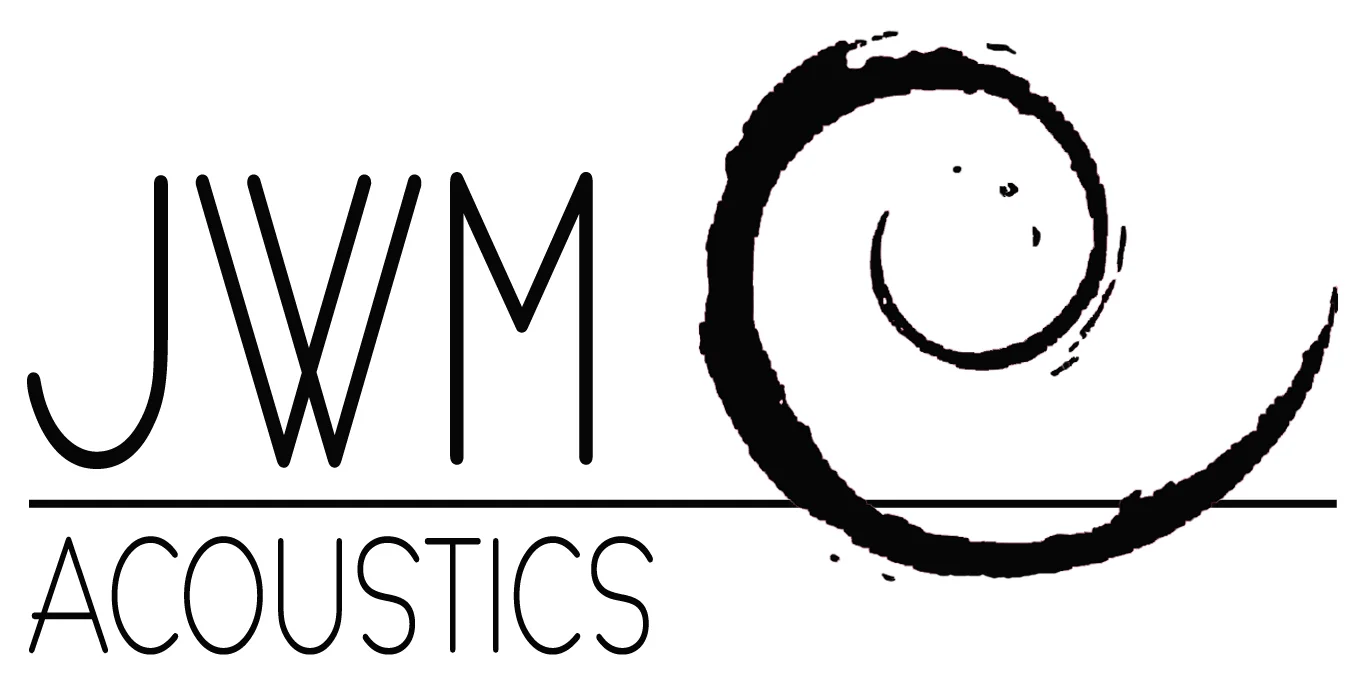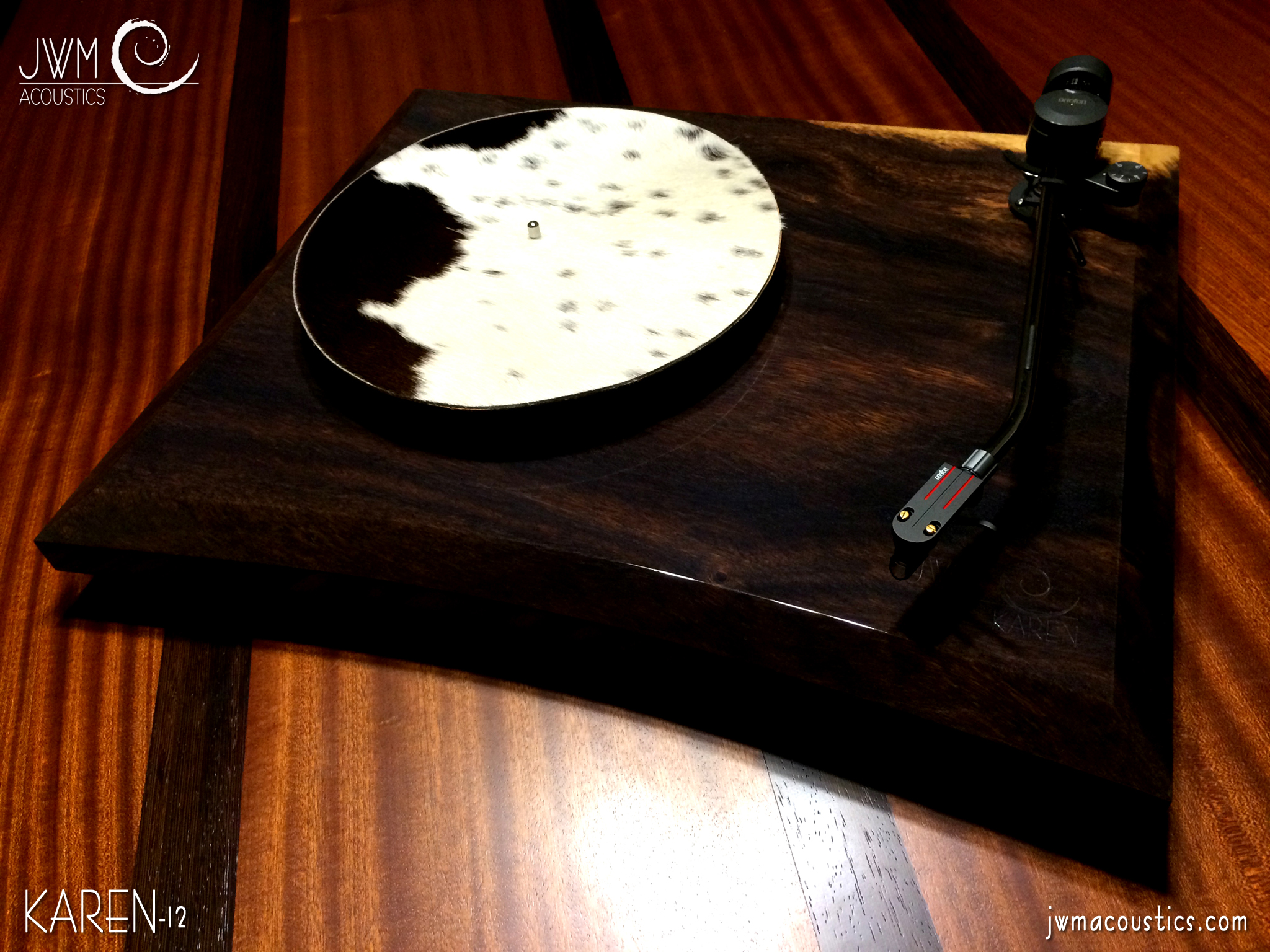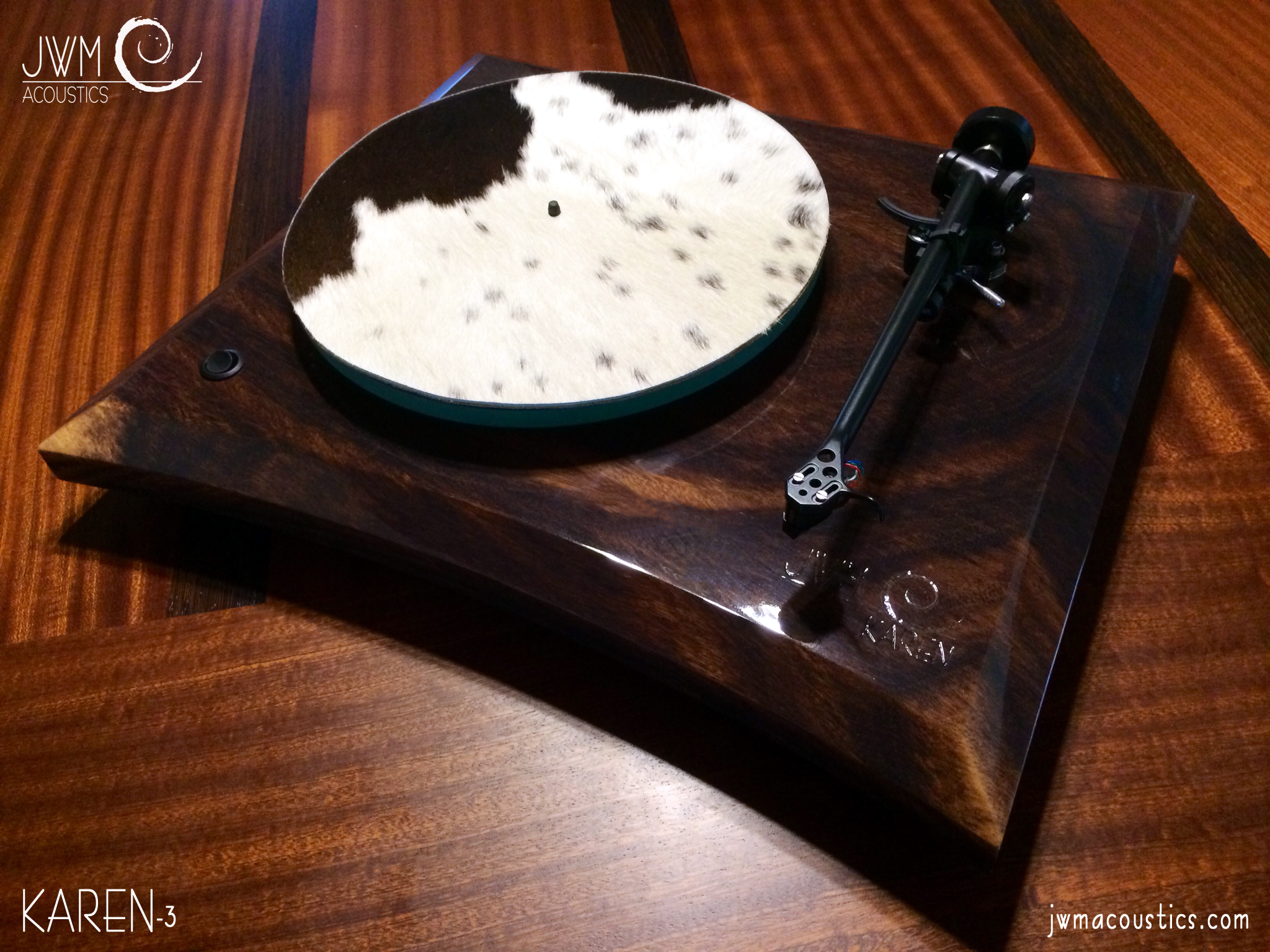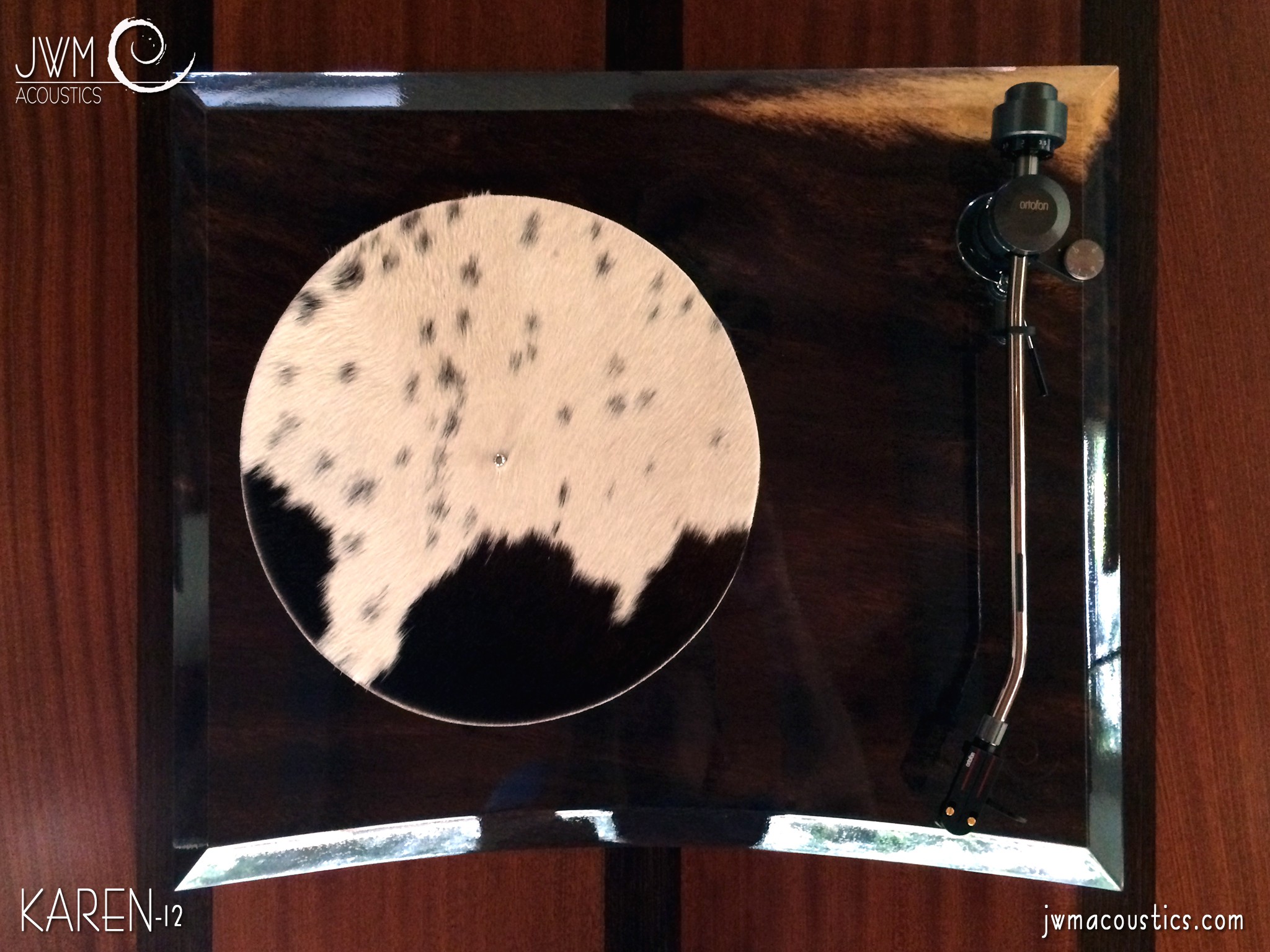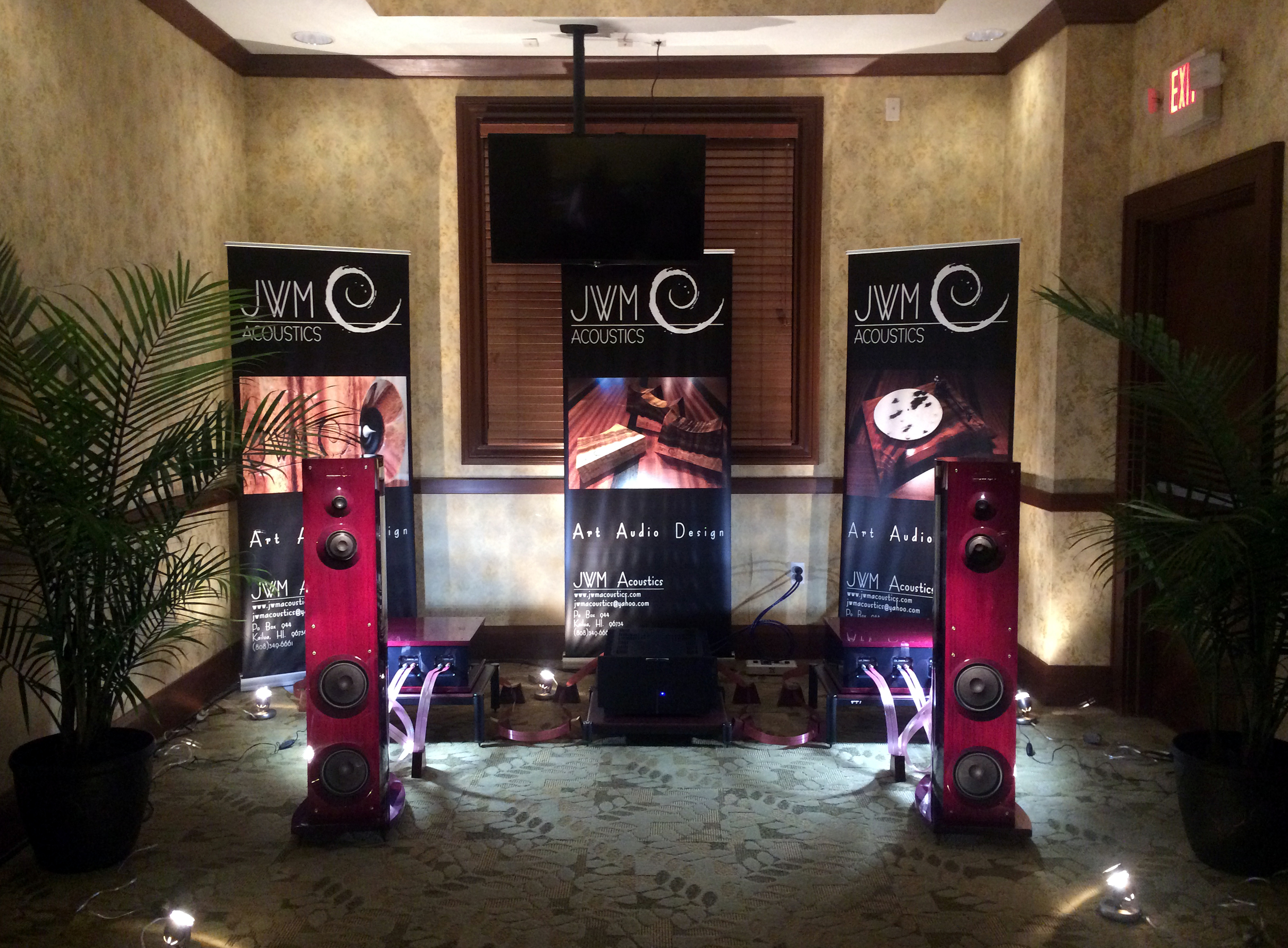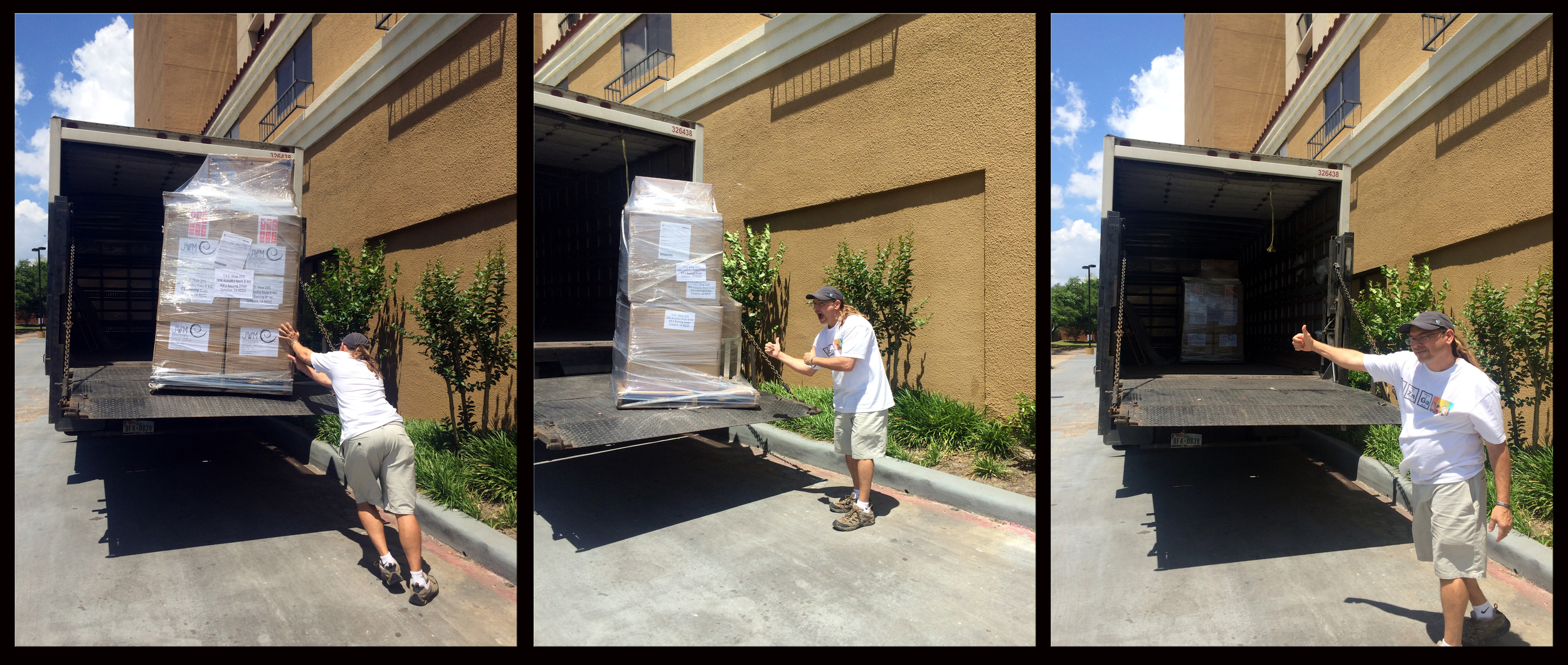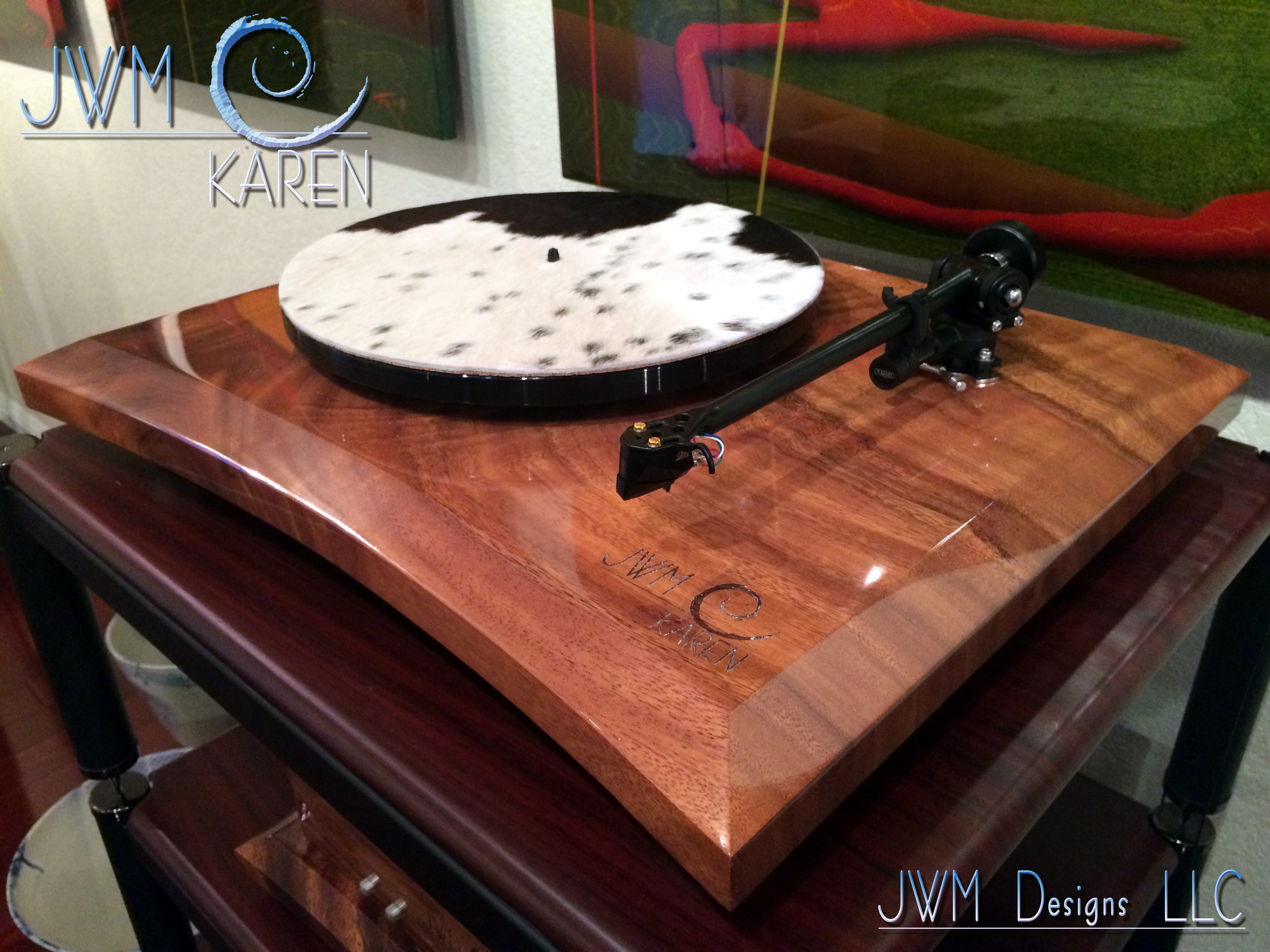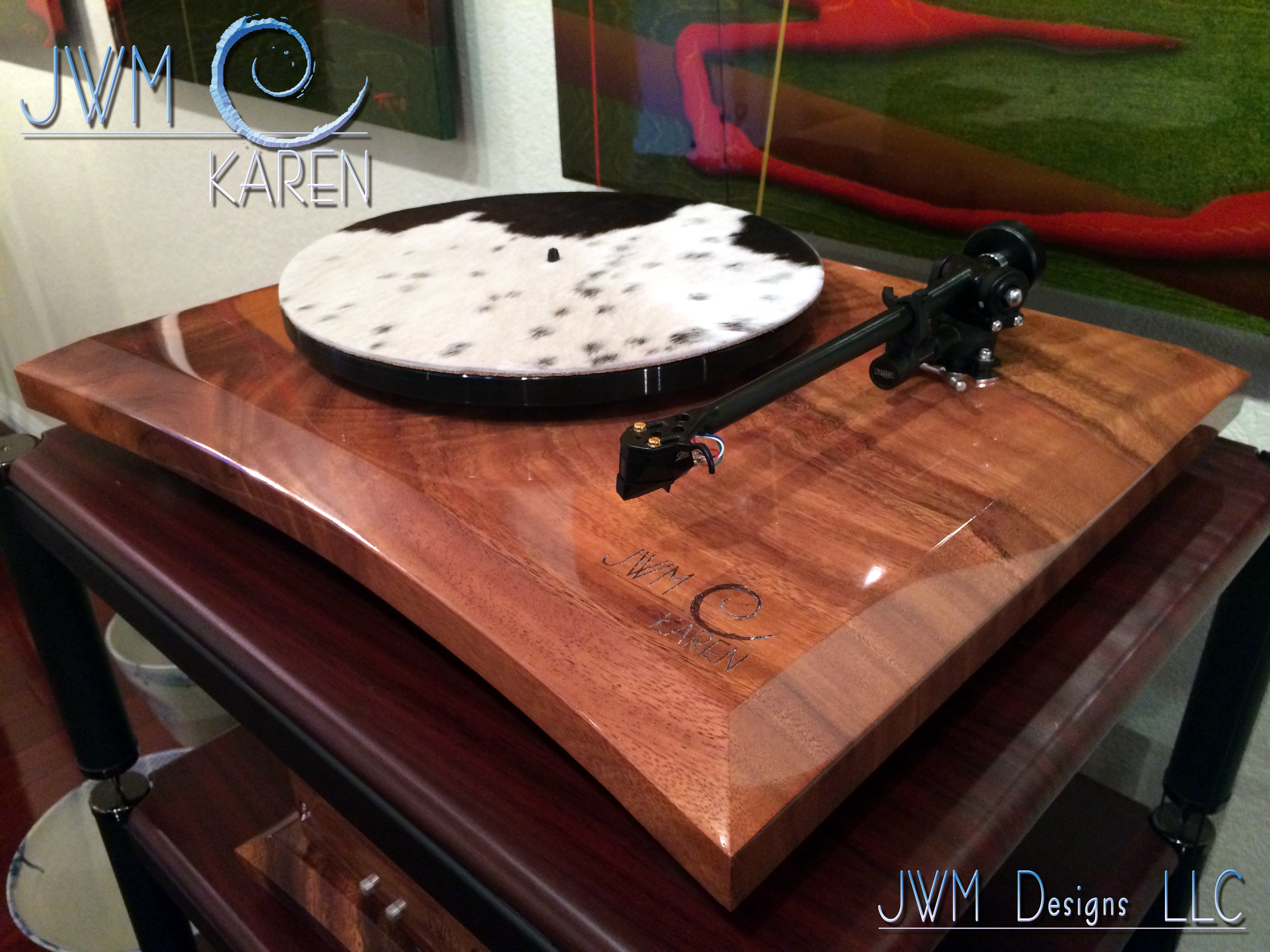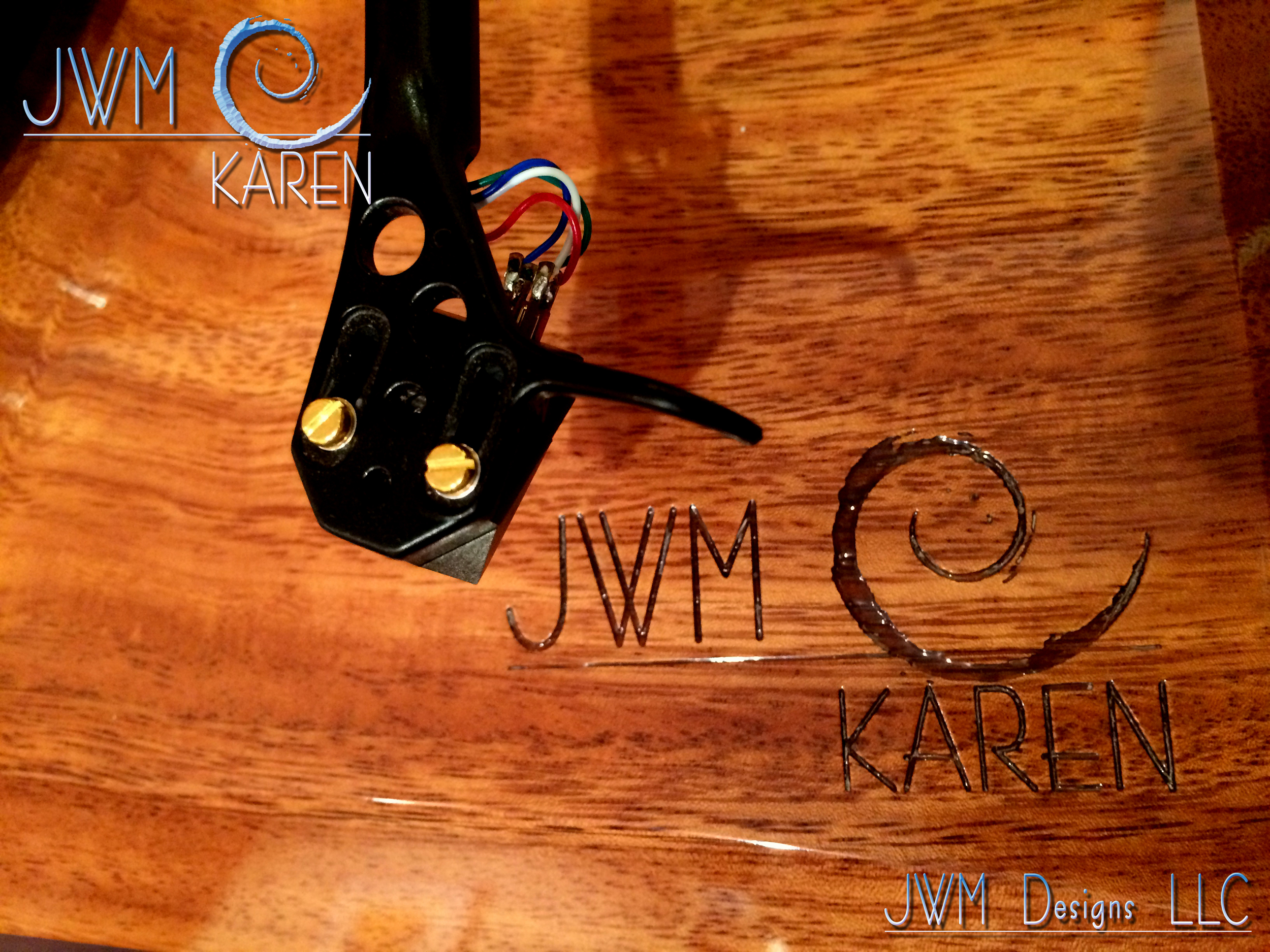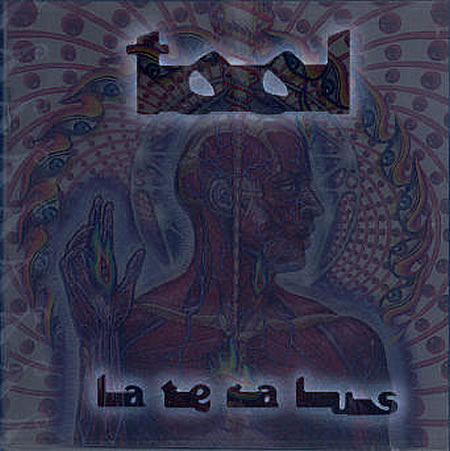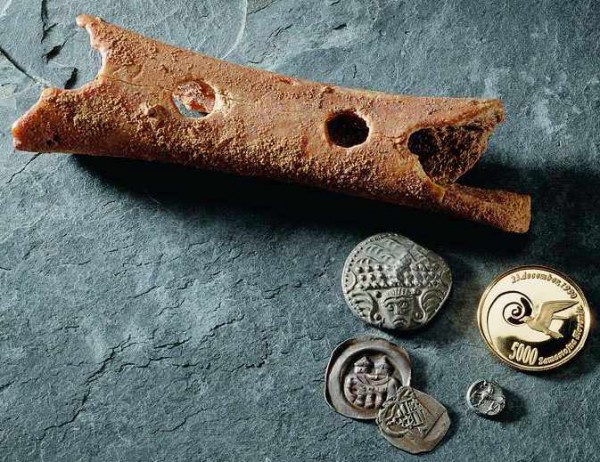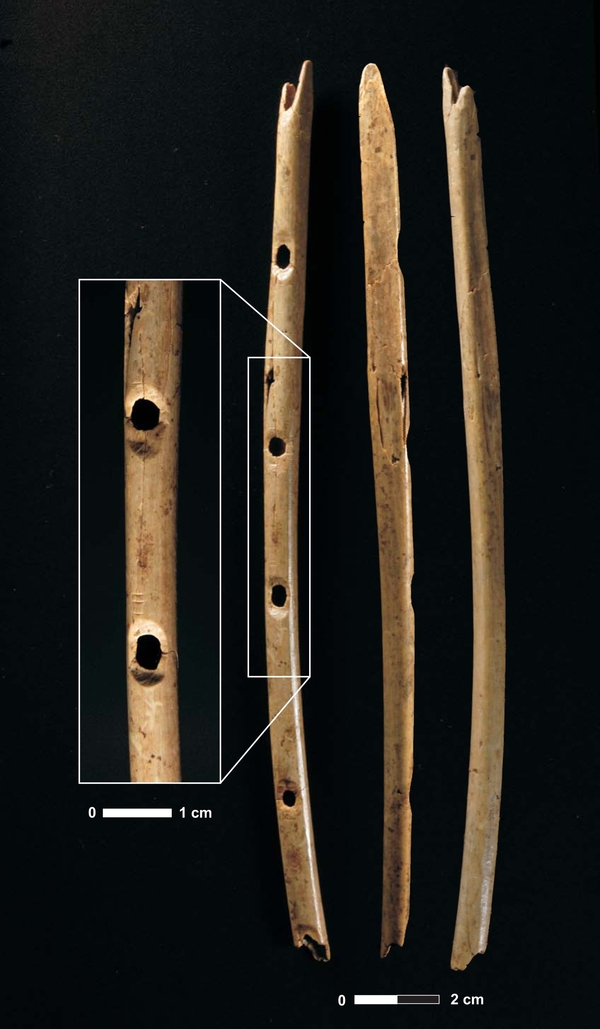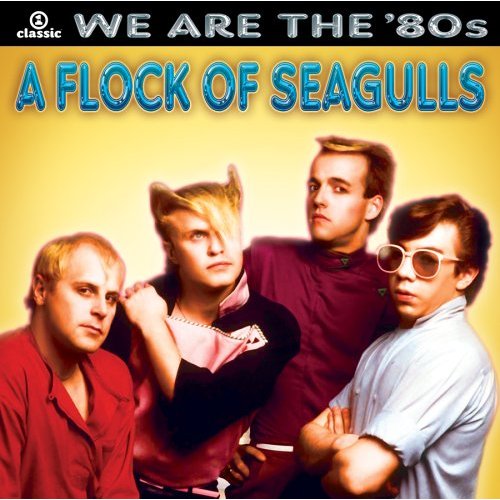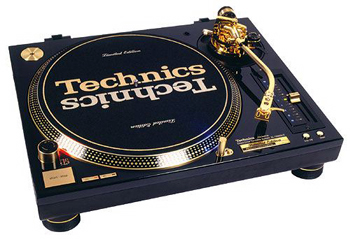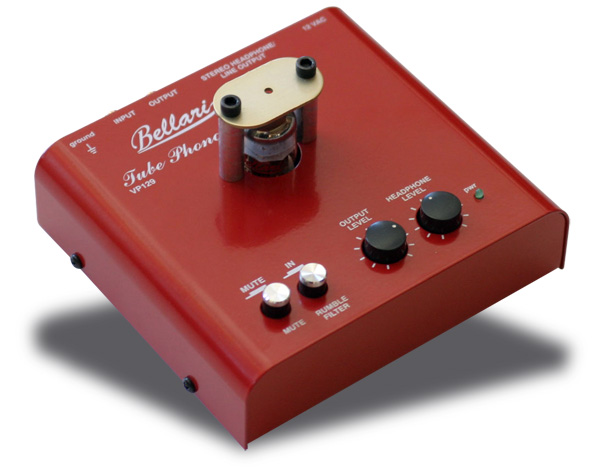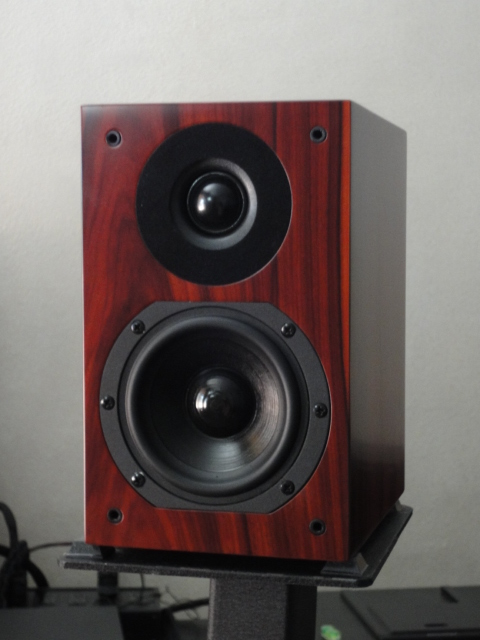https://youtu.be/-tvQbikGT54
Read moreIntroducing KAREN 12!
We proudly welcome the latest member of the JWM Acoustics family!
Karen 12
About a year and a half ago we introduced the KAREN series of turntables and accessories. A series driven by the quest for a sound almost forgotten from my youth. Since then, it has become the most popular product at JWM Acoustics.
In May of 2015, JWM Acoustics introduced the KAREN 3 at Lone Star Audio Fest. A hand built, solid wood turntable based on the REGA platform. Completely designed and manufactured in Hawaii. The idea was to show people that our $1,500.00 turntable could easily perform with tables 3 times the cost. And we did.
Later that month at T.H.E. SHOW NEWPORT we introduced the next step, KAREN 6. A $2,400.00 analog solution that floored each show goer who entered the room. All agreed that this table pushed way above its price range and had little to no competition in this range period. A constant stream of show goers agreed. In only a few months, this table has now built its own cult following. From the solid handmade hardwood plinth, to the hand tuned power supply it is not hard to see why.
Now, once again, we decided to take KAREN to the next level. An all new concept with parts sourced from all corners of the globe. A collaborative piece that represents our finest table yet. In October 2015 at the Rocky Mountain Audio Fest you will see and hear what is possible when things are made to be simple, by hand and purpose driven.
Beautiful, Elegant, KAREN 12
The KAREN 12 plinth is made from a single large and rigid piece of wood. Alone it weighs 30lbs. The KAREN 12 is indeed a large turntable with a tremendous amount of mass for its size. As with all the tables in the KAREN series, the edges are cut at a specific angle to reduce surface vibration. The original vibration damping shape of the KAREN design has been also utilized here, but to larger scale bringing the noise floor even lower than previous models. The signature curved front also serves a purpose in diffracting internal vibrations.
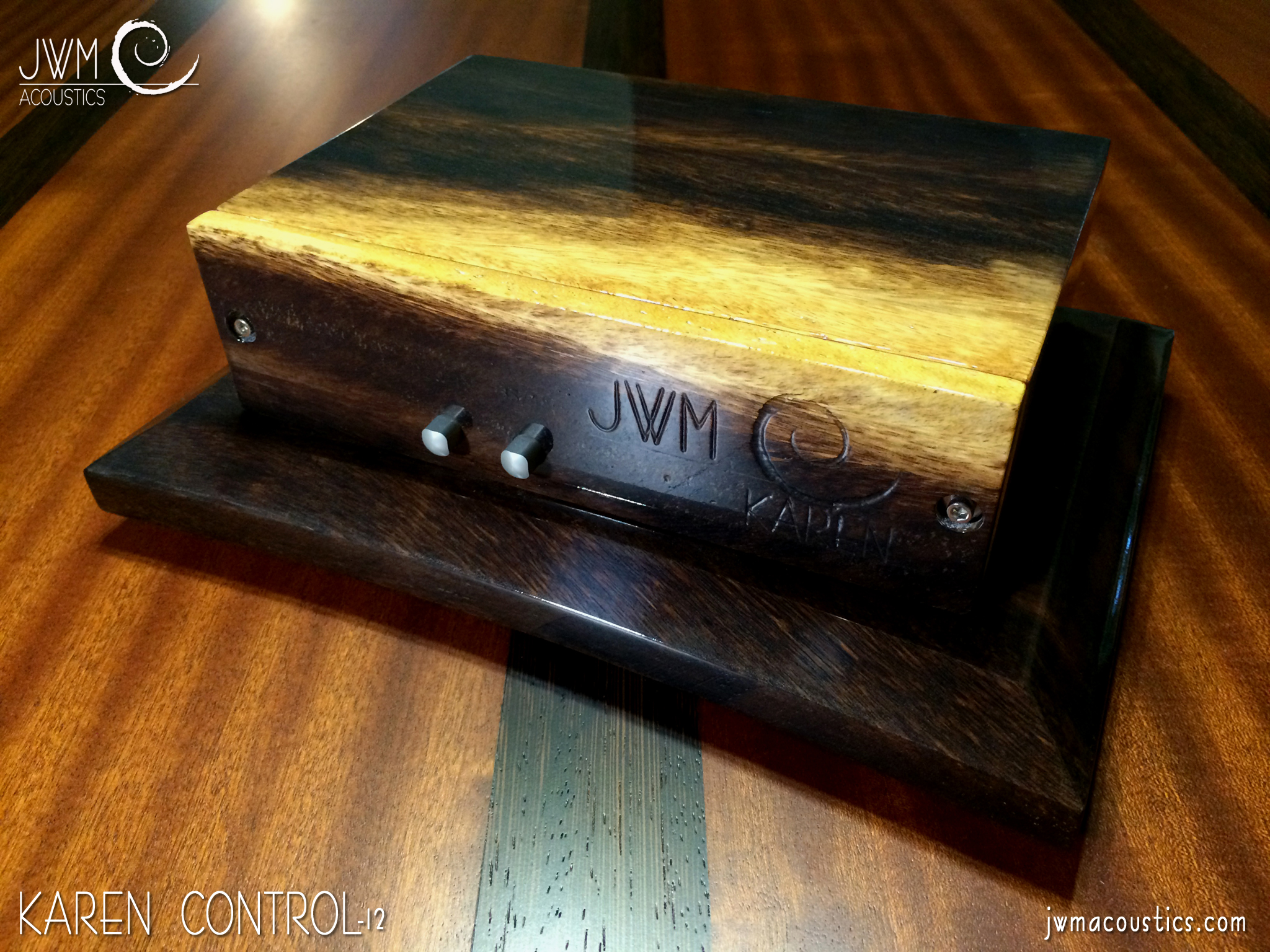 As with the KAREN 6 we addressed the motor and controller in the usual JWM Acoustics manner. With further simplifications and refinement to the vibration damping mechanism and power consistency, we have increased the accuracy and dropped the noise floor even further for the entire table. The motor and electronics are recessed into the underside of the table and treated to isolate from the bearing assembly and quiet the table further.
As with the KAREN 6 we addressed the motor and controller in the usual JWM Acoustics manner. With further simplifications and refinement to the vibration damping mechanism and power consistency, we have increased the accuracy and dropped the noise floor even further for the entire table. The motor and electronics are recessed into the underside of the table and treated to isolate from the bearing assembly and quiet the table further.
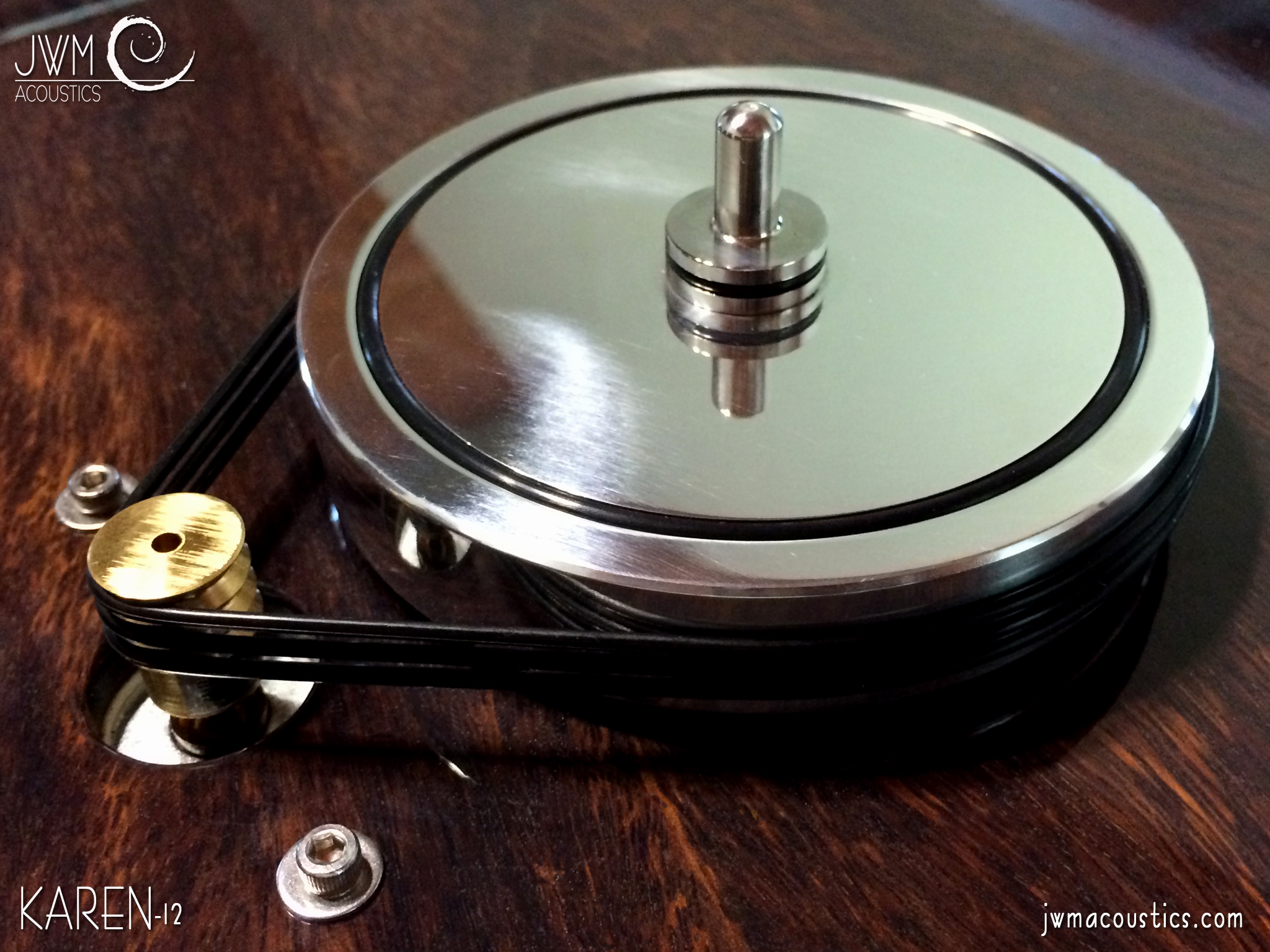 The bearing assembly, sub-platter and spindle has also been addressed with a handmade system sourced from Argentina and built by Tango Spinner. This polished drive mechanism and bearing has extremely tight tolerances and has proven to add accuracy, pace and depth to the presentation. The three belt pulley system provides copious amounts of torque and drives the two layer glass platter sourced from REGA with command.
The bearing assembly, sub-platter and spindle has also been addressed with a handmade system sourced from Argentina and built by Tango Spinner. This polished drive mechanism and bearing has extremely tight tolerances and has proven to add accuracy, pace and depth to the presentation. The three belt pulley system provides copious amounts of torque and drives the two layer glass platter sourced from REGA with command.
The stock arm for the KAREN 12 was carefully chosen to extend the same powerful signature sound the KAREN series is becoming known for. We chose the ORTOFON TA-210 12” static tonearm. We feel this arm/table combination possesses an elegant balance between analytical and soulful. Paired with most any cartridge on the market and you have a machine that will bring musical bliss to your home for many generations to come.
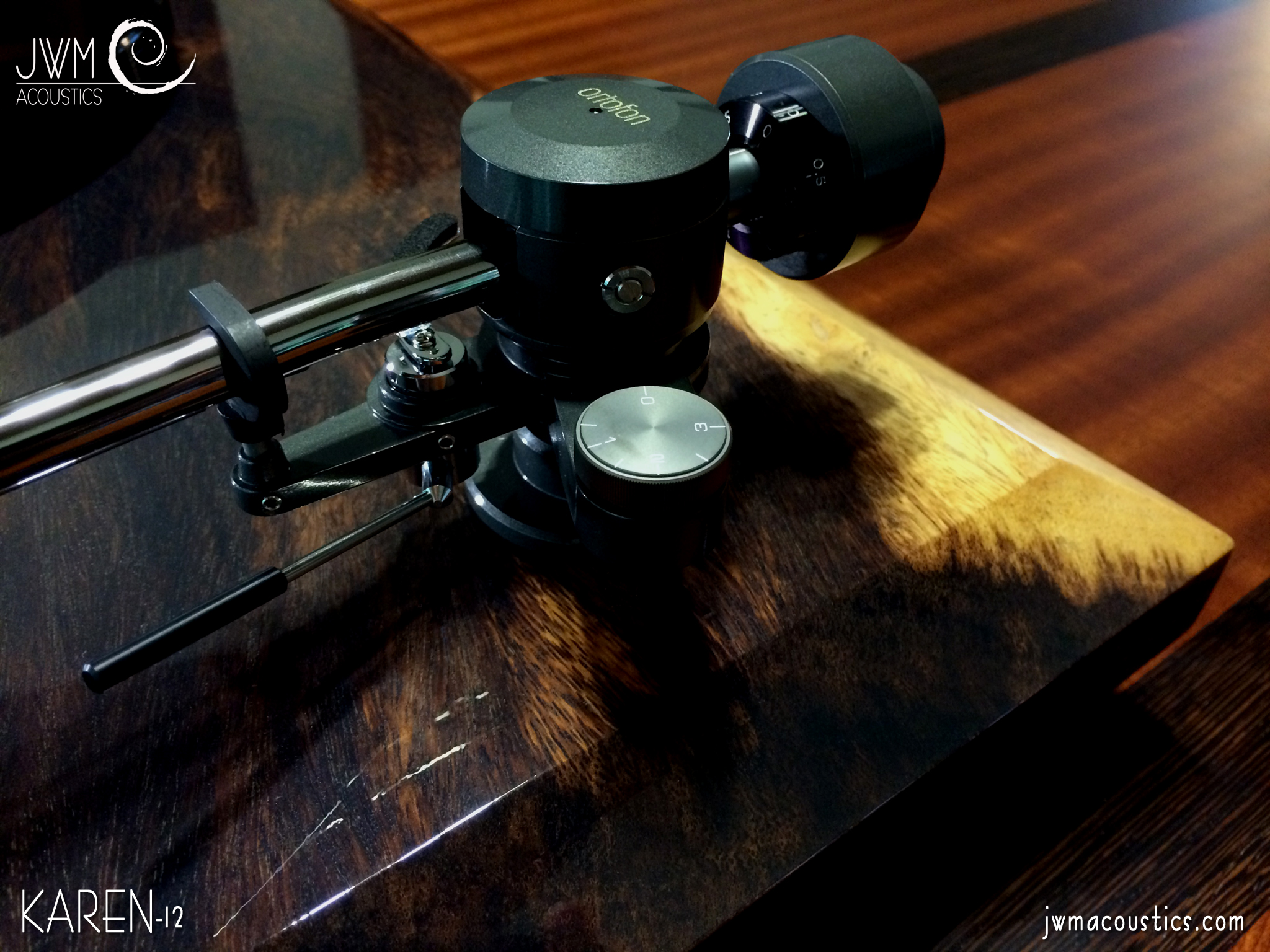 As with all JWM Acoustics products, you may customize your KAREN 12 to suit your own tastes. We have a large assortment of woods and finishes to choose from as well as the desire to build your dream table exactly as you wish. Should you have an idea for something you don’t see on our website, feel free to ask if we can custom tailor your deck for you. It’s what we do.
As with all JWM Acoustics products, you may customize your KAREN 12 to suit your own tastes. We have a large assortment of woods and finishes to choose from as well as the desire to build your dream table exactly as you wish. Should you have an idea for something you don’t see on our website, feel free to ask if we can custom tailor your deck for you. It’s what we do.
 We are taking pre-orders for the KAREN 12 now, so feel free to contact us for further details, or a consultation on what we can do for you. We truly believe this playback machine will breathe a new life into your collection and reveal even more information locked in the grooves of every record you play. The KAREN 12 and her sisters should be on your short list of new tables to hear and we can’t wait to share them all with you.
We are taking pre-orders for the KAREN 12 now, so feel free to contact us for further details, or a consultation on what we can do for you. We truly believe this playback machine will breathe a new life into your collection and reveal even more information locked in the grooves of every record you play. The KAREN 12 and her sisters should be on your short list of new tables to hear and we can’t wait to share them all with you.
Please join us in October for Rocky Mountain Audio Fest as we introduce the newest member of the JWM Acoustics family.
Beautiful, Elegant, KAREN 12
JWM
Final Thoughts On THE SHOW Newport 2015: "There's no place like home. There's no place like home". Closing words.
Sorry it has been a while. Spending time with my wife and dog has been top priority since returning from California. There is no substitute for family, big comfy beds and snuggle time. Ahhhhh…
Folks, let me tell ya. I have had some great times and I have had some REALLY great times. Without a doubt, THE NEWPORT SHOW 2015 will absolutely be filed in the REALLY great times folder.
First off, I have some thank ya’s to hand out. Not small ones either. BIG MONSTER ONES!
Mom, I can’t tell you enough… Mitch and Rece (our new California team!!!) We love and adore you. Many mahalos for everything. Michael Koetsier from GreenHIFI.com , for the awesome chat about green and sustainable audio. Alun Yun from Silverline for the smiles and friendly listening session. Peter Hansen from Synergistic Research for just being a nice guy. (I’ll giv’m a shot before RMAF!) Rick Vides from Brooks Berdan for being a great hall mate and the fun, but short chat about the state of the industry. Mark Freed, I will certainly heed your advice and also see you in Chicago next year! Paul Mah!!! What a great time I had talking with you! I appreciate all your words and look forward to more of them in the future.
To you Mr. Reichert of Stereophile Magazine. Read here. “I’ll take hearts and stars all day long”! I can’t thank you enough for the amazing words in the Reichert Report. The description you used, “Luscious detail” nailed it. There is a secret place that exists somewhere near laser detail and a true warm live experience. We hope to bring each and every music lover into this place.
Your report brought smiles to my wife and I and a tear to the eye of my amazing Mom. The time you spent in our room was above and beyond. For a new guy on the scene, it means the world. You certainly have a new fan out here on the islands and I look forward to reading more from you in the future.
Sasha Matson of Stereophile Magazine! Read here. Your description of the sound coming from the ALYSON AML as “very full-range, with a burnished warm dimension to the sound” is EXACTLY what we are aiming for. Being accurate to the source does not mean that one needs to have laser beams aimed at their ear drums. Nor does it mean the need for 8 foot tall cabinets full of huge drivers. Especially for the recording engineer who must sit in front of monitors for 8 hours a day. Our speakers may have a pedigree that originated in the studio, but we feel that taking the studio-to-home approach in speaker design is working beyond our greatest expectations.
Also, Thank you for recognizing the “hard work” that goes into hand crafted equipment. I for one, never want to see “Hand Made” disappear. The art of building speakers, turntables and other pieces in our shop is taken extremely serious. Except for the machine we use to burn in our logo, no CNC is used at this point and we will hold out as long as we can. If one is to spend so much time and expense seeking out that perfect piece of equipment for their musical passion, it should have all of the same attention to detail as a fine piano or cello. After all, should it not last for as many generations as well?
A giant Aloha and thank you to Michael Koetsier of GreenHIFI.com Read here. I can’t thank you enough for the write up on GreenHIFI.com! Although we are not perfect stewards of the planet, by golly we are trying. My wife Jeanette and a few of her friends, including the amazing furniture maker Thorbin Wuttke, have truly influenced us over the years. They have made us aware of the simple things that anyone can do yet few bother to put in motion. For instance, saving our sawdust for the local farmers. We also create accessories such as Cable Cradles and turntable record clamps from the smaller cutoffs in the shop rather than discarding them. In addition we collect small scraps from other wood workers to be repurposed. As JWM Acoustics grows, we will continue to implement conscience practices to balance our production.
If you are ever interested in how we offset our audio material use by planting trees and donating to the Hakalau Forest Reserve, look me up and I will be happy to elaborate.
Again Michael, thank you and mahalo for the mention and for recognizing our effort towards sustainability. Being green does not require that we compromise quality on the quest for perfect sound. For us, the two just work together. Simple as that.
Last, but most certainly not least. Many, many mahalos to Robert Lee of Acoustic Zen Technologies. I won’t even try to tell you how our time together impacted me. Your kind words and encouragement are so special to me. The huge time you took in my room was above and beyond. The ensuing critique of my work I will cherish for many years to come. From afar and for many years, you have influenced my work and sound. Now, from in front of my own creation. Thank you from the bottom of my heart. I hope to see you again soon. And yes! I too hear the wood in the instruments when played on my speaker systems. I assure you, it was no accident. THANK YOU again Mr. Lee!!!
So many more deserve my MUCHO MAHALO! You know who you are, so hugs!
We arrived early on Tuesday. We had hoped to get into 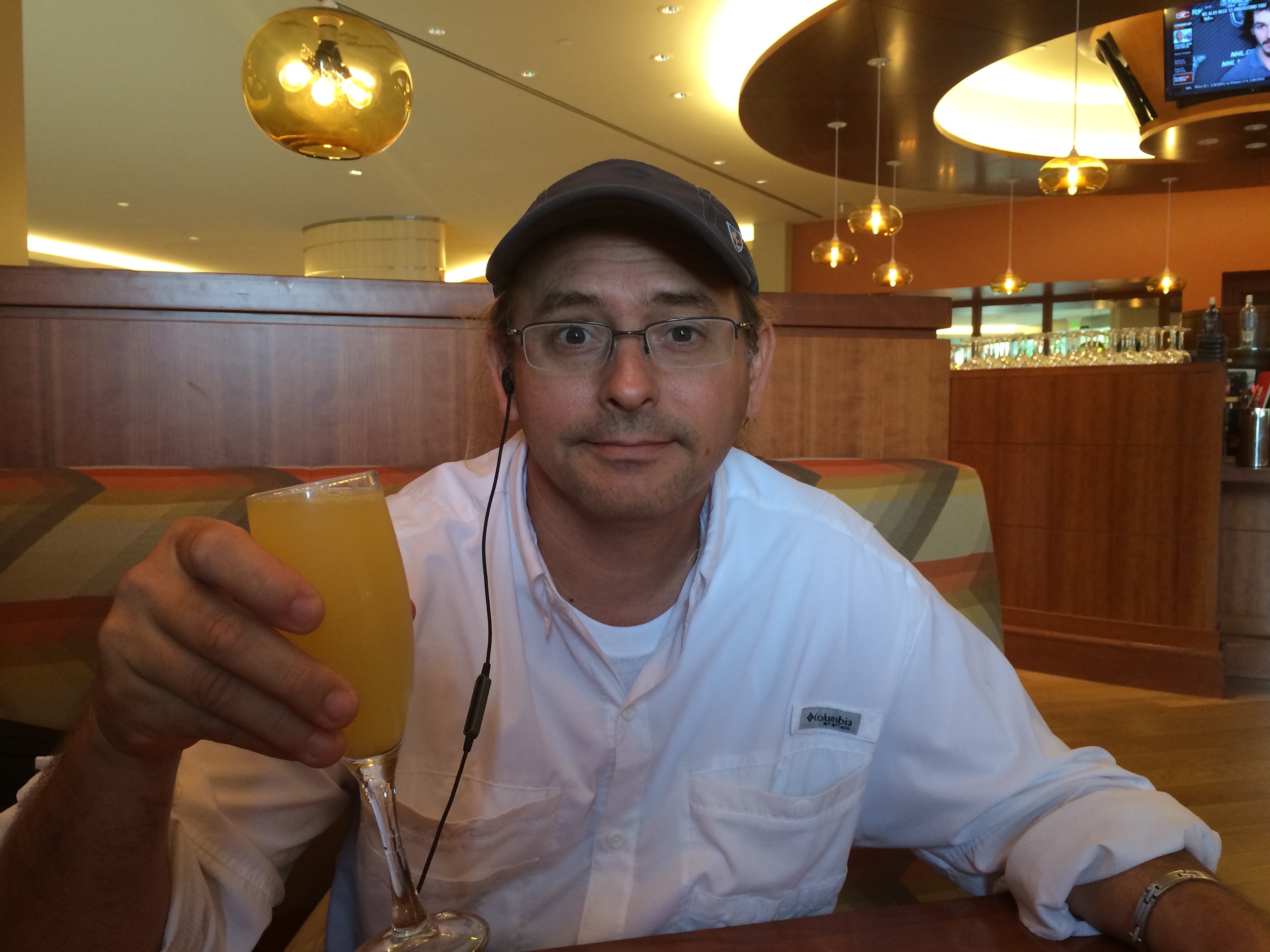 the rooms early enough to get started with setup and perhaps rest after the long flight from Hawaii. Mom flew in from Texas, but still, not a short hop. Unfortunately, the hotel made it clear that running behind was the theme of the day and we may not get our room until that evening. “OUCH”! Well, no matter. We ended up in the fine restaurant in the hotel lobby. We set up a computer and proceeded to stuff ourselves with pancakes, eggs Benedict and mimosas. I got to tell ya, that was some good Eggs Benny. The mimosa, not so much. It did hit the spot though.
the rooms early enough to get started with setup and perhaps rest after the long flight from Hawaii. Mom flew in from Texas, but still, not a short hop. Unfortunately, the hotel made it clear that running behind was the theme of the day and we may not get our room until that evening. “OUCH”! Well, no matter. We ended up in the fine restaurant in the hotel lobby. We set up a computer and proceeded to stuff ourselves with pancakes, eggs Benedict and mimosas. I got to tell ya, that was some good Eggs Benny. The mimosa, not so much. It did hit the spot though.
Fortunately, the ring came around 1:00 PM that our sleeping room was ready and we could check back around 3:00pm for our show room. It was sooooo nice to get a shower after traveling overnight. Nap time! Ahhhhhhhh…
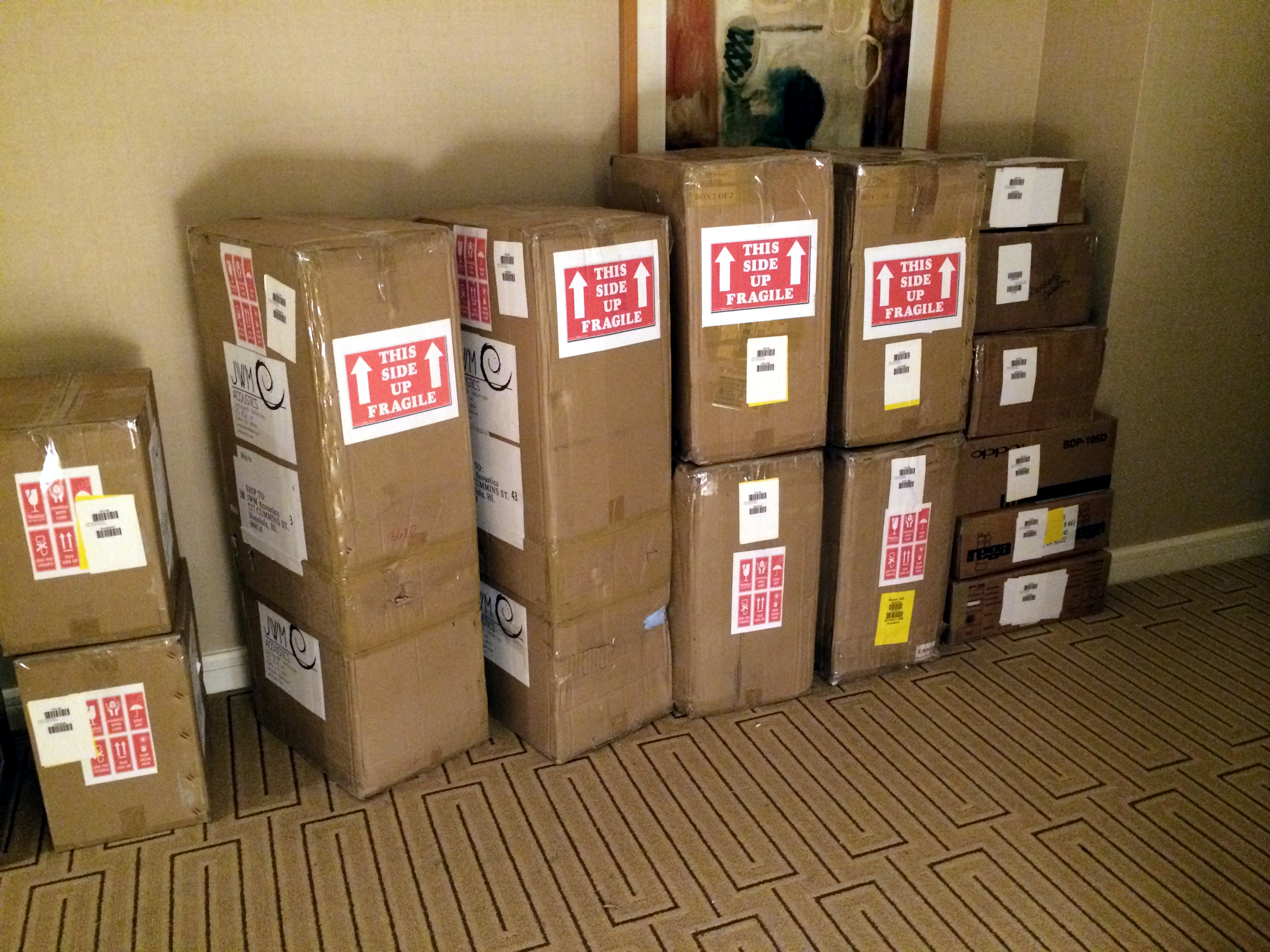 The equipment began to arrive and setup began around dinner time. We had the system up and running by 9:00PM. No small feat considering the amount of gear we were traveling with. Wednesday by noon, the dial in of the room was really coming along.
The equipment began to arrive and setup began around dinner time. We had the system up and running by 9:00PM. No small feat considering the amount of gear we were traveling with. Wednesday by noon, the dial in of the room was really coming along. First, we tried and tried to get the best staging possible with a wide frequency range using the JANE JKM. Over and over again, the speaker would either have one or the other, but never both. This speaker must have a large room to breathe in, but I really wanted to give people an idea of what she can do. By 10:00pm Wednesday night, the conclusion was made that I would be shooting myself in the foot by trying to show a speaker made for a room 10 times the size of this 13’X19’ shoe box. The decision to use the ALYSON AML and NET-1 as the primary speakers in the room was made. We left the JANEs in the room on static display. We did manage a few demos for select attendees, but they too agreed that the ALYSON was perfect in the room and I should let them sing. And boy did they sing!
First, we tried and tried to get the best staging possible with a wide frequency range using the JANE JKM. Over and over again, the speaker would either have one or the other, but never both. This speaker must have a large room to breathe in, but I really wanted to give people an idea of what she can do. By 10:00pm Wednesday night, the conclusion was made that I would be shooting myself in the foot by trying to show a speaker made for a room 10 times the size of this 13’X19’ shoe box. The decision to use the ALYSON AML and NET-1 as the primary speakers in the room was made. We left the JANEs in the room on static display. We did manage a few demos for select attendees, but they too agreed that the ALYSON was perfect in the room and I should let them sing. And boy did they sing!
 We also had two KAREN turntables up and running. One outfitted with one of my favorite cartridges, the Ortofon Windfeld, the other with the amazing Ortofon 2M Black. Using the new Balanced Audio Technology VK-P12 SE Phono stage, both carts sang like the wind. I am so happy to also announce that as of THE SHOW 2015, JWM Acoustics is now offering Ortofon cartridges as package deals on all of our decks! WoooHooo!!! By the way, the P-12 was so good we bought it…
We also had two KAREN turntables up and running. One outfitted with one of my favorite cartridges, the Ortofon Windfeld, the other with the amazing Ortofon 2M Black. Using the new Balanced Audio Technology VK-P12 SE Phono stage, both carts sang like the wind. I am so happy to also announce that as of THE SHOW 2015, JWM Acoustics is now offering Ortofon cartridges as package deals on all of our decks! WoooHooo!!! By the way, the P-12 was so good we bought it…
The BAT Phono stage was not the only BAT in the room. I was running the whole thing with the killer REX preamp. As usual, this preamp demonstrated that tubes may be neutral while still allowing for that perfect and lush vocal range we all love so much. I threaten to upgrade to the REX II almost weekly, but if it ain’t broke, why fix it? I’ll revisit the idea with Geoff Poor from BAT before the RMAF, but as it stands, this machine works beautifully in our reference room back on the island. It is nice to have a piece you can count on to deliver the goods, day in and day out. Stay tuned!
 The amp was also from BAT. The VK-655 SE was in the house and powering anything we threw at it with ease. You know, it is a brand new amp. Hardly any break in time, except for the LSAF and a few late night sessions at THE SHOW. Yet, it still manages to not sound constipated or rough! I was warned by BAT and a few show goers, that running this new machine could be a mistake, but I have to disagree. The combination of all of these pieces was stellar. The synergy with my speakers was heavenly to say the least. BUY THIS AMP!!! ESPECIALLY if a set of JWM Acoustics is in your future. Great combo…
The amp was also from BAT. The VK-655 SE was in the house and powering anything we threw at it with ease. You know, it is a brand new amp. Hardly any break in time, except for the LSAF and a few late night sessions at THE SHOW. Yet, it still manages to not sound constipated or rough! I was warned by BAT and a few show goers, that running this new machine could be a mistake, but I have to disagree. The combination of all of these pieces was stellar. The synergy with my speakers was heavenly to say the least. BUY THIS AMP!!! ESPECIALLY if a set of JWM Acoustics is in your future. Great combo…
I was never a big digital guy. Kicking  and screaming, I am being dragged into this world of Bips and Bops. I was finally convinced that I needed to load J River and begin the task of collecting files. So I did. The verdict is in. I like it. Yes I said it. I LIKE it. Don’t love it, LIKE it. There comes a time in every audiophiles life when he has to admit that one thing may be as good as another, or at least close. Horns verses electrostat. Maggies or Kings. MC or MM. 10101010111010001111000 or analog. I guess 10101010101100100101011000 now has a place in my living room alongside the record spinner. Just need another shelf for the DAC! Speaking of!!! The DAC for the show was the kick butt one in the OPPO BD105D! The files were being fed by my HP ENVY laptop. HOLY!!!!!! That be some good sound folks. If you have the budget for a DAC, do consider the all in one option with the OPPO. You will love it. It was nice to have the option to spin up some of the attendees discs when asked. We actually got to keep a few of them for our own collection! Thanks attendees!!!
and screaming, I am being dragged into this world of Bips and Bops. I was finally convinced that I needed to load J River and begin the task of collecting files. So I did. The verdict is in. I like it. Yes I said it. I LIKE it. Don’t love it, LIKE it. There comes a time in every audiophiles life when he has to admit that one thing may be as good as another, or at least close. Horns verses electrostat. Maggies or Kings. MC or MM. 10101010111010001111000 or analog. I guess 10101010101100100101011000 now has a place in my living room alongside the record spinner. Just need another shelf for the DAC! Speaking of!!! The DAC for the show was the kick butt one in the OPPO BD105D! The files were being fed by my HP ENVY laptop. HOLY!!!!!! That be some good sound folks. If you have the budget for a DAC, do consider the all in one option with the OPPO. You will love it. It was nice to have the option to spin up some of the attendees discs when asked. We actually got to keep a few of them for our own collection! Thanks attendees!!!
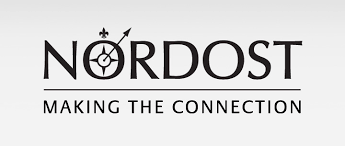 I can’t forget to mention the cables. Oh the cables. NORDOST was so kind to lend us some fantastic specimens for the last two shows and I can’t thank them enough. We had everything in the room from the Blue Heaven line, up to the Hiemdall II. And I must say. WOW. They just worked in this setup. Not only did people notice their quality, when I did a few demonstrations between levels of cable the distinction was unmistakable and stunning. If anyone tells you there is no difference in cables, invite them over to our reference room for a demo. ‘Nuff said.
I can’t forget to mention the cables. Oh the cables. NORDOST was so kind to lend us some fantastic specimens for the last two shows and I can’t thank them enough. We had everything in the room from the Blue Heaven line, up to the Hiemdall II. And I must say. WOW. They just worked in this setup. Not only did people notice their quality, when I did a few demonstrations between levels of cable the distinction was unmistakable and stunning. If anyone tells you there is no difference in cables, invite them over to our reference room for a demo. ‘Nuff said.
You know, I forgot to mention our cable cradles! More of 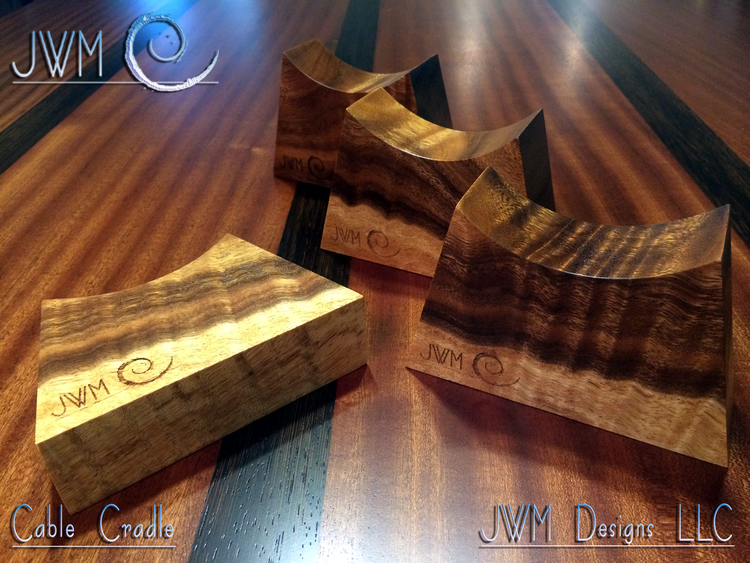 those little fellas walked out the door than I had anticipated! We sold them to the likes of D’Agastino, Silverline, even Mr. Lee from Acoustic Zen grabbed one because he liked the wood! Since getting home, all the rage is for NORDOST and other ribbon cable users to have a set of the Split Cable Cradles for their system! We love that! The Cradles started as a way to cut down on the waste in the speaker shop. We needed to find a way to utilize as much of our scraps as possible. Mostly because waste is not an option for us. We try to use every part of the tree. To have people embrace the idea as much as they are is wonderful! Even if you don’t believe in the sonic characteristics of lifting your cables away from statically charged floors, the organizational benefits of the cradles is fantastic! Thank you folks! We will make more for RMAF!
those little fellas walked out the door than I had anticipated! We sold them to the likes of D’Agastino, Silverline, even Mr. Lee from Acoustic Zen grabbed one because he liked the wood! Since getting home, all the rage is for NORDOST and other ribbon cable users to have a set of the Split Cable Cradles for their system! We love that! The Cradles started as a way to cut down on the waste in the speaker shop. We needed to find a way to utilize as much of our scraps as possible. Mostly because waste is not an option for us. We try to use every part of the tree. To have people embrace the idea as much as they are is wonderful! Even if you don’t believe in the sonic characteristics of lifting your cables away from statically charged floors, the organizational benefits of the cradles is fantastic! Thank you folks! We will make more for RMAF!
Well the show ended and it was time to pack up. Two of our best friends Mitch and Rece showed up just in time to begin the work. It took us until 3:00AM to pack it all up, but we did it! Oh man! We were beat. I crashed HARD!!! Honestly, as fun as this show was, I was so happy it was over. I definitely need the break before RMAF comes along. We certainly hope it draws the crowds we had at THE SHOW. So tell all your friends! Speaking of friends, we made some great ones. We had hundreds of people come through the room. I sincerely remember almost everyone that wanted to engage in conversation. Thank you all!
Thanks to all involved. We will see you next year! Now it’s time to build more stuff…
Josh
T.H.E. SHOW NEWPORT! On the road again!
Aloha Audiophiles! We are on the road again!
Well, for those of you who didn’t have a chance to make it to Lone Star Audio Fest 2015, you missed a great time. You also missed the first showing of our new design! The JANE JKM. Our flagship floor standing speaker and external crossover system. Don’t worry though, your next opportunity to see the JANE and several other products we build will be at T.H.E. SHOW Newport! That’s right! We are on the road again folks! May 29th-30th we will be rock’n the paint off the walls in room 443 at the Hotel Irvine!
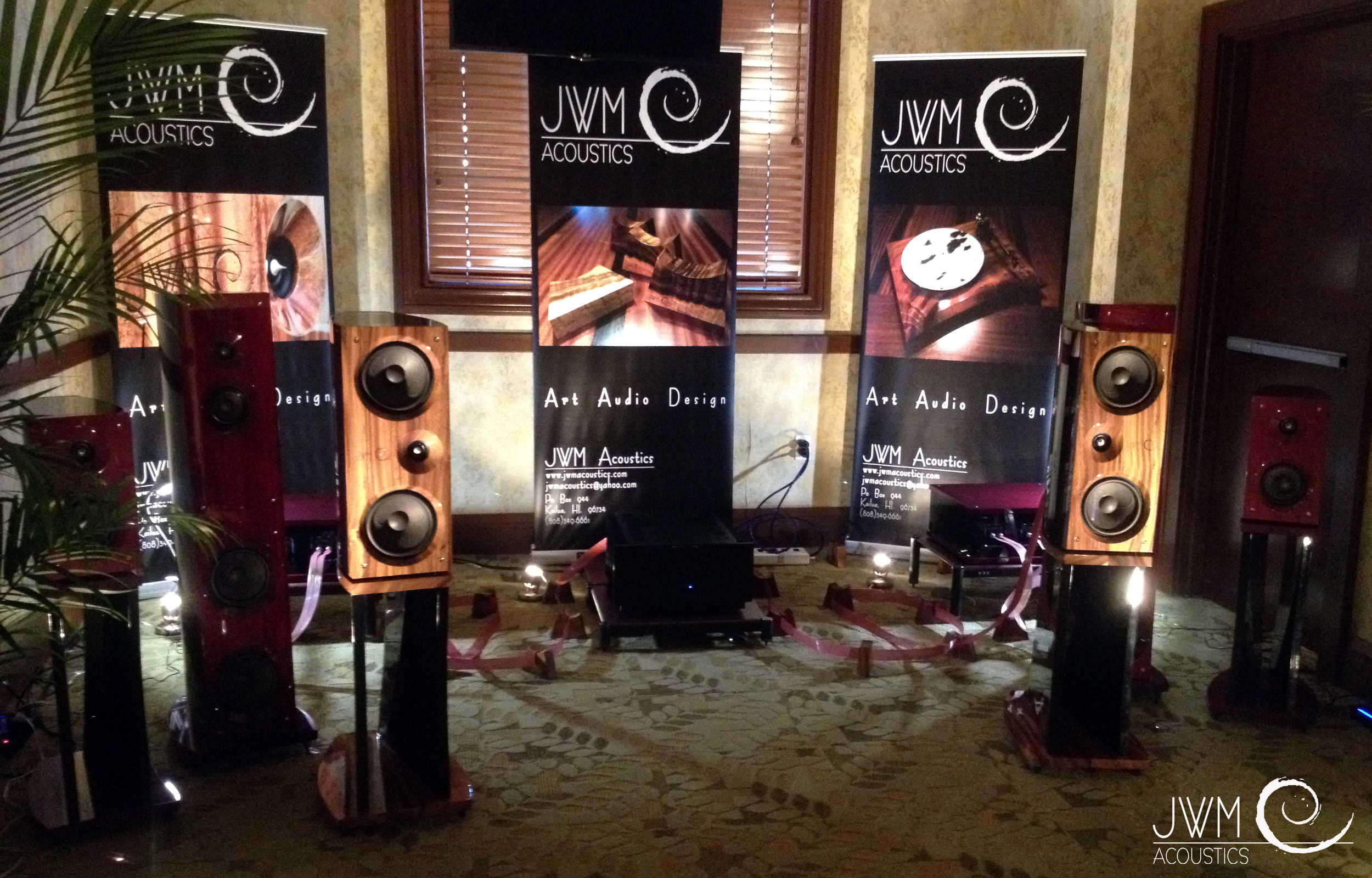 For T.H.E. SHOW, JWM has chosen to bring 3 sets of speakers. The NET-1 mini monitor, the ALYSON AML large monitor and the JANE JKM floor standing flagship. Also included in the collection will be the KAREN 6 and 3 turntables and several examples of HI-FI accessories including Cable Cradles in several wood species and sizes.
For T.H.E. SHOW, JWM has chosen to bring 3 sets of speakers. The NET-1 mini monitor, the ALYSON AML large monitor and the JANE JKM floor standing flagship. Also included in the collection will be the KAREN 6 and 3 turntables and several examples of HI-FI accessories including Cable Cradles in several wood species and sizes.
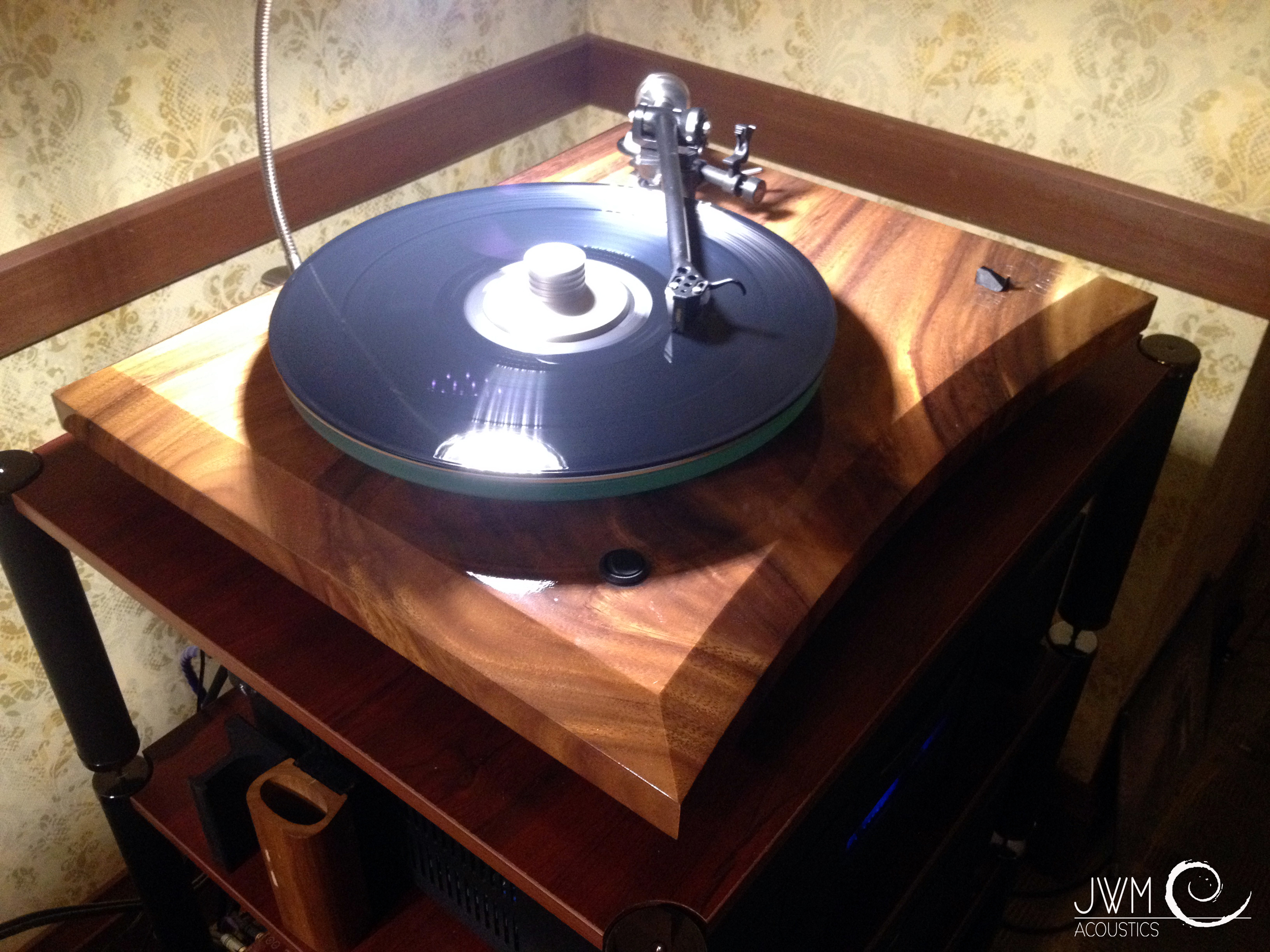 As before, We will be showing with a great system. We are proud to have names like Balanced Audio Technology, Nordost, OPPO and Ortofon in the room with us and we certainly plan on making a splash. If you care to join us, don’t hesitate to contact us, or simply show up and bring some tunes! We will have the ability to spin discs, files and of course vinyl so feel free to ask for a demo with the stuff you love to hear.
As before, We will be showing with a great system. We are proud to have names like Balanced Audio Technology, Nordost, OPPO and Ortofon in the room with us and we certainly plan on making a splash. If you care to join us, don’t hesitate to contact us, or simply show up and bring some tunes! We will have the ability to spin discs, files and of course vinyl so feel free to ask for a demo with the stuff you love to hear.
JWM Acoustics will be showing the following systems:
JANE JKM Floor stander and external crossover in Bubinga  ALYSON AML Large monitor in Monkeypod
NET-1 Mini monitor in Purple heart
KAREN 3 Turntable in Monkeypod
KAREN 6 Turntable and external power supply in Monkeypod
ALYSON AML Large monitor in Monkeypod
NET-1 Mini monitor in Purple heart
KAREN 3 Turntable in Monkeypod
KAREN 6 Turntable and external power supply in Monkeypod
In the racks we will be using the following system: 
Balanced Audio Technology REX Preamplifier
Balanced Audio Technology VK-P10SE Phono Stage  Balanced Audio Technology VK-6550SE Power Amplifier
OPPO BD-105D Digital player
Nordost Qbase Power distribution
Nordost Qv2 and QK1 Line conditioning Units
All the audio cables and power cables will be provided by Nordost
Balanced Audio Technology VK-6550SE Power Amplifier
OPPO BD-105D Digital player
Nordost Qbase Power distribution
Nordost Qv2 and QK1 Line conditioning Units
All the audio cables and power cables will be provided by Nordost  including examples of the Heimdall, and Lief lines.
including examples of the Heimdall, and Lief lines.
We will also be letting the entire system go at a fabulously low show price! You are welcome to inquire in the room and pick up a price list of all the components present. Also, we will be giving a show discount on all products on our website until the end of June! Just enter the code THE SHOW at checkout for a full 20% off your entire shopping cart!
We truly hope to see you all in Newport and really wish to show you what has been happening to High End Audio out here in the islands!
Aloha!
Joshua W. Miles
Lone Star Audio Fest 2015! Mama said there would be days like this...
Before I even begin, let me thank Steven Solazzo for all his efforts with LSAF! Great work man! Additionally, I’m not sure who took all the images in this post but certainly much credit goes to Kelly Parham, wife and obviously cuter half of Wayne Parham and PI Speakers! What a pleasure it was meeting you folks! Mucho mas aloha as well to Dave and Gabrielle Thomson. You two are an inspiration and we hope to see you again soon. OK OK. There are more credits to give out including those earned by my family and friends, but you know who you are. A big hug to all of you! Onward!

Mama said there would be days like this…
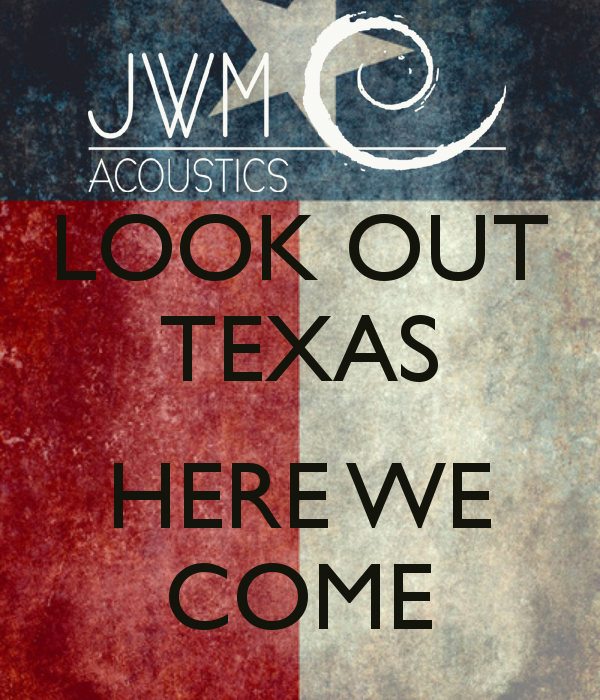 Then she told me those days would be followed by ones filled with amazing music, art, people and libation. That is exactly what Lone Star Audio Fest was. I can’t tell you enough how wonderful this little known show is. With a little word of mouth and a lot of commitment, this humble show will become something huge one day. Or not! Frankly, this show is one of those things that file neatly into the “Ain’t broke, don’t fix it” category.
Then she told me those days would be followed by ones filled with amazing music, art, people and libation. That is exactly what Lone Star Audio Fest was. I can’t tell you enough how wonderful this little known show is. With a little word of mouth and a lot of commitment, this humble show will become something huge one day. Or not! Frankly, this show is one of those things that file neatly into the “Ain’t broke, don’t fix it” category.
This show was a first for us. With the prodding and encouragement of our friends, family and clients it was time to take our products on the road. What better place to do it than back home in the state where it all began for this little company? TEXAS! I had heard about LSAF on a few forums and web pages, but had never attended. When I saw that RAVEN AUDIO, a company based in Texas whose growth I had been tracking with keen interest for quite some time, was making an appearance at this little show I knew I had to look into it.
 I wrote letters to Dave Thomson, the owner or RAVEN AUDIO, Steven Solazo who for all intents and purposes, runs the show, and reached out to a few others who had attended in the past. As the show approached the LSAF social network began to grow and come alive. It started to become clear that LSAF was not just another audio show. This was more like a family of music lovers, gearheads and deep audiophiles, who have found a place to share their love and art. I say art, for more than half of this community of geniuses is DIYrs! Not your run of the mill garage type.
I wrote letters to Dave Thomson, the owner or RAVEN AUDIO, Steven Solazo who for all intents and purposes, runs the show, and reached out to a few others who had attended in the past. As the show approached the LSAF social network began to grow and come alive. It started to become clear that LSAF was not just another audio show. This was more like a family of music lovers, gearheads and deep audiophiles, who have found a place to share their love and art. I say art, for more than half of this community of geniuses is DIYrs! Not your run of the mill garage type. We are talking the upper crust here folks. For anyone who thinks that the HIGH END needs to come with a gold plated logo and genuine Corinthian leather baffle, think again. Get in the car, plane or train and high tail it to this show next year. You will be floored and maybe a bit upset that those $40,000.00 leather speakers you bought last week don’t measure up! HEHE...
We are talking the upper crust here folks. For anyone who thinks that the HIGH END needs to come with a gold plated logo and genuine Corinthian leather baffle, think again. Get in the car, plane or train and high tail it to this show next year. You will be floored and maybe a bit upset that those $40,000.00 leather speakers you bought last week don’t measure up! HEHE...
 I was a bit concerned at first, for the talk on the web and forums were inconsistent. One week the chatter was loud and colorful, the next it was gone. For a small company like ours, this is not very comforting. We have a long way to travel from our home base in Hawaii and 2,000lbs of speakers, turntables and heavy equipment don’t travel cheap. “Will anyone be there”? “Is the show still a go”? Only a few of the questions I kept posing to the groups and to the community at large. I never got a clear answer actually. But what the heck! Even if not a single soul was to show up, WE WOULD! For us, this show would have to become a dry run for the next few shows we have on our schedule. Test run if you will. This was a chance to weed out what we would need for the next bigger and more published audio shows. Time to polish up! As for our concerns of attendance, that most definitely was not an issue…
I was a bit concerned at first, for the talk on the web and forums were inconsistent. One week the chatter was loud and colorful, the next it was gone. For a small company like ours, this is not very comforting. We have a long way to travel from our home base in Hawaii and 2,000lbs of speakers, turntables and heavy equipment don’t travel cheap. “Will anyone be there”? “Is the show still a go”? Only a few of the questions I kept posing to the groups and to the community at large. I never got a clear answer actually. But what the heck! Even if not a single soul was to show up, WE WOULD! For us, this show would have to become a dry run for the next few shows we have on our schedule. Test run if you will. This was a chance to weed out what we would need for the next bigger and more published audio shows. Time to polish up! As for our concerns of attendance, that most definitely was not an issue…
Setup begins: We were a bit concerned at first, for one of our pallets looked like it had been pushed out of the plane from 30,000 feet into the parking lot of the hotel. Perhaps to save on fuel? Well, it turns out the damage was only minor and was not going to be an issue sonically. Lacquer can be re buffed. For our first show, I think we did OK on time when it comes to unpacking and setup. For the next few shows, we will clearly need to tidy up this part.
We were glad to have booked the room 2 days before the opening of the show because we ran into a few issues that nearly had us a “NO SHOW”. While tuning the room, Our Phono stage suddenly lost a channel. NOOOO!!!! Early birds were already entering the room for listening sessions and our finest KAREN 6 Turntable was dead in the water. Luckily, we had a second entry line KAREN 3 already setup with a small MM phono stage to take up the slack for the day. My hat’s off to Balanced Audio Technology. I got Geoff Poor on the horn. He immediately got me on the line with the gentleman who built the amazing VK-P10SE Phono stage, Victor Khomenko. He walked me thru a series of diagnostics to determine the cause of the lost channel. The conclusion was a power supply issue that could not be fixed on the spot. OUCH! BUT WAIT! The next morning, waiting at the front desk was another Phono stage sent overnight! Now you tell me, have you ever had customer service like this? Have you been put on the phone with the designer of any piece of equipment that is down for the count? Have you had a replacement waiting for you before you could finish your breakfast bagel at the hotel restaurant? BUT WAIT! THAT’S NOT ALL! The hotel had a surge that killed the left channel in the brand new VK-6550SE amp we are showing with as well! WHAT?!?! One more call to Victor and that problem was solved in about 5 minutes as well! “HOLY BLOWN FUSES BAT MAN”! Again, I can’t tell you what it means to a little company like ours to have support from a big company like Balanced Audio Technology. Thank you BAT!!!
Remember the part about “Mama said there would be days like this”? Boy howdy, was that one. Thank goodness Mama was right about the following as well… those promised days filled with amazing music, art, people and libation! That is exactly what LSAF was. My wife Jeanette and I met some of the coolest folks over this long weekend. We would name them all here, but my long windedness would become tiresome quickly if hasn’t already. Let me just put out a blanket ALL THE FOLKS AT THIS SHOW ARE AWSOME!! Each day we shared breakfast with the group, tossed around ideas and talked tunes. Usually, most of us would head to our systems after this in order to get ready for the day. In some cases we were able to get out and see some of the other systems before the spectators would arrive. Not for long though! For a show that is supposed to start at 1:00PM each day… Ummmm… well I think it was more like 9:00AM! In the JWM Acoustics room we had a steady stream of folks from about then till 11:00PM each day! By 11:00AM (which happens to be when the hotel bar opens) that stream of people was also carrying colorful bottles as well. Like I said before, this is a fun show folks!
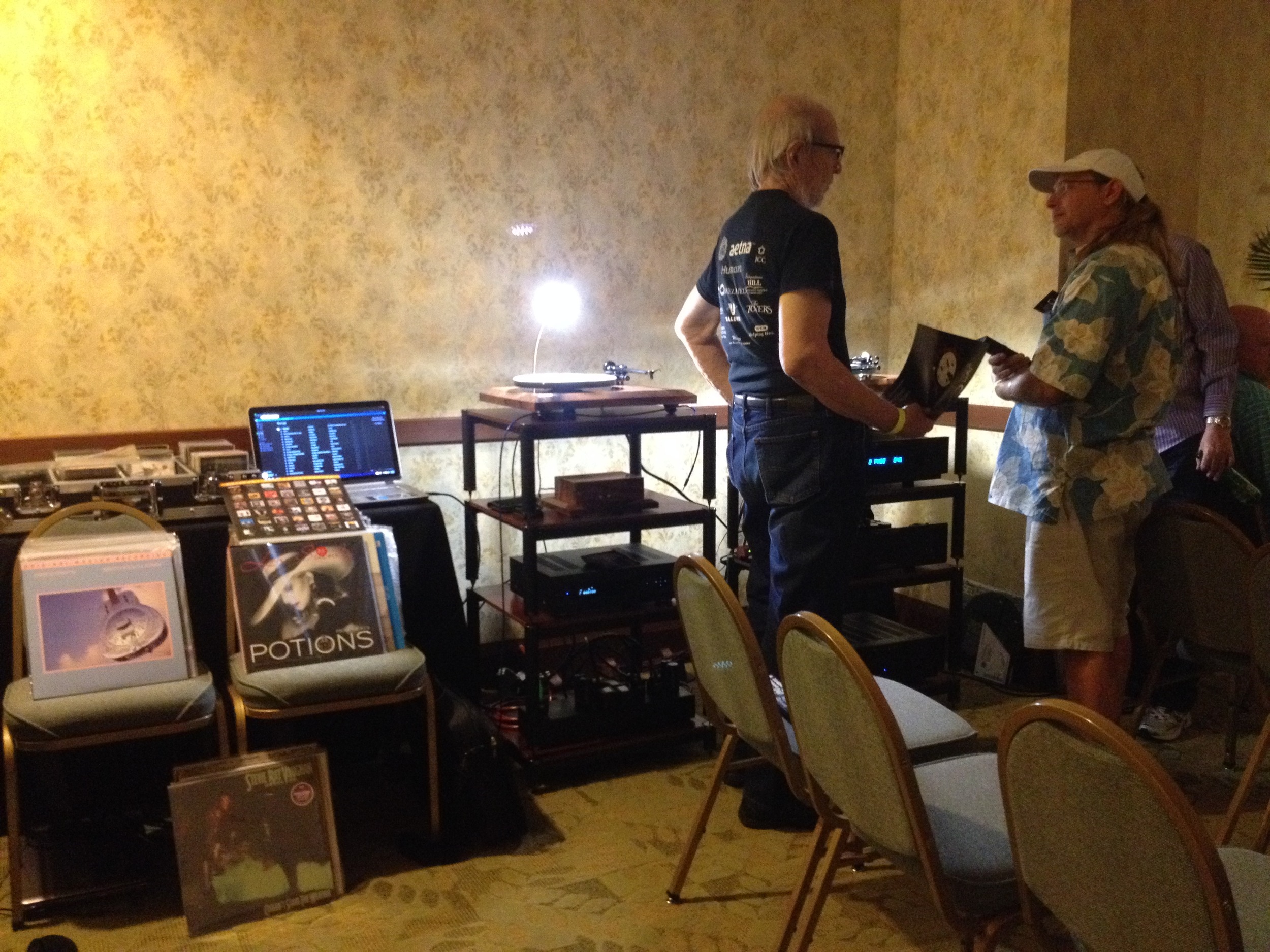 We had great music in tow, but of course many brought their own to spin up. A few folks were even kind enough to bring JWM Acoustics into the 21st century and load up JRiver on my laptop and stuff it full of great music. Who knew digital could bring a smile to this old analog geeks face? Well it did with the help of the OPPO BD105D we had in the rack. It turns out the internal DAC is FAR better than I had known! The DSD files streaming from the laptop were divine to say the least. (I better not say too much. I’m trying to sell turntables!) Now it looks like I’m going to need a lesson in organizing all this music into playlists for the next show. One more reason to love analog, alphabetical order is about as deep as it goes! Hehehe.
We had great music in tow, but of course many brought their own to spin up. A few folks were even kind enough to bring JWM Acoustics into the 21st century and load up JRiver on my laptop and stuff it full of great music. Who knew digital could bring a smile to this old analog geeks face? Well it did with the help of the OPPO BD105D we had in the rack. It turns out the internal DAC is FAR better than I had known! The DSD files streaming from the laptop were divine to say the least. (I better not say too much. I’m trying to sell turntables!) Now it looks like I’m going to need a lesson in organizing all this music into playlists for the next show. One more reason to love analog, alphabetical order is about as deep as it goes! Hehehe.
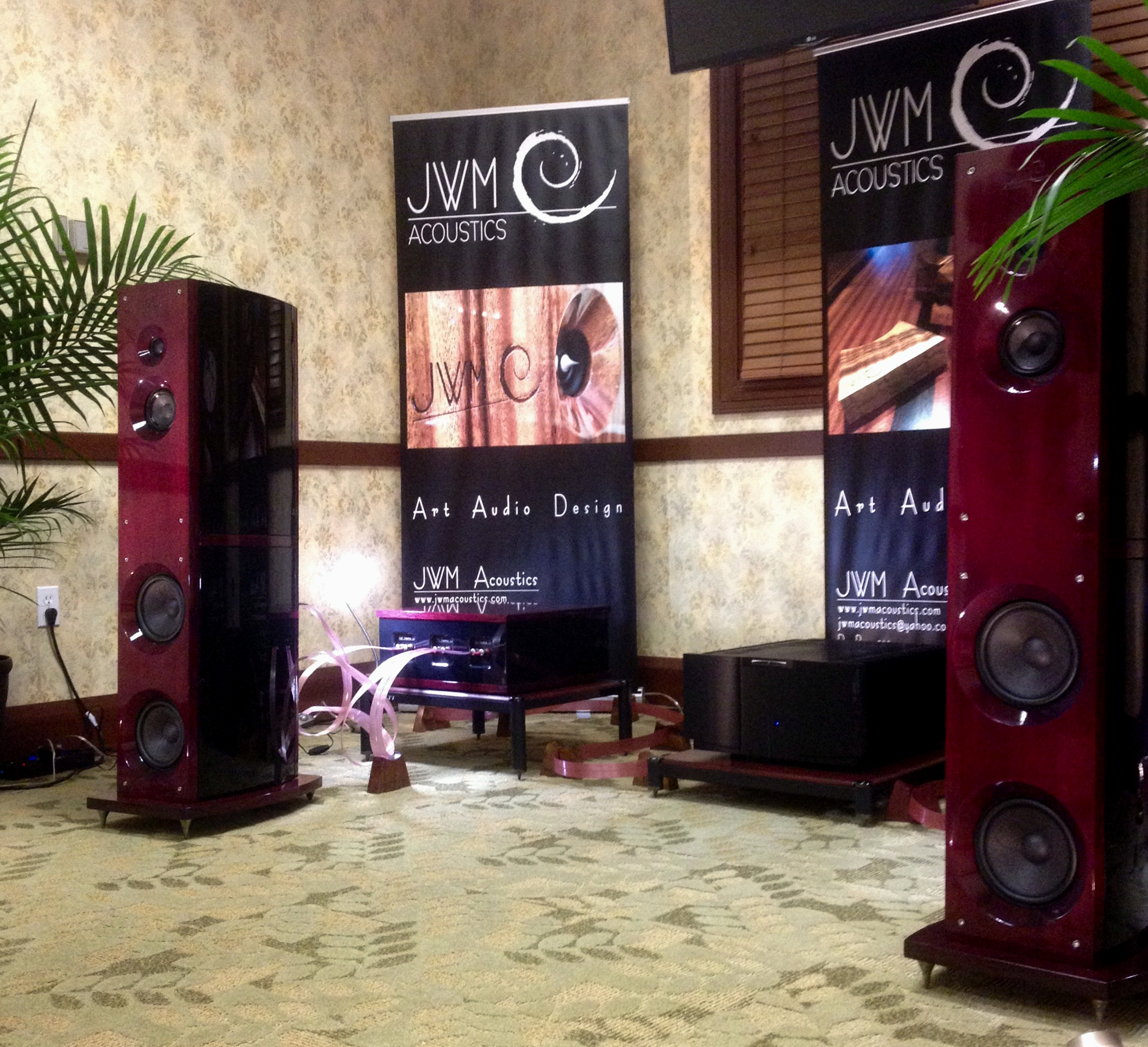 The system worked perfect. The REX preamp fed the mighty VK-655SE power amp with gusto. Having one of the quietest all tube preamps in the world powering a true super amp is nothing short of stunning. Put one of the best Tube phono stages in front of that and now we have something to marvel at. Now, pair the famous PW Windfeld from Ortofon on our new KAREN 6 turntable and I simply can’t explain what happens in words. Cables you ask? A full set of Nordost all the way around, including the Heimdall II speaker cables, Blue Heaven and Red Dawn interconnects and power cables. To clean it all up we added a few QV and QK line enhancing units to our power distribution systems.
The system worked perfect. The REX preamp fed the mighty VK-655SE power amp with gusto. Having one of the quietest all tube preamps in the world powering a true super amp is nothing short of stunning. Put one of the best Tube phono stages in front of that and now we have something to marvel at. Now, pair the famous PW Windfeld from Ortofon on our new KAREN 6 turntable and I simply can’t explain what happens in words. Cables you ask? A full set of Nordost all the way around, including the Heimdall II speaker cables, Blue Heaven and Red Dawn interconnects and power cables. To clean it all up we added a few QV and QK line enhancing units to our power distribution systems.
The results were fantastic. Yes, we already knew what this system is capable of because many of the components are integral to our reference system at home. What fun we had with that conference room and all three of our newest speaker systems to play with! And boy did we play! For the first day, we tried as hard as we could to break in a brand new set of the JANE JKM speakers that had only been put together a week prior to their debut at LSAF. We moved them all around the room trying to get the most out of them. In one spot the imaging literally had them disappear, but bass response was lagging. Move them 5 inches and suddenly the low end enveloped the room, but staging began to lag. This is a common dance we do in almost any environment the speaker will live in permanently. The toughest part of this room was the drop ceiling and lossy walls. The whole room wanted to become an echo-y rumble chamber to say the least. In the end, we decided on a compromise and the entire system locked into place. Ideal? No. Pretty freak’n good for that room? Absolutely! Even on a bad day setup in a cardboard shoe box, this system would still be better than 90% of the systems I have ever heard. The synergy of these components is that good.
 On day two and three we began playing with the other speakers in the lineup. First the ALYSON AML, then the NET-1. It took less than 3 seconds of Fever on Lyn Stanley’s Lost in Romance LP before the entire audience looked back at me and said “NO WAY”! The room locked in with grace and a sense of ease I had not heard even in our studios. We didn’t even attempt to voice the room or go through the usual speaker placement steps. It just worked. Obviously this speaker was a FAR better match for the room than the giant JANE floor stander. Why? Great question! For anyone interested in dropping this kind of coin on a system of their own be advised. Bigger is not always better in your particular room. In this case, you would have saved yourself $10,000.00 between the price of the two speakers and would easily have doubled your capabilities. I have a renewed pride in our smaller speaker offerings, but as always, we recommend hearing our entire line before making the determination we did on this day, in that room.
On day two and three we began playing with the other speakers in the lineup. First the ALYSON AML, then the NET-1. It took less than 3 seconds of Fever on Lyn Stanley’s Lost in Romance LP before the entire audience looked back at me and said “NO WAY”! The room locked in with grace and a sense of ease I had not heard even in our studios. We didn’t even attempt to voice the room or go through the usual speaker placement steps. It just worked. Obviously this speaker was a FAR better match for the room than the giant JANE floor stander. Why? Great question! For anyone interested in dropping this kind of coin on a system of their own be advised. Bigger is not always better in your particular room. In this case, you would have saved yourself $10,000.00 between the price of the two speakers and would easily have doubled your capabilities. I have a renewed pride in our smaller speaker offerings, but as always, we recommend hearing our entire line before making the determination we did on this day, in that room.
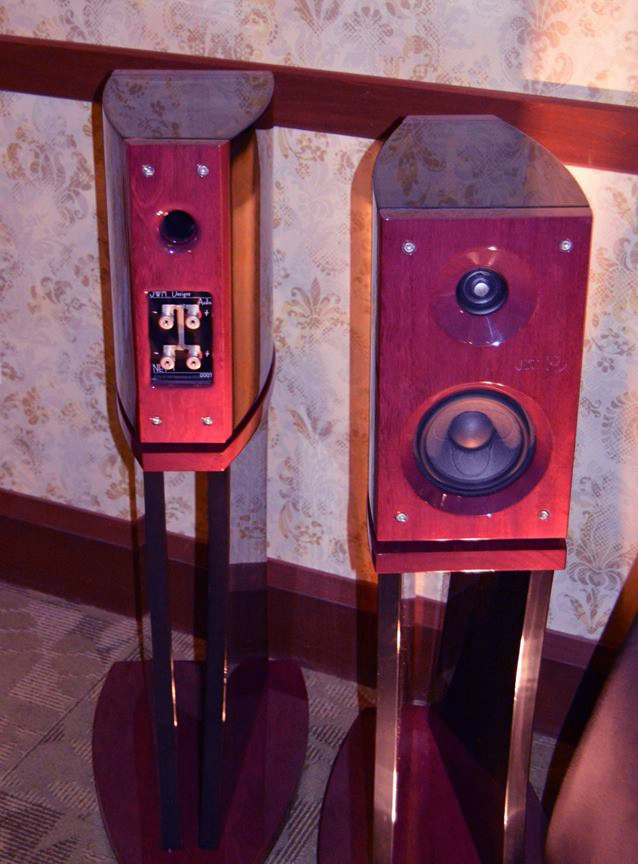 The fun didn’t stop there! How small can we go was the next question? Well, let’s see! The NET-1s were dropped into the same footprint of the ALYSONs and away we went. REALLY?!?!? A two way mini monitor filling a 4,620 cubic foot room full of people like a full range floor stander is simply not heard of. (Pun intended) The NET-1 did exactly that. I built the damn things and still had no idea of what they could do in a room like this. I heard of such sound coming from our designs, but never paid much attention to what was said. This was not the design goal after all. This was supposed to be a mini monitor turned into a near full range speaker for small environments. BUT I’LL TAKE IT! The little NET performed like a rock star without a hiccup. I am so proud of this little giant killer and will yell it from the roof tops! “Viva la NET”! “Viva la NET”! “Viva la NET”!
The fun didn’t stop there! How small can we go was the next question? Well, let’s see! The NET-1s were dropped into the same footprint of the ALYSONs and away we went. REALLY?!?!? A two way mini monitor filling a 4,620 cubic foot room full of people like a full range floor stander is simply not heard of. (Pun intended) The NET-1 did exactly that. I built the damn things and still had no idea of what they could do in a room like this. I heard of such sound coming from our designs, but never paid much attention to what was said. This was not the design goal after all. This was supposed to be a mini monitor turned into a near full range speaker for small environments. BUT I’LL TAKE IT! The little NET performed like a rock star without a hiccup. I am so proud of this little giant killer and will yell it from the roof tops! “Viva la NET”! “Viva la NET”! “Viva la NET”!
Raven Audio:
We had a chance to meet and get to know the owner of Raven Audio, Dave Thomson. I had only seen his equipment in reviews and on line, but as in art and fine wine, this never does justice to the actual piece in person. Trust me when I say you owe yourself the pleasure of giving these pieces a listen. Although our time with the equipment was limited, what I heard in the Raven room was fabulous. What I heard from Raven paired with our speakers was fabulously promising! On the last day before packing up the show, Dave was kind enough to bring down his killer new BlackHawk integrated amp to our room and plug it into our ALYSON ALM and NET-1 Speaker systems. The pairing seemed the most logical for the size, price point and output capabilities of the pairing. With limited time, in less than ideal conditions, every eyebrow in the room was raised and the tiny NET-1 opened up like a Oklahoma double wide in the middle of storm season! No tight lipped brick and mortar mini monitor sound with this pairing folks. PLEASE go hear this amp if you get a chance. The NET-1 is not the most efficient speaker in our lineup, nor does it have the depth capabilities of our larger offerings, but for some reason, in that room, on that day, with that amp, like we never heard, they blossomed.
Next, Dave was kind enough to allow us to bring a set of the ALYSON AML up to the Douglas Connections room to hear them paired up with the Spirit MK2 300B tube mono block amps and Silhouette Reference preamp. Folks, The specks on the ALYSON mean nothing when combined with this system. The true monitor characteristics were apparent from the first track that was spun up. Focus and detail were my first impressions, and then I realized that the low end of the drivers was being taken down to a level by that 300B tube I had not heard before. It is true that the 300 may not have the grip of other tubes I have heard on our speakers, nor the power, but the rumors of that tube bringing chills to your spine are all true. I WILL be looking into purchasing this amp in the future. It is truly a reference design that needs further investigation. Don’t believe me? Look into what Art Dudley said about it in the May issue of Stereophile magazine. Still need more proof of this design. Get off your butt and go hear it. It is impressive.
We truly hope to have a chance to hear some of RAVENs other offerings in the future. Not only for the obvious stellar sonic quality, but also for the fit and finish of the product. Perhaps I’m picky due to my industrial design background. This is truly well put together equipment kids. I have a few other reasons for wanting to explore RAVEN as well. This is a true American product built in Texas with love. If you hadn’t noticed, the system we are showing with for the next few events is all American as well. As a proud MADE IN AMERICA company, this means a lot to us. We plan to keep it that way. Lastly, much like JWM Acoustics, it would seem that RAVEN is a family affair. We were so happy to meet Dave’s wife Gabrielle, Mrs. RAVEN herself. Talk about lighting up a room! If you guys are reading this, it was a great pleasure meeting the both of you and we will keep the porch light on for ya if you ever decide to come out to Da islands…
 Enough already! Here are some pics we collected from here and there. Enjoy! We will see you next year!!!
Enough already! Here are some pics we collected from here and there. Enjoy! We will see you next year!!!
Aloooooha!!!
OK FOLKS! That's enough for now. Again, big thanks to all responsible for this awesome weekend. Hope to see ya'll next year, ya hear!
AloooooooHaaaaaaaa!!!
JWM
Taking the show on the road!
 Aloha!
Time to take the show on the road!
Aloha!
Time to take the show on the road!
Where we headed?!
After 15 years in HAWAII, in the month of May, JWM Acoustics is coming home to TEXAS! JWM will be showing the latest creations at the Lone Star Audio Fest in Dallas, Texas. The show runs May 1-3 at Embassy Suites Dallas - Park Central, 13131 North Central Expressway, Dallas, Texas, 75243
JWM Acoustics will be showing their newest equipment in the Carrollton Room on the ground floor off the main lobby of the hotel. JWM plans to bring all the music that can fit into a suitcase, but feel free to bring your favorite vinyl, CDs, SACDs or files to hear on the system. JWM’s goal is to introduce as many people as possible to what this growing audio company has been doing out in the Pacific Ocean.
 For the Lone Star Audio Fest, JWM has chosen to bring 3 sets of speakers. The NET-1 mini monitor, the ALYSON AML large monitor and the JANE JKM floor standing flagship. Also included in the collection will be the KAREN 6 turntable and several examples of HI-FI accessories including Cable Cradles in various wood species and sizes.
For the Lone Star Audio Fest, JWM has chosen to bring 3 sets of speakers. The NET-1 mini monitor, the ALYSON AML large monitor and the JANE JKM floor standing flagship. Also included in the collection will be the KAREN 6 turntable and several examples of HI-FI accessories including Cable Cradles in various wood species and sizes.
 We are proud to say we will be showing with some great American companies as well. The main system will be largely comprised of Balanced Audio Technology, including the REX Preamplifier, VK-P10SE Phono Stage and the newest amplifier in the line, the mighty VK-655SE. Sources will include the OPPO BD-105D Multi reader and files supplied from several storage mediums. Ortofon cartridges will be in use as well! We will have examples of MM and MCs on hand including the 2M BLACK and Windfeld. Cables and Power supplies are being provided by NORDOST and we will have numerous examples on hand to sample, including the Leaf, Frey and Norse lines.
We are proud to say we will be showing with some great American companies as well. The main system will be largely comprised of Balanced Audio Technology, including the REX Preamplifier, VK-P10SE Phono Stage and the newest amplifier in the line, the mighty VK-655SE. Sources will include the OPPO BD-105D Multi reader and files supplied from several storage mediums. Ortofon cartridges will be in use as well! We will have examples of MM and MCs on hand including the 2M BLACK and Windfeld. Cables and Power supplies are being provided by NORDOST and we will have numerous examples on hand to sample, including the Leaf, Frey and Norse lines.
 In short, this will be one heck of a system that is guaranteed to raise some eyebrows and the hairs on your neck. The goal was to create a system that was as neutral as possible, with the ability to provide the extreme dynamic capabilities inherent to JWM Acoustics designs. Whether you are a fan of Opera, Rock or Jazz, this system provides a black background from which the performance can project in stunning transient fashion, yet whisper the most subtle detail.
In short, this will be one heck of a system that is guaranteed to raise some eyebrows and the hairs on your neck. The goal was to create a system that was as neutral as possible, with the ability to provide the extreme dynamic capabilities inherent to JWM Acoustics designs. Whether you are a fan of Opera, Rock or Jazz, this system provides a black background from which the performance can project in stunning transient fashion, yet whisper the most subtle detail.
As some of you know, JWM Acoustics is a custom 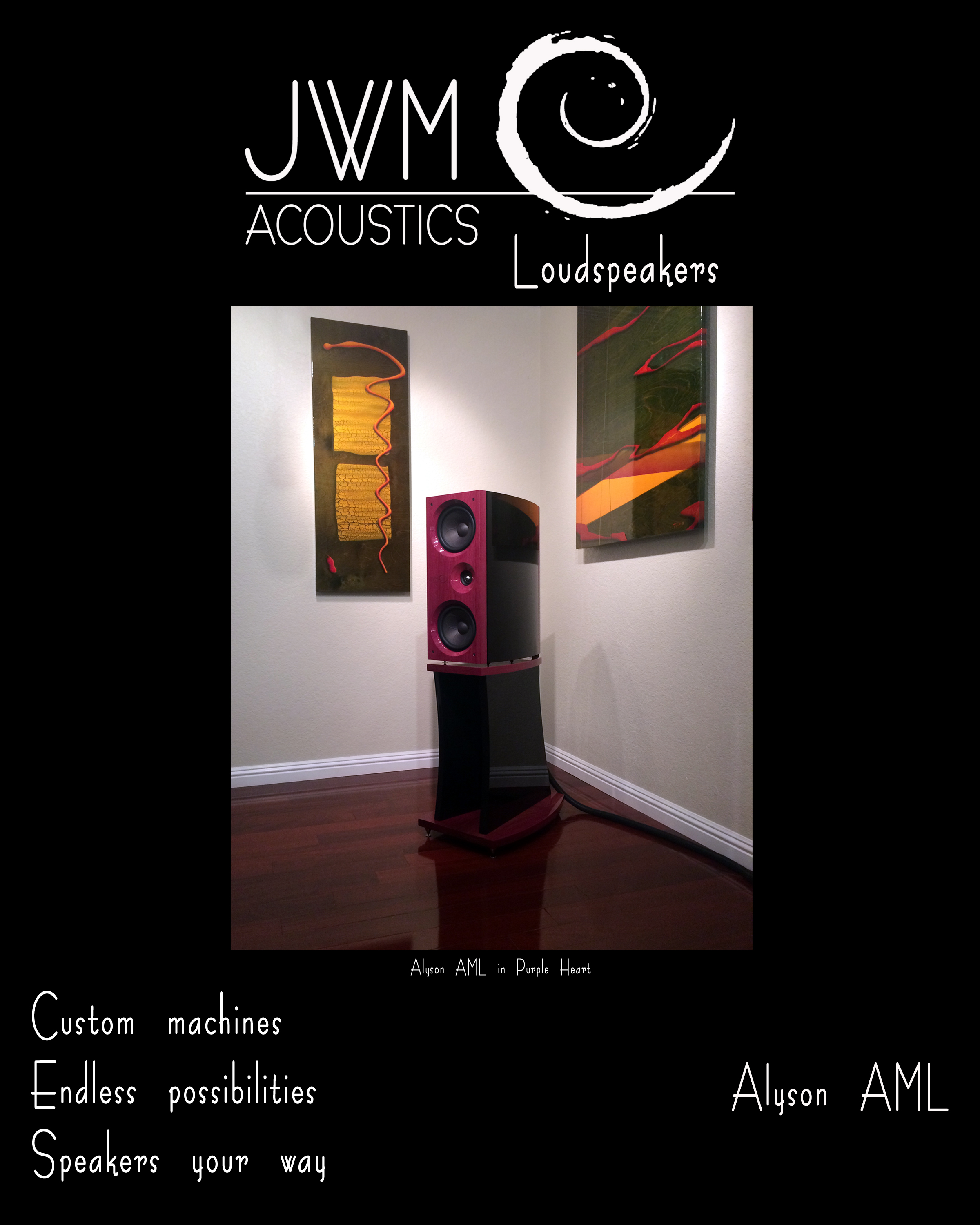 audio company catering to the individual needs of the client. Each product is handmade and as unique as the person who chooses it. JWM is pleased to create one of a kind pieces that will enhance the life of each person who experiences it. JWM products are not only built as sound reproduction tools, but as instruments that will last for generations.
audio company catering to the individual needs of the client. Each product is handmade and as unique as the person who chooses it. JWM is pleased to create one of a kind pieces that will enhance the life of each person who experiences it. JWM products are not only built as sound reproduction tools, but as instruments that will last for generations.
 Joshua Weston Miles has a background in visual arts, music, industrial design and audio engineering. Combining them has been a lifelong passion. Miles has succeeded with the products being shown at the Lone Star Audio Fest in May, representing state of the art sound reproduction and timeless design. Each product is designed to be equally at home in the recording studio, home theater or audiophile listening room. Nearly unlimited combinations of custom woods and finishes enable him to design a system that will perfectly fit within your space.
Joshua Weston Miles has a background in visual arts, music, industrial design and audio engineering. Combining them has been a lifelong passion. Miles has succeeded with the products being shown at the Lone Star Audio Fest in May, representing state of the art sound reproduction and timeless design. Each product is designed to be equally at home in the recording studio, home theater or audiophile listening room. Nearly unlimited combinations of custom woods and finishes enable him to design a system that will perfectly fit within your space.
JWM Acoustics is located in beautiful Hawaii on the Island of Oahu. 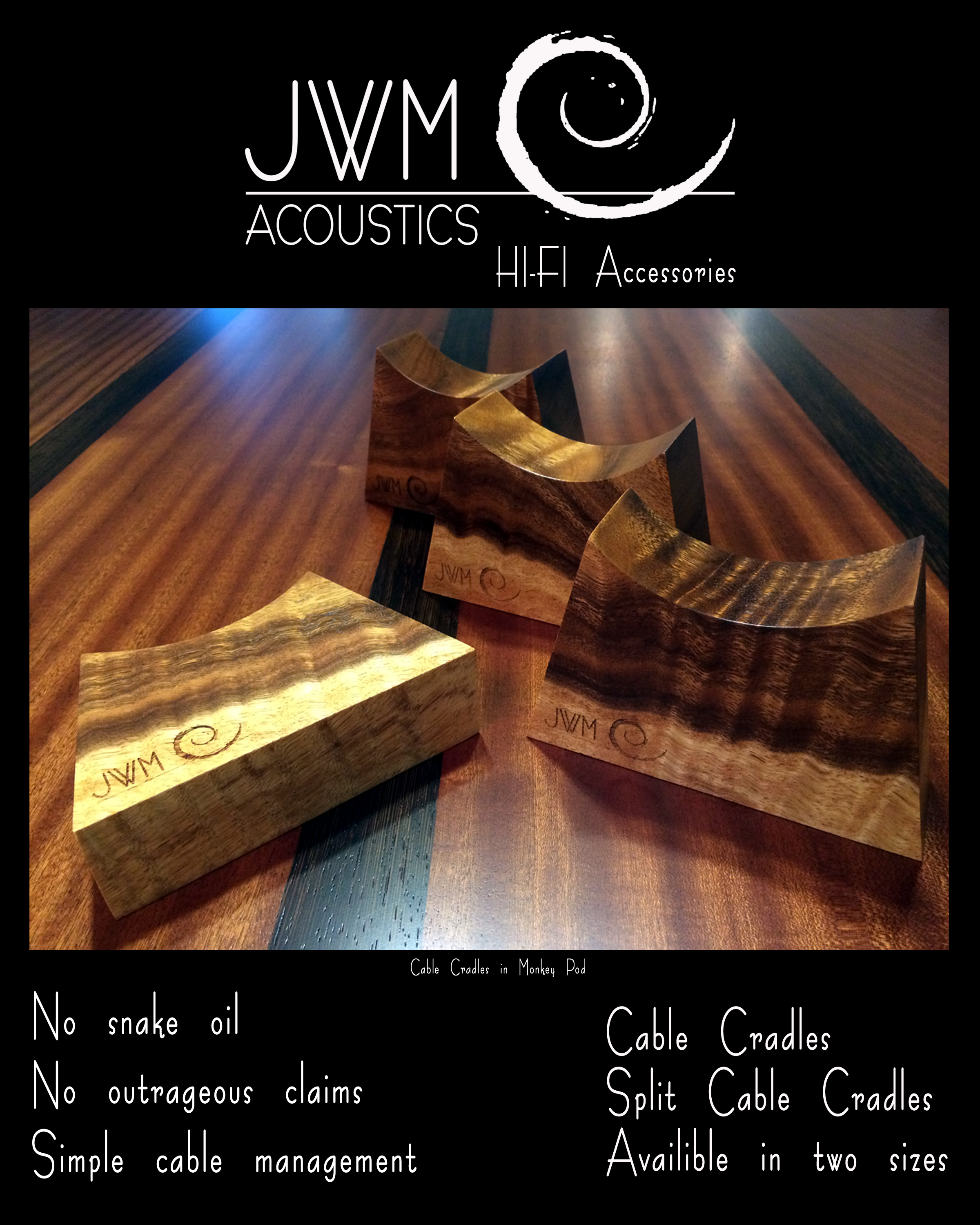 Currently, there are two locations where these instruments are created. The woodworking and finish facility is located in the heart of Honolulu. The electronics, testing and listening studios are located in the town of Kaneohe on the East side of the island. Visitors are always welcome if you would like to see the works in progress. Accommodations for private viewings and listening sessions are available in the Kaneohe location by appointment.
Currently, there are two locations where these instruments are created. The woodworking and finish facility is located in the heart of Honolulu. The electronics, testing and listening studios are located in the town of Kaneohe on the East side of the island. Visitors are always welcome if you would like to see the works in progress. Accommodations for private viewings and listening sessions are available in the Kaneohe location by appointment.
We hope to see you all there.
Aloha, Mahalo and Thank you.
JWM Acoustics jwmacoustics.com jwmacoustics@yahoo.com (808)349-6661 PO BOX 944 Kailua, HI. 96734
Introducing KAREN From JWM Designs LLC
LOCALLY GROWN TURNTABLES NOW AVAILABLE!
“Over the course of our lives, many things will come and go. The most important, will come back again and again. Each time they do, we gain a greater appreciation for their presence. A new respect. We begin to covet and value this presence and influence on our lives. In reality, these little visits mold who we are. The trick is to never take the return of these things for granted, or expect more than we deserve from them. This is true for things such as as a favorite record. Every few years, it seems you stumble upon one in the bin of a local flea market. Perhaps it is a certain flavor that hits you while dining at a new restaurant. It reminds you of a childhood friend, or a long lost aunt. Have you ever heard a sound that brings a flood of memories gushing in? A tear forms in your eye and you wonder where all the time has gone and what happened to tear you away for so long. For me, those things are far too many. One is a sound I have been chasing for many years, but remains elusive to say the least. Until now that is. A sound I longed to know again. An analog voice heard in childhood now rendered less scratchy and void of pops. A sound more rich and clean and deeper than ever before. For me, that thing also comes in the form of one next of kin. Her voice, like that sound, has had more influence on me than she knows and the respect I have for her grows by the day. Her voice may come and go like other things, but each time it returns, it is as rich and more comforting than any sound I know. These pieces will be named for that voice. My sister, Karen”…
I have been messing around with turntables for at least ¾ of my life. When nobody was home, I started tearing my Pops deck apart. I was too young to understand how it worked. That was the idea though. I had to figure out how that song from The Sting could make its way from that black disk into those AR speakers! HOW!?! As luck would have it, the answer really was not that complicated. Much like a microphone, a needle or stylus is vibrated by a groove in a record. That vibration is transformed into an electrical signal that flows to an amplifier. That amplifier boosts the signal to a higher power in order to feed a transducer, or speaker. That speaker transforms the electrical signal into pressurized sound waves that our ears can detect as music or your favorite comedy album… Viola!
Options, options, Options…
Ok, so now that we worked that out… the fact is that it ain’t that easy. “Ugh”. Fortunately, we have many tools available in this day and age to make it a bit easier than it was even a few years back. For instance, individual parts like tone arms and motors are so much more available and better than ever before. The parts are so much easier to modify and tune to your own taste as well! Do you want a DC motor? Done. A Sapphire bearing? Done. Computer controlled speed adjustment? Done. Glass platter? Done. Etc. Etc. and so on. Did I mention materials for the plinth yet? Oh, how about Padauk? Monkeypod? Wenge? All of the above?
REAL WOOD?!?
 Modern technology, as pertaining to damping materials, has made it possible to throw away the old ideas of what to use. In the past, it seemed the only material that worked for a plinth was the consistency of MDF or some other cheap material. To me, when I see a piece of furniture made from MDF and laminated with a fancy veneer, I simply can’t get past what is underneath. I understand that cost is important in manufacturing for the mass market, but really? The excuse that MDF has a repeatable consistency and its acoustic properties are far more predictable than that of wood is malarkey. Yes, I use MDF in some of my designs, but only FOR its acoustic properties. Not
Modern technology, as pertaining to damping materials, has made it possible to throw away the old ideas of what to use. In the past, it seemed the only material that worked for a plinth was the consistency of MDF or some other cheap material. To me, when I see a piece of furniture made from MDF and laminated with a fancy veneer, I simply can’t get past what is underneath. I understand that cost is important in manufacturing for the mass market, but really? The excuse that MDF has a repeatable consistency and its acoustic properties are far more predictable than that of wood is malarkey. Yes, I use MDF in some of my designs, but only FOR its acoustic properties. Not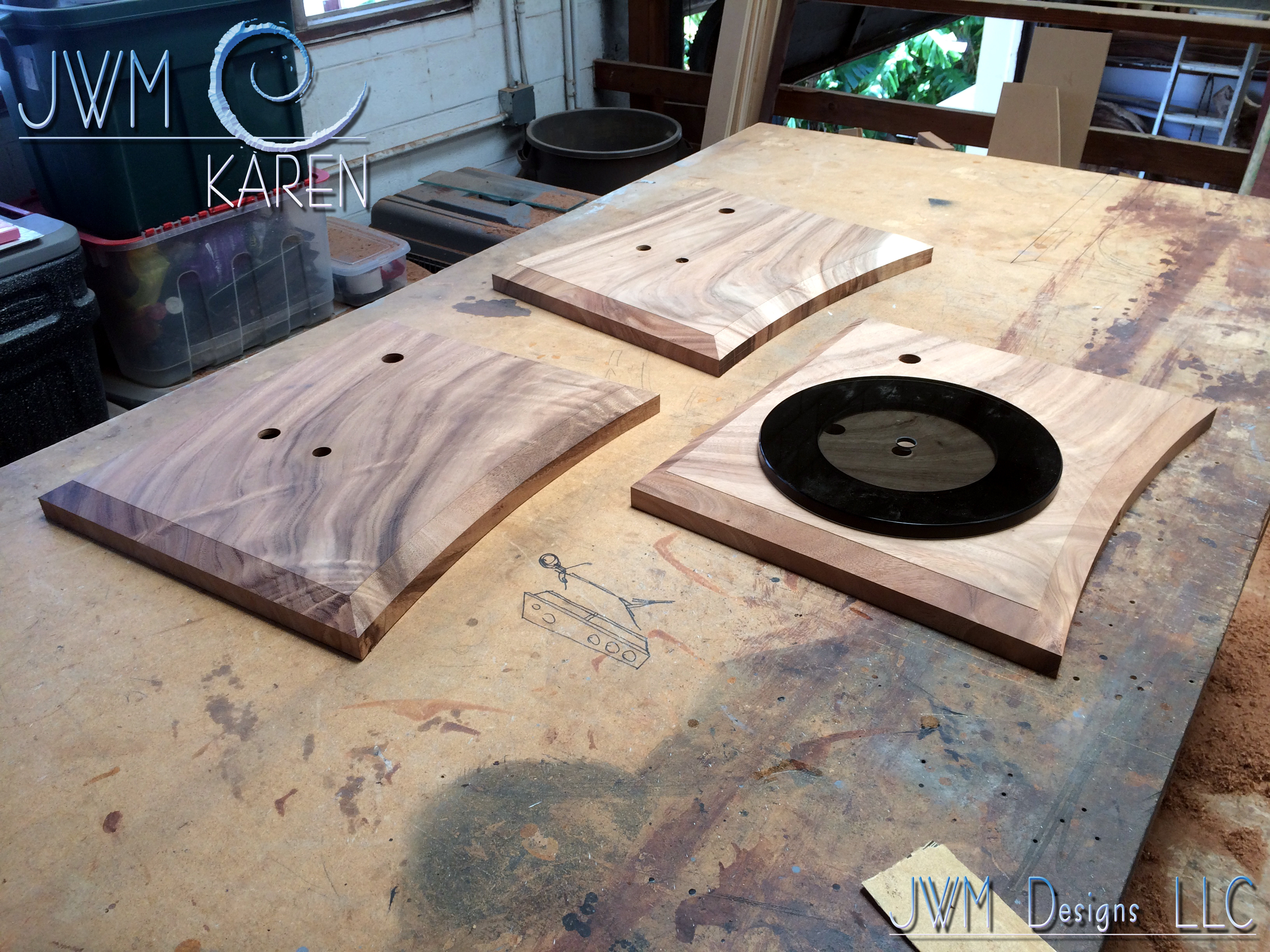 as an excuse. In the case of the Karen turntable, MDF or cheaper materials are simply not necessary or desirable. I look at these machines as a permanent fixture of the end users system and home. As you may know by now, I don’t build pieces as disposable electronics. I build instruments. Ones that should, like my speakers, be chosen as such. It will last. A very long time. Thus, the plinths and case work are treated as such. Solid hardwoods of any species you like may be selected. Choose wisely. This is the last turntable you will ever buy!
as an excuse. In the case of the Karen turntable, MDF or cheaper materials are simply not necessary or desirable. I look at these machines as a permanent fixture of the end users system and home. As you may know by now, I don’t build pieces as disposable electronics. I build instruments. Ones that should, like my speakers, be chosen as such. It will last. A very long time. Thus, the plinths and case work are treated as such. Solid hardwoods of any species you like may be selected. Choose wisely. This is the last turntable you will ever buy!
Down to business:
The Karen is a direct modification for the P series turntables from Rega. Any of the tables in this line are a direct drop-in. Also, being that the pattern and holes are tapped to Rega and SME standards, any other manufacturers parts using this mounting pattern can be fit to each plinth. The plinth is designed to be a functioning modern classic. Each is constructed of solid hardwoods and finished in the very same 12 step process as my speaker systems. Each plinth is as unique as the trees in the forest and can be ordered in any wood desired.
Vibration:
The use of hardwoods is now as easy and predictable as any other material available. In the case that stray vibrations need to be damped, I use many of the same materials I have in my quiver for my speaker cabinets. As you would guess, the harder the wood, the higher the resonant frequency of the plinth. The grain variations within the wood help to break up standing waves within the table. I also use any number of vibration control feet depending on what the end user feels most comfortable with. All of these factors are looked at on a table to table basis, thus each machine is as unique as the person who chooses it. Now how could this possibly be more fun!
Technical stuff and more options:
 The arm cutout is at the 222mm position from the center of the platter bearing. Meaning you are welcome to choose any 9” arm you prefer with only a slight up charge for installation. If you choose to buy a complete setup, the standard package features a Rega arm. Again, you may specify which arm you like, and I am happy to make the necessary adjustments. Should you choose a custom arm length from another manufacturer, just say the word. I am happy to create a custom piece to your specifications.
The arm cutout is at the 222mm position from the center of the platter bearing. Meaning you are welcome to choose any 9” arm you prefer with only a slight up charge for installation. If you choose to buy a complete setup, the standard package features a Rega arm. Again, you may specify which arm you like, and I am happy to make the necessary adjustments. Should you choose a custom arm length from another manufacturer, just say the word. I am happy to create a custom piece to your specifications.
 The motor is mounted in standard Rega fashion. Well, kind of! The length of the belt and pulley is standard, but that is where it ends. I have created a system that will fit most standard Rega mounts. I have also chosen as my standard the same motor assembly as the P1-3 and 6 tables from Rega. (Do you see a pattern here?) I
The motor is mounted in standard Rega fashion. Well, kind of! The length of the belt and pulley is standard, but that is where it ends. I have created a system that will fit most standard Rega mounts. I have also chosen as my standard the same motor assembly as the P1-3 and 6 tables from Rega. (Do you see a pattern here?) I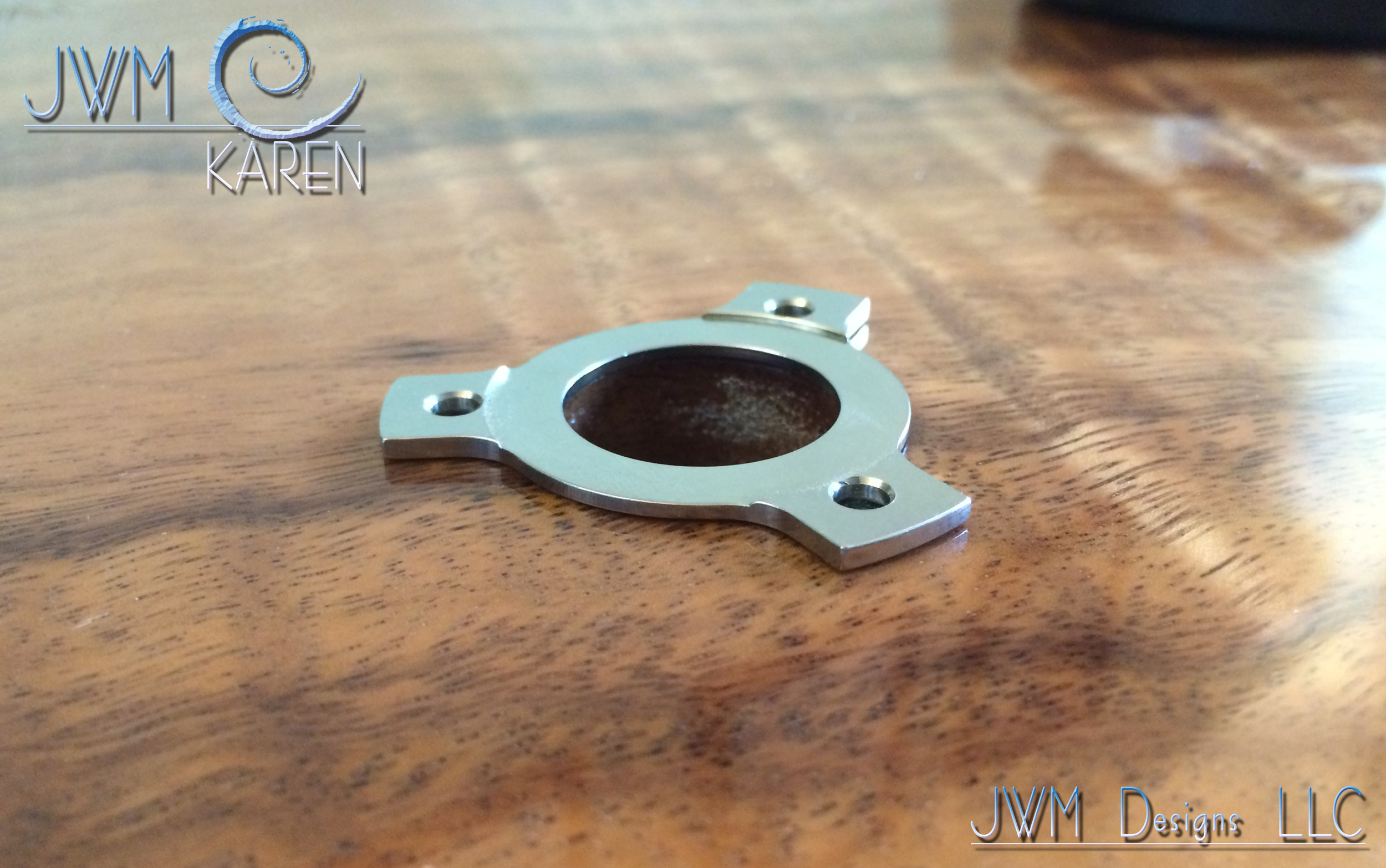 bolt the motor through the plinth and isolate it with further damping. The materials I use are similar to those used for vibration control in my speakers. This significantly lowers the noise floor. Stable and quite is the name of the game in good analog sound reproduction. That is exactly what you get from the Karen.
bolt the motor through the plinth and isolate it with further damping. The materials I use are similar to those used for vibration control in my speakers. This significantly lowers the noise floor. Stable and quite is the name of the game in good analog sound reproduction. That is exactly what you get from the Karen.
Voila!!!
Whether you are a seasoned audiophile, or still wet behind the ears, these machines will bring a smile to your face for many years. The sound is rich and clean with serious transit response and timbre. For pop, modern rock, or jazz they have pace, depth and speed. For those inclined to the classical side of the spectrum, these decks throw a deep and wide sound stage with great placement resolution of each instrument. Frequency extremes are well defined and so are the presence regions of the spectrum for vocal recording. In other words, this deck does it all!
I hope you enjoy the Karen as much as I do. After all, music is what it’s all about.
Keep your records clean ya’ll!
Joshua W. Miles
PS: These pieces are hand made in Hawai'i!
Each one of these turntables is lovingly hand made on O'ahu. When possible, I use locally grown wood. Each piece is chosen, milled, sanded, cut and finished in Honolulu.
If you would like to see, hear, or better yet, order one of these musical creations please feel free to contact me any time. Dealer inquiries are always welcome!
Joshua W. Miles Designs LLC (808)349-6661 (808)421-9991 PO BOX 944 Kailua, HI. 96734 joshuawmilesdesigns@yahoo.com
Introducing The Alyson AML from JWM Designs LLC
“Many years ago, our father named a beautiful boat for my sister. Unfortunately that vessel sank and too did the name. I never thought that was fair. It was like my sister had been cheated somehow. I know if my father were still alive, he would have named another vessel for her. I am proud of the machines I build, much like my father was of his boat. I know my systems don’t float, or provide a steady platform for sunbathing in the gulf, but perhaps they should be named for my sister anyway. After all, there was enough pride in my father to name his vessel for this amazing woman. Like my sister, and that boat, I feel these machines are not only powerful, assertive and poised, but delicate and graceful at the same time. So be it then. I give you the Alyson.”
The idea:
The idea for these machines came while working on another design. A design I am still working on as a matter of fact. They are floor standing, rear horn loaded, transmission line speakers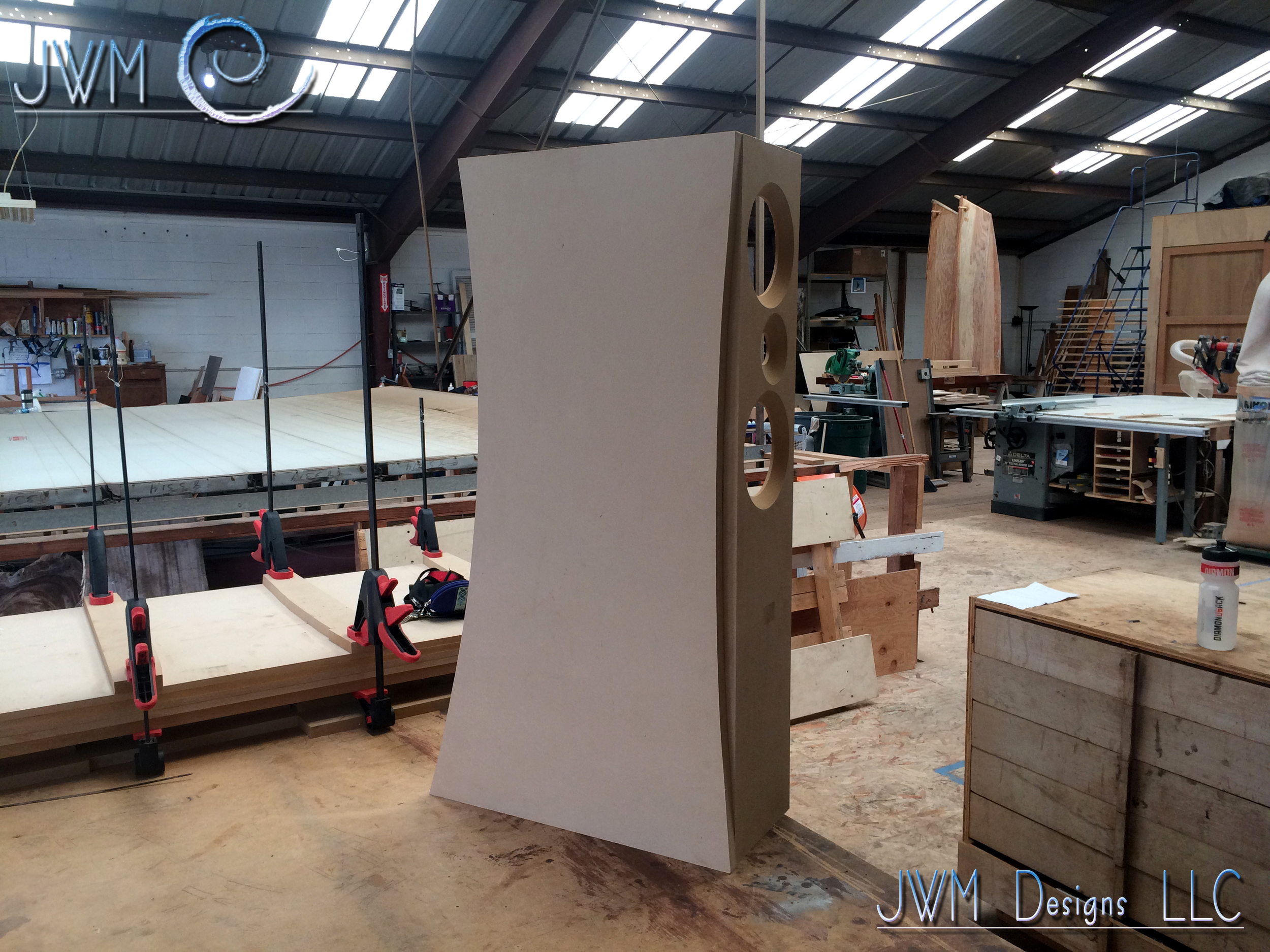 that I have been building for many years. The design has always been a challenge though. Don’t get me wrong, after 15 years of research and development, they are remarkable. The trick has been downsizing them into a real world size that can be aesthetically pleasing for, well; let’s just say the average spouse. (I hope I’m not in trouble here.) To do this, one must do a ton of dancing with the tuning of the machines. This takes time and patience. Both of which I am running out of. Often, I must take a break from the project and turn my attentions elsewhere. Call it a hiatus if you will. This is my way to get a fresh perspective when I return to the project. This also stands true for my other artistic endeavors. Stay tuned. They will be great indeed. Some day.
that I have been building for many years. The design has always been a challenge though. Don’t get me wrong, after 15 years of research and development, they are remarkable. The trick has been downsizing them into a real world size that can be aesthetically pleasing for, well; let’s just say the average spouse. (I hope I’m not in trouble here.) To do this, one must do a ton of dancing with the tuning of the machines. This takes time and patience. Both of which I am running out of. Often, I must take a break from the project and turn my attentions elsewhere. Call it a hiatus if you will. This is my way to get a fresh perspective when I return to the project. This also stands true for my other artistic endeavors. Stay tuned. They will be great indeed. Some day.
In the meantime:
About 5 years ago, several people asked if I had any smaller monitor designs. During this time, I had also noticed a trend toward smaller and simpler systems. In other words, more compact audio equipment that has less of a footprint on the living environment. Also around the same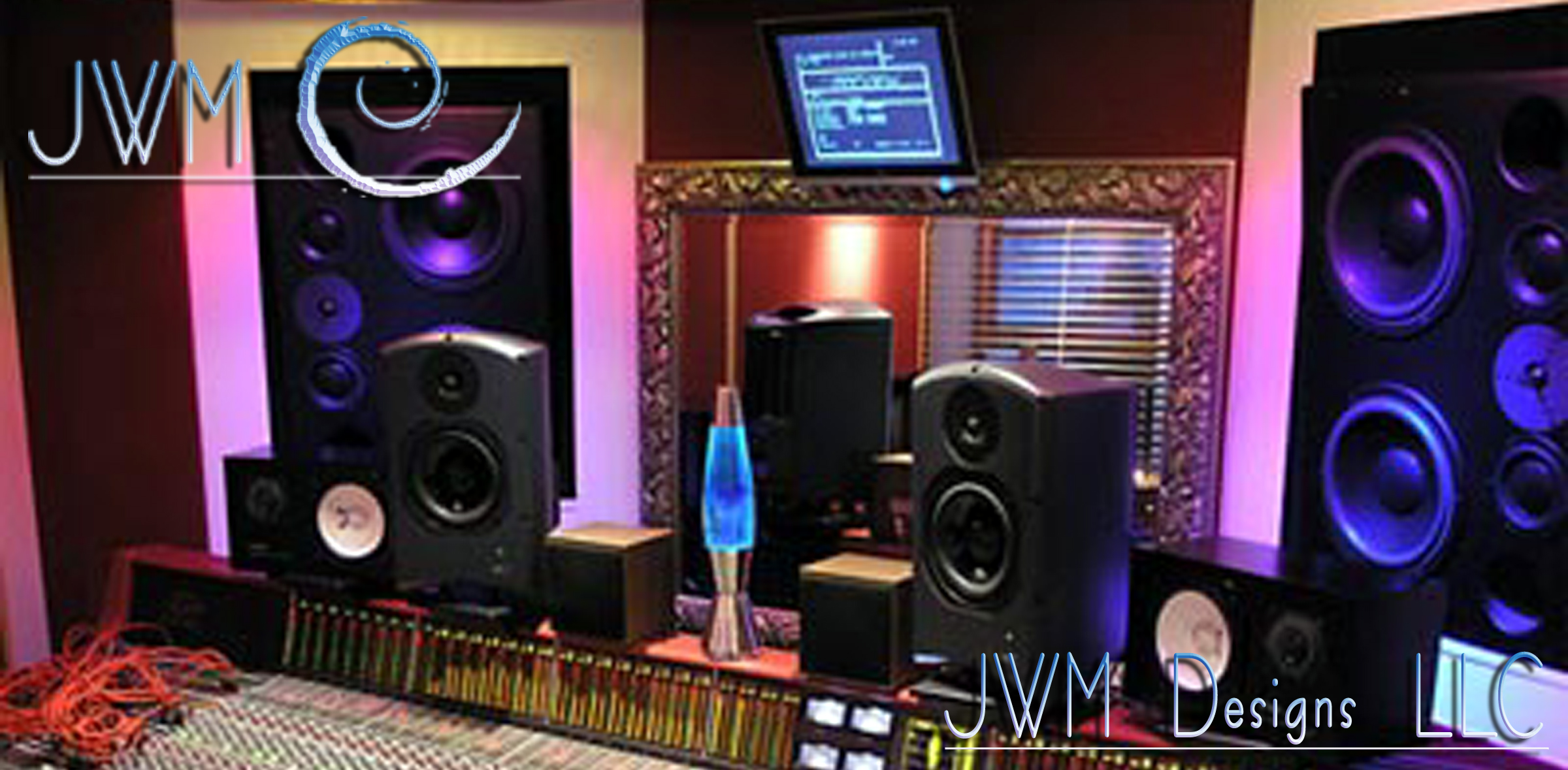 time, I had received a phone call from a studio where I had installed a set of my monitors many years ago. They had asked if I was still building and if I had made any improvements or updated the designs I had built for them. Truth is, I had thought about it many times, but the answer was no. I had not put thought to paper on these designs in a long while. Perhaps there was never a demand big enough to sustain building small near field monitors that cost as much as a Hyundai. Building one-offs specifically for the environment the client resides in was always my way. But alas, it may be time to open this can of worms again and see what I can do!
time, I had received a phone call from a studio where I had installed a set of my monitors many years ago. They had asked if I was still building and if I had made any improvements or updated the designs I had built for them. Truth is, I had thought about it many times, but the answer was no. I had not put thought to paper on these designs in a long while. Perhaps there was never a demand big enough to sustain building small near field monitors that cost as much as a Hyundai. Building one-offs specifically for the environment the client resides in was always my way. But alas, it may be time to open this can of worms again and see what I can do!
The research begins:
I spent several weeks in the shop revisiting the design I had built for the studio. I built a set identical to theirs and began tearing it down. I found so many flaws in the design, it was almost embarrassing. Not the overall sound mind you, just the overall lack of life and timbre. As a studio monitor these pieces were wonderful, but they would never pass the muster in a real world HI FI system. At least 10 times, “Clinical and flat” was scribbled in my listening notes. But that is what the client wanted! They wanted me to tune this system to sound like “NOTHING!” flat frequency response with as little coloration of their own as possible. The system they would be driving the monitors with was also as flat as it gets with no sugar coating what so ever. Spectral Audio amplifiers and preamps were chosen to feed the system from front to back. Flat, flat, flat…
Why did it sound so bad to me now? Why I ask?!?!
To me it all boiled down to two things. First; my lack of knowledge at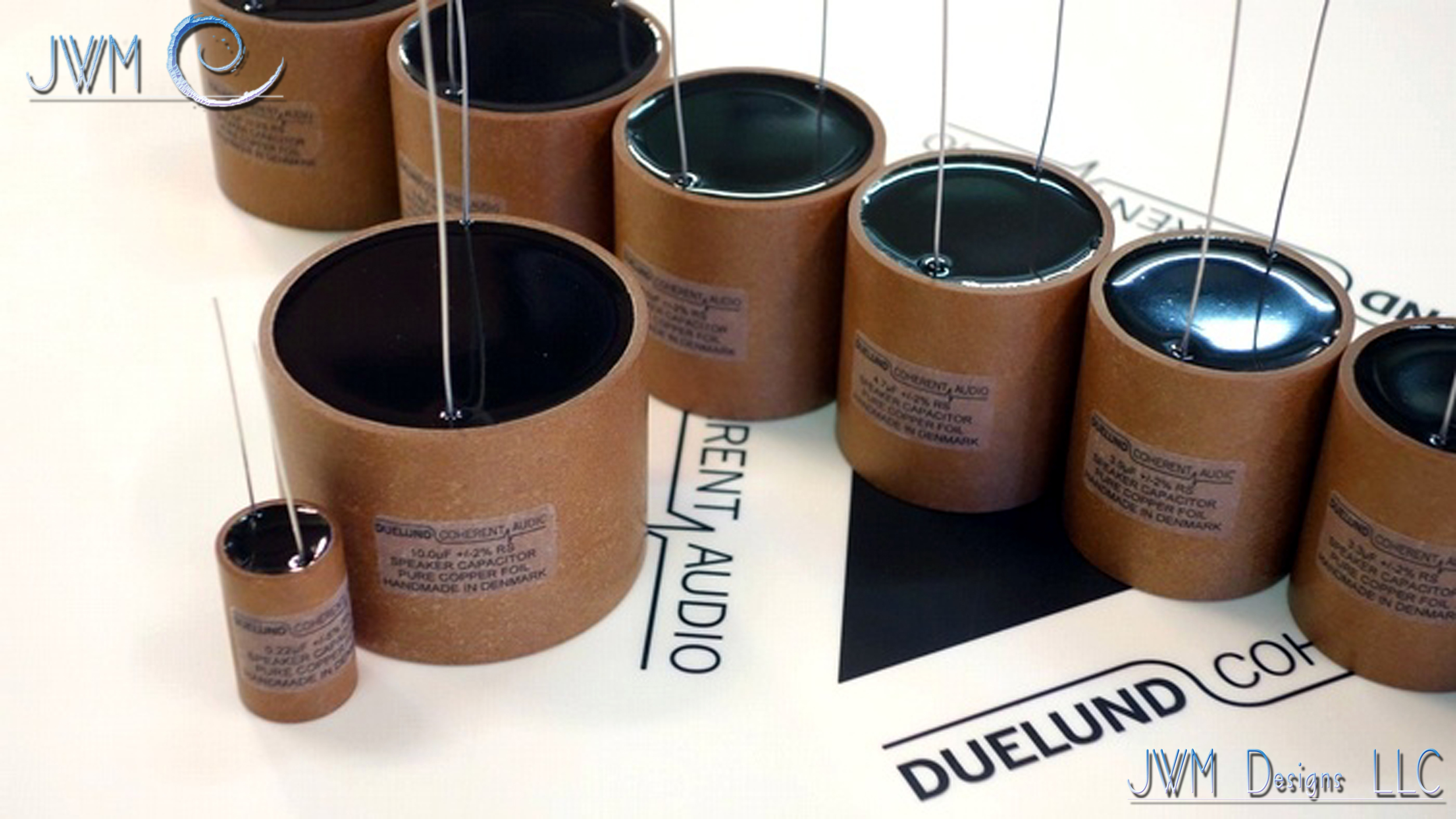 the time of the original design execution. Second; the lack of technology at the time. The fast and silky capacitors of today simply did not exist. Nor did the amazing new foil inductors and Vishay resistors modern designers use now without a thought. Yes, back then the thought of spending 200 bones on a single capacitor was unheard of, but for a few
the time of the original design execution. Second; the lack of technology at the time. The fast and silky capacitors of today simply did not exist. Nor did the amazing new foil inductors and Vishay resistors modern designers use now without a thought. Yes, back then the thought of spending 200 bones on a single capacitor was unheard of, but for a few  manufacturers. Today, not so much. I’d spend 700 without a flinch if it is what it takes to get “That Sound”. And “That Sound” is exactly what I set my sights on. Don’t forget, the speakers in the studio were more than 10 years old now and permanently installed. I had to do this from 4,000 miles away. Challenge accepted!
manufacturers. Today, not so much. I’d spend 700 without a flinch if it is what it takes to get “That Sound”. And “That Sound” is exactly what I set my sights on. Don’t forget, the speakers in the studio were more than 10 years old now and permanently installed. I had to do this from 4,000 miles away. Challenge accepted!
I called the studio back a few months later and gave the news about the new crossover system. I made it clear that this may be just what they wanted. “Same system, just with new life and a powerful new sound”. I explained. They took the bait and off the crossover boards went to the FedEx shop down the street. It’s always hard to see your children off for the first time. Especially when some other technician will be in charge of the installation and final judgment. Studios don’t usually mess around and having their main monitors out of commission for two days is a BIG deal. So, cue the fingernail chewing Maestro!
the news about the new crossover system. I made it clear that this may be just what they wanted. “Same system, just with new life and a powerful new sound”. I explained. They took the bait and off the crossover boards went to the FedEx shop down the street. It’s always hard to see your children off for the first time. Especially when some other technician will be in charge of the installation and final judgment. Studios don’t usually mess around and having their main monitors out of commission for two days is a BIG deal. So, cue the fingernail chewing Maestro!
 Shortly after I ran out of valium while waiting on the verdict, the call came. That call set the stage for what I decided to spend the next period of time and energy on. That time ended up being 5 years. “Josh, thank you! This system has never sounded as good. You really should build this design for the commercial market. It may work. How much do we owe you?” Let’s just say he was not as happy as he was when the phone call was initiated. None the less, he agreed it was still one hell of a bargain! Remember those $700 capacitors and inductors I mentioned earlier? I integrated a LOT of them.
Shortly after I ran out of valium while waiting on the verdict, the call came. That call set the stage for what I decided to spend the next period of time and energy on. That time ended up being 5 years. “Josh, thank you! This system has never sounded as good. You really should build this design for the commercial market. It may work. How much do we owe you?” Let’s just say he was not as happy as he was when the phone call was initiated. None the less, he agreed it was still one hell of a bargain! Remember those $700 capacitors and inductors I mentioned earlier? I integrated a LOT of them.
What next?
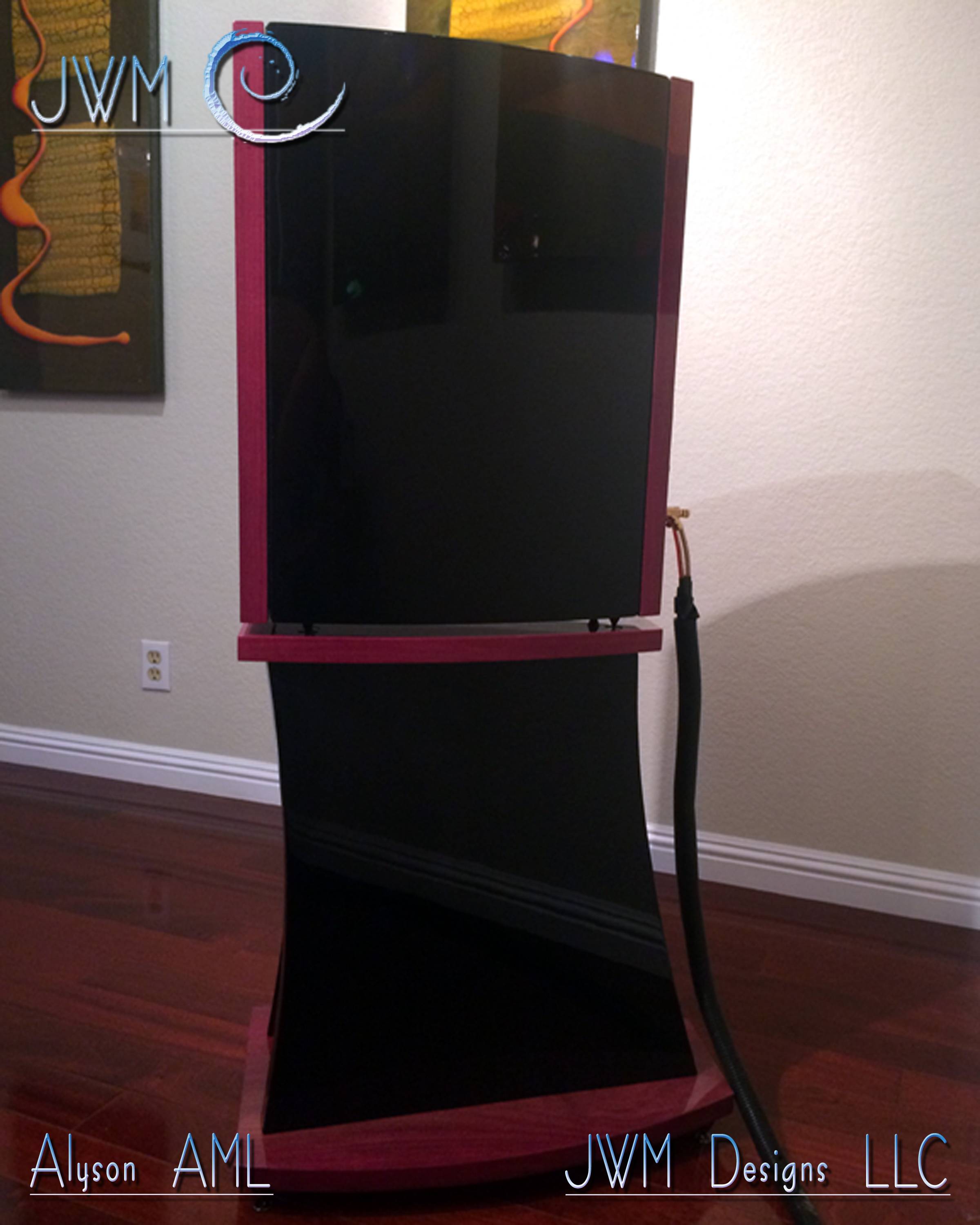 So, here we are. A few years later and several gray hairs to show for it, the Alyson AML is born. Of course, it’s true that a near field monitor retailing for the price of a Hyundai is still a narrow market. But when you tune that monitor to thrive in every real world environment outside of the studio, dress her in some pretty cabinetry, solid hardwoods, piano lacquers and the best components available, now we have something! A design within reach of most music lover’s pocketbooks. One that will also continue to thrill for years to come. You see, these are not just machines to me. They are instruments. Pieces of my industrial design should not be chosen like any other high-end speaker system. No, these are to be chosen as if purchasing a piano that will be in the family for generations to come. That is exactly what these are. Instruments. My pianos. Alyson.
So, here we are. A few years later and several gray hairs to show for it, the Alyson AML is born. Of course, it’s true that a near field monitor retailing for the price of a Hyundai is still a narrow market. But when you tune that monitor to thrive in every real world environment outside of the studio, dress her in some pretty cabinetry, solid hardwoods, piano lacquers and the best components available, now we have something! A design within reach of most music lover’s pocketbooks. One that will also continue to thrill for years to come. You see, these are not just machines to me. They are instruments. Pieces of my industrial design should not be chosen like any other high-end speaker system. No, these are to be chosen as if purchasing a piano that will be in the family for generations to come. That is exactly what these are. Instruments. My pianos. Alyson.
Technically speaking:
 At first glance, The Alyson is a D'Appolito design. Inside it is a whole other ball game. Some call it a MTM, or Midrange – Tweeter - Midrange design. This design configuration was created by Joseph D'Appolito as a way of correcting the inherent lobe tilting of a typical mid-tweeter (MT) configuration, at the crossover frequency. I opted to spend the design hours and Doe-Ray-Me on a time-aligned configuration (Which is featured in all JWM designs). In this arrangement as is found in my smaller NET-1 design, the loudspeaker uses one shallow wave guide loaded driver, a mid-range (or mid-woofer/woofer) for the low frequencies and a shallow horn loaded, ring radiating tweeter for the higher frequencies, with the tweeter being placed above the other larger drivers. The configuration desires 3rd order (18 dB/oct or 60 dB/dec) crossover allowing the drivers to have similar horizontal dispersion, resulting in the absence of any sudden change in directivity with frequency.
At first glance, The Alyson is a D'Appolito design. Inside it is a whole other ball game. Some call it a MTM, or Midrange – Tweeter - Midrange design. This design configuration was created by Joseph D'Appolito as a way of correcting the inherent lobe tilting of a typical mid-tweeter (MT) configuration, at the crossover frequency. I opted to spend the design hours and Doe-Ray-Me on a time-aligned configuration (Which is featured in all JWM designs). In this arrangement as is found in my smaller NET-1 design, the loudspeaker uses one shallow wave guide loaded driver, a mid-range (or mid-woofer/woofer) for the low frequencies and a shallow horn loaded, ring radiating tweeter for the higher frequencies, with the tweeter being placed above the other larger drivers. The configuration desires 3rd order (18 dB/oct or 60 dB/dec) crossover allowing the drivers to have similar horizontal dispersion, resulting in the absence of any sudden change in directivity with frequency.
 Since it is rare for a tweeter and mid-range (or woofer) to have their diaphragms or acoustic centers in the same physical plane, sound waves emitted by them (of the same frequency) will not reach a particular listening position in the on-axis plane at the same time. Conversely, the MT or TM combination's on-axis plane is not coincident with the physical on-axis plane - it is tilted w.r.t. the physical plane. (Say that 10 times as fast as you can.) The overall effect is that at the crossover frequency (when both drivers are reproducing the same frequency) the sound from both drivers does not acoustically sum ideally at the on-axis listening position. There will, however, be some off-axis listening position where the acoustic sum is ideal - but the listening position itself may be such that it is not practical. Thus, with a typical TM or MT loudspeaker where the drivers are not time-aligned, the main lobe is tilted away from the horizontal.
Since it is rare for a tweeter and mid-range (or woofer) to have their diaphragms or acoustic centers in the same physical plane, sound waves emitted by them (of the same frequency) will not reach a particular listening position in the on-axis plane at the same time. Conversely, the MT or TM combination's on-axis plane is not coincident with the physical on-axis plane - it is tilted w.r.t. the physical plane. (Say that 10 times as fast as you can.) The overall effect is that at the crossover frequency (when both drivers are reproducing the same frequency) the sound from both drivers does not acoustically sum ideally at the on-axis listening position. There will, however, be some off-axis listening position where the acoustic sum is ideal - but the listening position itself may be such that it is not practical. Thus, with a typical TM or MT loudspeaker where the drivers are not time-aligned, the main lobe is tilted away from the horizontal.
The direction in which the lobe tilts (i.e., the vertical orientation or angle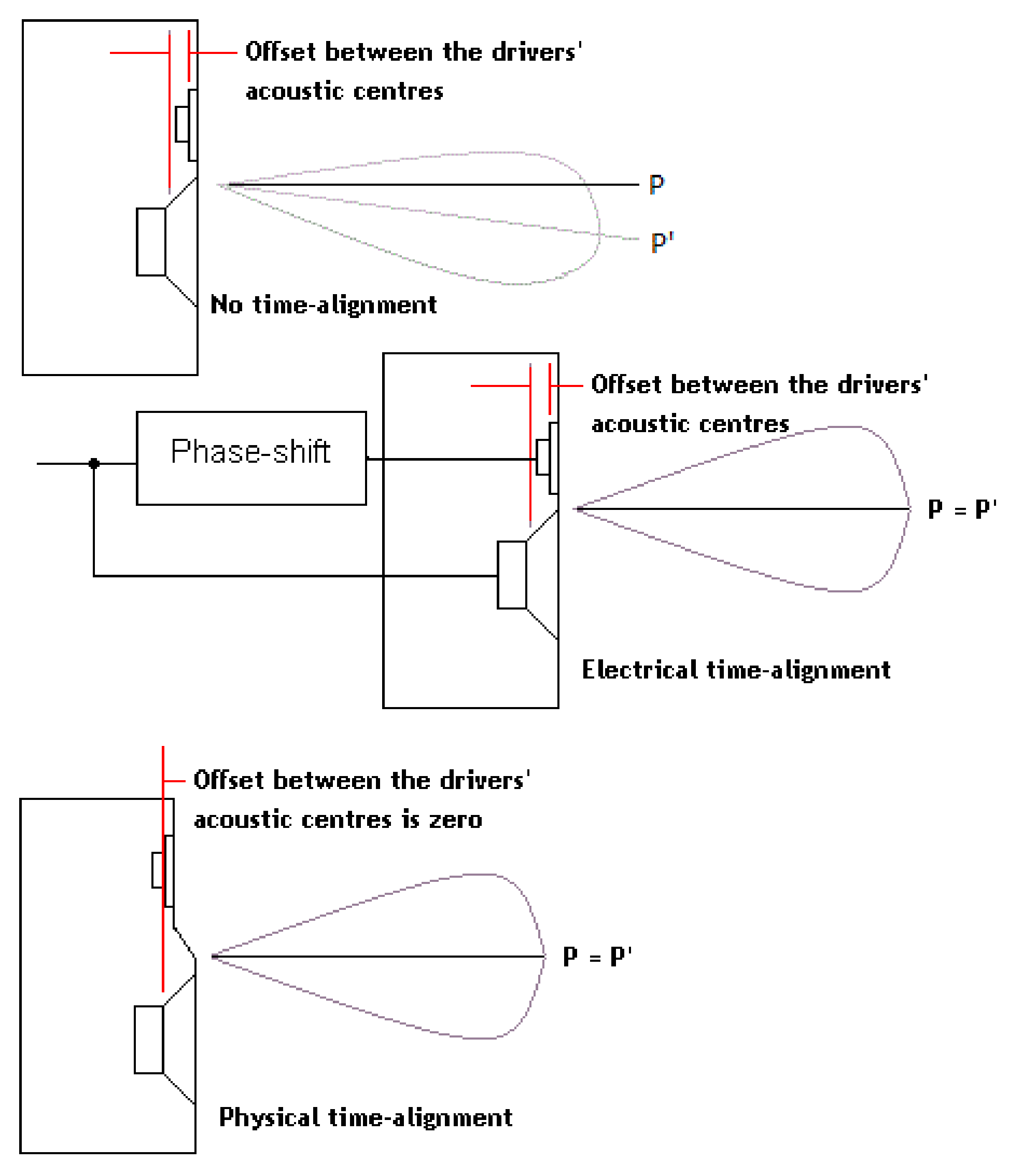 of the lobe) is a function of the difference or offset between the acoustic centers of the two drivers. In order to remedy this effect, a great deal of measurement and listening must take place. Correcting the time alignment in JWM speakers is not necessarily to achieve a perfect dead center alignment. It is however, another tool in my box for tuning any given design to perform well in most rooms. How often do you sit directly in front of your speakers and perfectly in line with their acoustic center? Never you say? I know!
of the lobe) is a function of the difference or offset between the acoustic centers of the two drivers. In order to remedy this effect, a great deal of measurement and listening must take place. Correcting the time alignment in JWM speakers is not necessarily to achieve a perfect dead center alignment. It is however, another tool in my box for tuning any given design to perform well in most rooms. How often do you sit directly in front of your speakers and perfectly in line with their acoustic center? Never you say? I know!
So why MTM for the AML Josh?
Well, you would think when another mid-range or mid woofer is added vertically and symmetrically opposite to the existing one, the result is that the tilted on-axis plane gets corrected such that the differences between the mid woofer and tweeter planes become immaterial - the on-axis plane is always w.r.t. the tweeter's center. Sure, it makes sense all right. But, time is not always on our side.
 The design requires that the two mid woofers are in exactly the same plane, and exactly the same distance from the tweeter - which is much easier to do physically than in the crossover. Up until recently, there has been a price to pay for this - although the MTM's on-axis response is near perfect, its radiation pattern or main lobe can be much narrower than that of the MT or TM configuration. As a result, the off-axis response (i.e., response at locations vertically away from exactly opposite the tweeter) should be much weaker. There can be obvious and discernible change in tonality at the crossover as one's listening height relative to the tweeter changes, and the effect is perceived more as the listener moves closer to the loudspeaker. In the Alyson AML and many other designs, this is corrected by (1) mounting the mid woofers as close to the tweeters as possible (so that the listening distance is much larger than the distance between the drivers) and (2) operating the mid woofers and tweeter in quadrature, i.e., achieved by ensuring that the tweeter lags the mid woofer by 90° in phase at the crossover frequency, and this in turn can be achieved if the crossover has a 3rd order Butterworth characteristic. To achieve the smallest distance between
The design requires that the two mid woofers are in exactly the same plane, and exactly the same distance from the tweeter - which is much easier to do physically than in the crossover. Up until recently, there has been a price to pay for this - although the MTM's on-axis response is near perfect, its radiation pattern or main lobe can be much narrower than that of the MT or TM configuration. As a result, the off-axis response (i.e., response at locations vertically away from exactly opposite the tweeter) should be much weaker. There can be obvious and discernible change in tonality at the crossover as one's listening height relative to the tweeter changes, and the effect is perceived more as the listener moves closer to the loudspeaker. In the Alyson AML and many other designs, this is corrected by (1) mounting the mid woofers as close to the tweeters as possible (so that the listening distance is much larger than the distance between the drivers) and (2) operating the mid woofers and tweeter in quadrature, i.e., achieved by ensuring that the tweeter lags the mid woofer by 90° in phase at the crossover frequency, and this in turn can be achieved if the crossover has a 3rd order Butterworth characteristic. To achieve the smallest distance between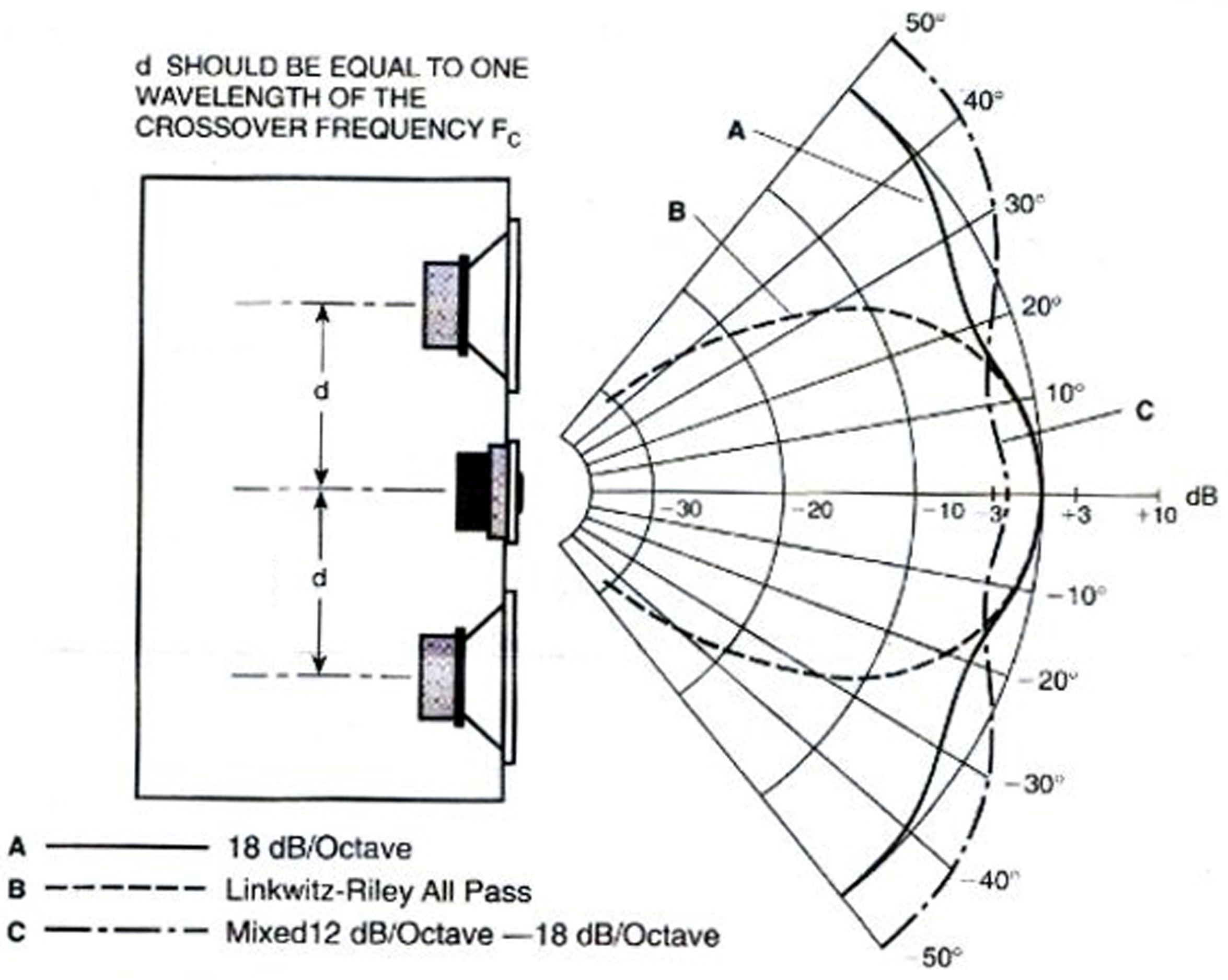 the mids and tweeters requires the drivers to have the smallest possible size - but there are design limitations to this (lowest mid-range frequency, for example, will place a lower limit to the mid's diameter). As you see in the Alyson AML, this small driver issue is not a problem, for there is a third way. (3) In conjunction with the other aforementioned methods, I also use the magic of wave guides and shallow horns to not only increase the width of the lobe, but much, much more. I can create a deeper stage effect, more focused dispersion pattern and a faster presentation. In addition the efficiency is increased substantially with the use of these wave guides. Voila!
the mids and tweeters requires the drivers to have the smallest possible size - but there are design limitations to this (lowest mid-range frequency, for example, will place a lower limit to the mid's diameter). As you see in the Alyson AML, this small driver issue is not a problem, for there is a third way. (3) In conjunction with the other aforementioned methods, I also use the magic of wave guides and shallow horns to not only increase the width of the lobe, but much, much more. I can create a deeper stage effect, more focused dispersion pattern and a faster presentation. In addition the efficiency is increased substantially with the use of these wave guides. Voila!
What is on the inside counts most:
I mentioned the inside of the Alyson AML being a whole other ball game. This is true. Not only does the shape play a crucial role in the design, so do the inside baffles, materials, and damping. In concert, (pun intended) the combination of all the above elements are tuned to the specific task of helping each other compress and release the back pressure of air within the cabinet. These elements must do so without one affecting the others performance through stray vibrations or standing waves within the interior chambers. This also is true of the driver components and electronics attached to the speakers. All work as one.
Let’s start with her curves baby:
There is a graceful curve to both the 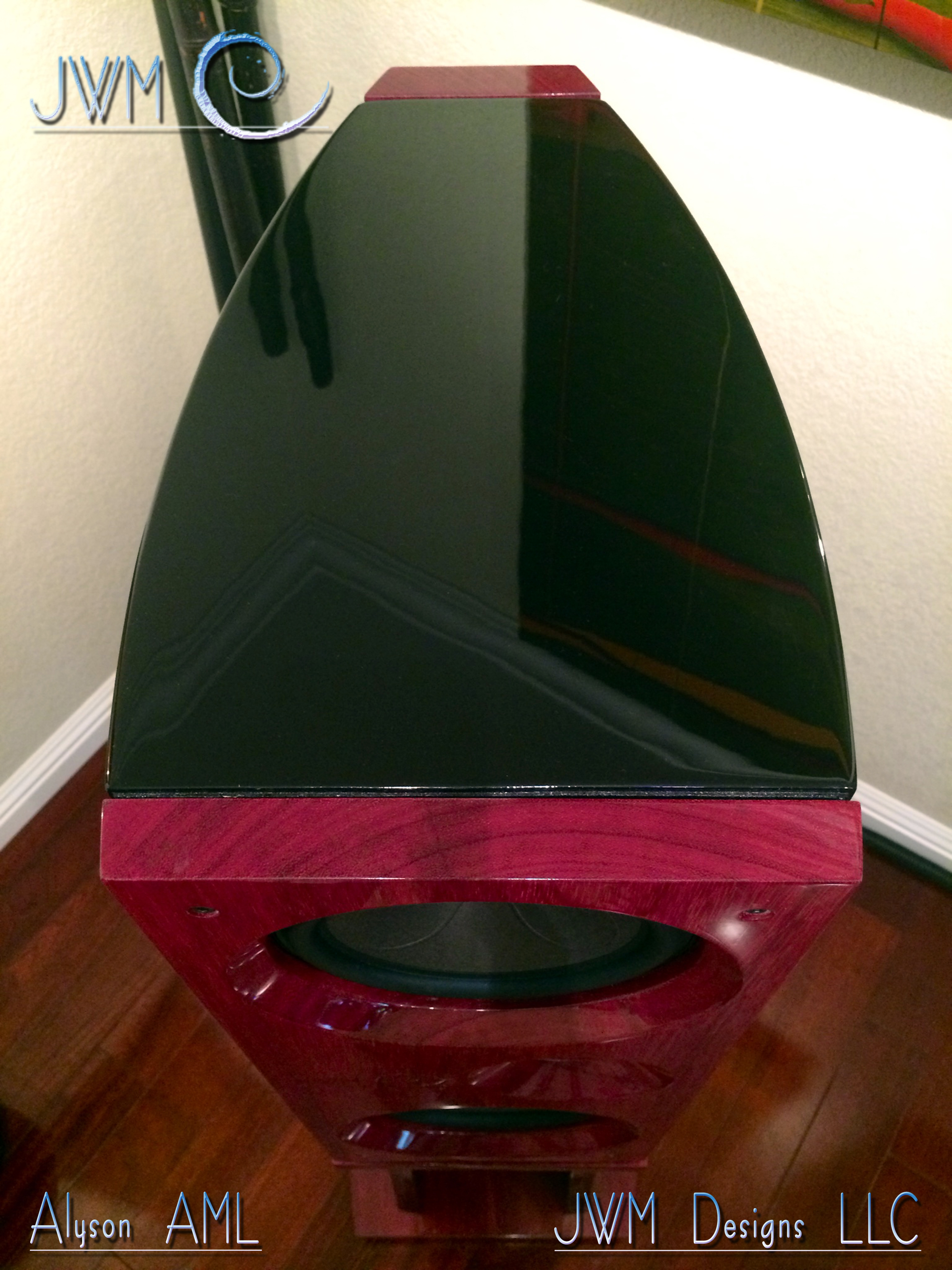 Net-1 and Alyson AML. In almost all curved cabinet speakers, the initial idea is to avoid standing waves between parallel surfaces inside the cabinet. This is true in my designs. This is but one reason for my utilization of the concept. The curved design also allows me to compress the back wave of the drivers into separate band pass cham
Net-1 and Alyson AML. In almost all curved cabinet speakers, the initial idea is to avoid standing waves between parallel surfaces inside the cabinet. This is true in my designs. This is but one reason for my utilization of the concept. The curved design also allows me to compress the back wave of the drivers into separate band pass cham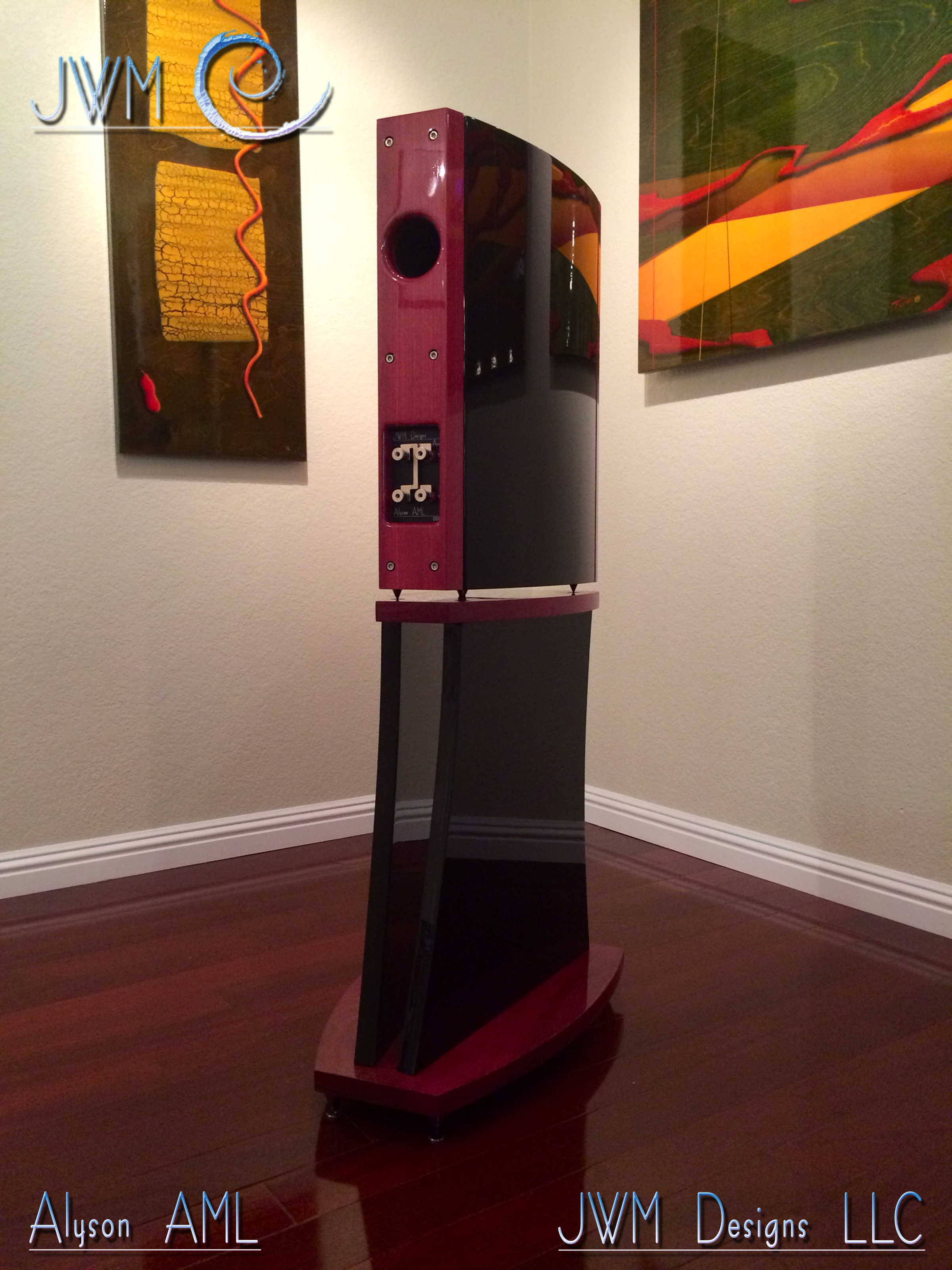 bers (two in this case) tuned to any frequency I desire. The most obvious drawback to most designers would be the speed of the rear exhaust being out of phase with the front of the speaker. You may have heard the effect in your average boom car going down the street. ONE NOTE BASS, SLOW AND OUT OF SYNC. Well, if you treat the port as an extension to the interior chambers and utilize it as a transmission line, it seems to speed things up and increase the overall efficiency of the lower frequencies! Voilà! What we have is a band pass transmission line design in a compact architecture. It gets way more complicated, but I’ll leave it at that for now.
bers (two in this case) tuned to any frequency I desire. The most obvious drawback to most designers would be the speed of the rear exhaust being out of phase with the front of the speaker. You may have heard the effect in your average boom car going down the street. ONE NOTE BASS, SLOW AND OUT OF SYNC. Well, if you treat the port as an extension to the interior chambers and utilize it as a transmission line, it seems to speed things up and increase the overall efficiency of the lower frequencies! Voilà! What we have is a band pass transmission line design in a compact architecture. It gets way more complicated, but I’ll leave it at that for now.
Make it beautiful inside and out:
I cannot stress enough the importance of the materials used in not only musical instruments, but musical speakers as well! After all, they do the same thing don’t they? At least they should. You would not expect a melamine violin to sound like the padauk one in first chair. Or a cardboard bass drum to have the same attack as the shaped maple beauty on the marching field. Thus, you will find no cardboard or melamine in my machines. What you will find is carefully chosen materials. These materials are selected for their damping abilities, resonant characteristics and so much more. My background in the visual arts and industrial design demand that materials I select must also sing to the eye. You would think it stops there, but no. Even the finish plays a crucial role in the overall sound of the machine. Just the specific lacquer used on a violin is crucial to its tone, so is true of the speaker. The bonus of this approach is obvious. The combination of art, audio and design create a product that will satisfy on a multitude of levels for many years to come.
Baffles, materials and taming the shrew:
Internally, all kinds of things take place that produce vibration and resonance. Some of these effects are desirable, some are not. I have spent a great deal of time deciding which should be exploited in my designs. I have spent equally as much energy in the pursuit of taming all of them with as little material as possible. Those materials are extremely important though. In some cases, even more essential than the cabinets themselves. Each has been selected from numerous manufactures for their ability to do precisely what I need them to do. No more, no less. Efficiency is the name of the game when taming resonance.
The curved cabinets and stand wing components are made from the same materials and finished in the same way as well. The reason for this was to create a symbiotic relationship between the stand and speaker cabinet. Both components have nearly the same mass and surface area, thus react to vibration in the same way. The shape of both allow for any unwanted stray resonance to be channeled silently down through the stand and terminate in the lower plate. In the rare case any further damping is required; the choice of spiked feet couples the units to the floor and bleeds the vibration away.
People and parrots like shiny things:

When it comes to the finish on the speakers and stands, I spare no expense. The bodies of the system and stand wings use a 12 layer process, followed by a 6 step polishing regiment. I utilize the latest conversion varnish technology. Each layer is sprayed, dried and sanded. The final coat is then sanded several times down to 3,000 grit. Next, final polishing begins. Polishing is also a labor of love and takes a minimum of 2 compounds before final polishing. This not only provides a durable and long lasting finish, it allows for a deep and rich mirror finish that rivals any piano manufacturer’s proprietary technique. The possibilities are endless as far as solid colors, but if the end user wishes, I can custom match any top finish with automotive lacquers and/or clear coated bases. As long as the damping factor of the coats fit within my acoustic parameters, I’m ready to play!!!

 The hardwood components of these systems are treated in the same way. Hardwoods are picked first for their acoustic properties, then beauty. Form must follow function in this case, but in every case thus far, the two have worked together perfectly. The very same 12 step process is used in the finishing of the hard wood components. Rather than using pigmented primers and bases, as in the body and wings, I use crystal clear sanding and leveling materials to start. Again, each layer must be dried, sanded and inspected before the next. The end result is worth every bit of sweat. Don’t forget, I can create these in any hardwood you wish, as long as it fits within my parameters of the ideal acoustic wood. No, Balsa will not work! Lol…
The hardwood components of these systems are treated in the same way. Hardwoods are picked first for their acoustic properties, then beauty. Form must follow function in this case, but in every case thus far, the two have worked together perfectly. The very same 12 step process is used in the finishing of the hard wood components. Rather than using pigmented primers and bases, as in the body and wings, I use crystal clear sanding and leveling materials to start. Again, each layer must be dried, sanded and inspected before the next. The end result is worth every bit of sweat. Don’t forget, I can create these in any hardwood you wish, as long as it fits within my parameters of the ideal acoustic wood. No, Balsa will not work! Lol…
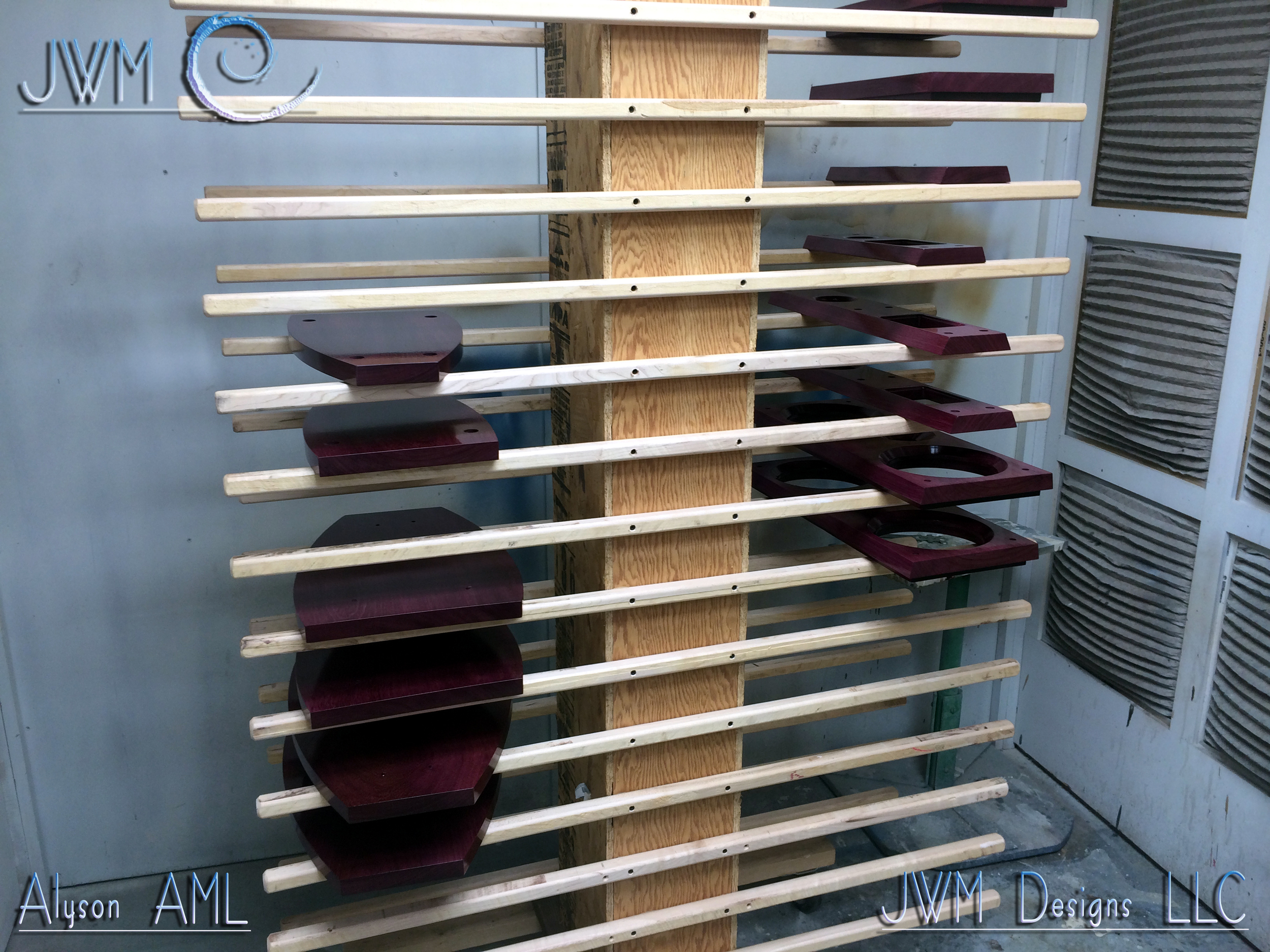 In the near future, I will be adding more visual options to each line of speakers. This will include custom veneers, hardwoods and a rainbow of colors to choose from. Depending on demand, I may also choose to keep custom automotive finishes on hand as standard practice. Stay tuned!
In the near future, I will be adding more visual options to each line of speakers. This will include custom veneers, hardwoods and a rainbow of colors to choose from. Depending on demand, I may also choose to keep custom automotive finishes on hand as standard practice. Stay tuned!
The bottom line of the Alyson AML:
My mission was threefold. First, to create a fast and efficient MTM design, utilizing a transmission line and band pass cabinet layout. Second, to provide many options to the end user in finishes and wood. Yes, a high “Wife Factor” coefficient is always a plus! There, I said it. They are easy on the eyes! Third, I believe it important to have my machines HAND MADE and manufactured in the USA! Yes, I have some parts made in Germany, Canada and Denmark, but I feel there is no manufacturer in the US for those certain parts, that can meet my demand for perfection. "YET"! As soon as that is possible, ALL of these systems in my collection will be made here at home in Hawaii. I feel satisfied that I have exceeded my objectives and confident that the listener will agree. As I said in the beginning of this post, These machines are to be picked as if they were a piano for your family. After all, I build them to last for many generations.
Alyson Aml...
Thank you,
Joshua W. Miles
Specifications: Frequency Response: 35-35,000Htz Short term max. power: 600 Watts Long term max. power: 450 Watts X-Over frequency: 2,500Htz Impedance: 4 Ohms Sensitivities: 89dB SPL Recommended amplifier: 40-400 Watts
Questions and Inquiries:
All questions and inquiries, including pricing can be directed to the fallowing addresses. All dealers are also welcome to call at any time. Systems will be available in person as well as at select locations in the very near future. Also, stay tuned for my personal on-line shop as well!
Joshua W. Miles Designs LLC PO BOX 944 Kailua, HI 96744 (808)349-6661 (808)421-9991 joshuawmilesdesigns@yahoo.com
Special Thanks:
I would like to send a special and warmhearted thank you to Thorben Wuttke. Owner and master woodworker for Honolulu Furniture Co. Without your MAD SKILLS and exceptional taste, these machines would still be just a scribble on a bar napkin. Much Mahalo!!!
References
- "Article by Rane discussing the Linkwitz-Riley crossover, time-alignment, lobing and correction of lobe tilt in TM or MT speaker configurations."
- "Biro Technology article showing lobe correction with MTM loudspeaker configuration, and other analyses"
- "Biro Technology article, section 3"
Record Review: The Cannonball Adderley Quintet in San Francisco featuring Nat Adderley
 In the words of Ani Difranco:
People used to make records
As in a record of an event
The event of people playing music in a room
In the words of Ani Difranco:
People used to make records
As in a record of an event
The event of people playing music in a room Now everything is cross-marketing
Its about sunglasses and shoes
Or guns and drugs
You choose
We got it rehashed
We got it half-assed
We're digging up all the graves
And we're spitting on the past
And you can choose between the colors
Of the lipstick on the whores
Cause we know the difference between
The font of 20% more
And the font of teriyaki
You tell me
How does it... make you feel?
Now everything is cross-marketing
Its about sunglasses and shoes
Or guns and drugs
You choose
We got it rehashed
We got it half-assed
We're digging up all the graves
And we're spitting on the past
And you can choose between the colors
Of the lipstick on the whores
Cause we know the difference between
The font of 20% more
And the font of teriyaki
You tell me
How does it... make you feel?
Not so good. Until I dug up this essential gem!
From “In San Francisco”:1959: Riverside RLP 12-311
Players:
Cannonball Adderley – Alto Sax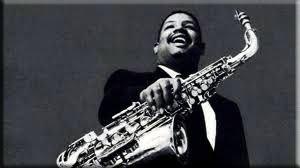 Nat Adderley – Cornet
Bobby Timmons – Piano
Sam Jones – Bass
Louis Hayes – Drums
Nat Adderley – Cornet
Bobby Timmons – Piano
Sam Jones – Bass
Louis Hayes – Drums
Scale from 1-5. Sonics: 4 Performance: 4.4 Availability: 3.1 Recommend: 5+
It is so easy to forget the greats. It is easier to forget the not so greats, commercialized on today’s charts simply because they wear Revlon, or drive a Jaguar. This over commercialized business was all but nonexistent in the 1950s. Oh it was there, just not being screamed at you from the 80 foot LED screens at every corner. There was a “Word of mouth” thing going on in the jazz scene of the 50s. Like when we used to talk with our neighbors, and let the kids come home when the street lights came on. A time when names like Miles got you tapping your feet before even hearing the needle drop. One sax player would run into another at the barber and whisper in his ear, “Pssst, you know Timmons is gana dig with Cannonball in da ally tonight. Be there at 6:00 sharp. I’ll hode da door”… I wish I had been alive back then. I most certainly would have scraped up everything I had to make the trek to this session. There was no need for anything but a faded poster glued to the bricks out back. No LEDs, no Revlon, no BMW either. Just jazz…
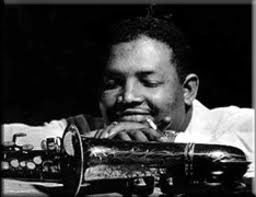 When Cannonball Adderley joined the Riverside label, he was assured that his still-unformed band would be recorded promptly, whenever and wherever he felt ready. The quintet, featuring Nat Adderley and Bobby Timmons, was assembled in 1959 and the promise was kept that October at San Francisco's Jazz Workshop. The memorable result is heard here and it's one of the most exciting, influential, and successful "live" recordings in modern jazz history.
When Cannonball Adderley joined the Riverside label, he was assured that his still-unformed band would be recorded promptly, whenever and wherever he felt ready. The quintet, featuring Nat Adderley and Bobby Timmons, was assembled in 1959 and the promise was kept that October at San Francisco's Jazz Workshop. The memorable result is heard here and it's one of the most exciting, influential, and successful "live" recordings in modern jazz history.
Without a doubt this is an essential jazz recording. The 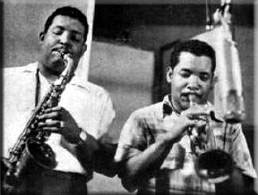 album was recorded live at The Jazz Workshop in San Francisco and released in 1959 on Riverside Records. Cannonball Adderley was just ending his extremely successful tenure with the Miles Davis Quintet (resulting in the classics “Round About Midnight”, “Milestones” and “Kind of Blue”) when his own group caught fire with this release. Joined by his brother Nat on Cornet as well as Bobby Timmons, Sam Jones and Louis Hayes, the group scored a monster hit with the Timmons track “This Here”. The rest of the album is just as solid and paved the way for a very fruitful period for Adderley and the various groups he would front over the next few years. Essentially, many said this recording was the “ONE” that made the man. I wasn’t around back then, but if I had been I would have had to agree. Having a name is one thing, but in this 50s jazz world, the proof was in the pudding.
album was recorded live at The Jazz Workshop in San Francisco and released in 1959 on Riverside Records. Cannonball Adderley was just ending his extremely successful tenure with the Miles Davis Quintet (resulting in the classics “Round About Midnight”, “Milestones” and “Kind of Blue”) when his own group caught fire with this release. Joined by his brother Nat on Cornet as well as Bobby Timmons, Sam Jones and Louis Hayes, the group scored a monster hit with the Timmons track “This Here”. The rest of the album is just as solid and paved the way for a very fruitful period for Adderley and the various groups he would front over the next few years. Essentially, many said this recording was the “ONE” that made the man. I wasn’t around back then, but if I had been I would have had to agree. Having a name is one thing, but in this 50s jazz world, the proof was in the pudding.
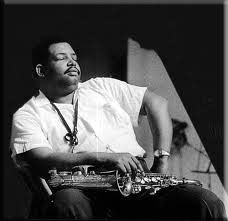 I would have to agree with the idea that this groundbreaking album launched "soul jazz", according to NPR, bridging "the gap between bebop and funk". Producer and jazz critic Orrin Keepnews described the album as "the birth of contemporary live recording" and in May 1960, Time noted that the album's then 50,000 copies sold was "phenomenal for a jazz record", raising the album to the bestseller charts. Music critic Scott Yanow describes the album as a "gem […] essential for all jazz collections." I couldn’t agree more. From the first few rhythms on “This Here”, I knew there was something special about to happen in my listening room. I was wrong; it hit me deeper as the tune began to grow. By six minutes into this twelve minute track, I was no longer sitting in my chair. I was standing back of it, in total bliss. I believe I picked up a set of drum sticks and just held them in front of me, eyes closed, frozen in the moment. Wow…
I would have to agree with the idea that this groundbreaking album launched "soul jazz", according to NPR, bridging "the gap between bebop and funk". Producer and jazz critic Orrin Keepnews described the album as "the birth of contemporary live recording" and in May 1960, Time noted that the album's then 50,000 copies sold was "phenomenal for a jazz record", raising the album to the bestseller charts. Music critic Scott Yanow describes the album as a "gem […] essential for all jazz collections." I couldn’t agree more. From the first few rhythms on “This Here”, I knew there was something special about to happen in my listening room. I was wrong; it hit me deeper as the tune began to grow. By six minutes into this twelve minute track, I was no longer sitting in my chair. I was standing back of it, in total bliss. I believe I picked up a set of drum sticks and just held them in front of me, eyes closed, frozen in the moment. Wow…
 The album was originally released by Riverside Records; the album has been reissued on CD several times since 1991 by Riverside and OJC. Remastered versions of the album include extended cuts of several of the songs on the original, including the retitled "(A Few Words by Cannonball...And) This Here". I have the original copy in front of me. I have listened to the CD release, yet firmly believe the vinyl is a far better way to take in this stellar record. In the late 50s and early 60s Cannonball enjoyed unparalleled popularity, marked by the commercially successful Riverside releases of first his quintet and later his sextet (Yusef Lateef was the 3rd horn). The sessions were frequently recorded live, included spoken introductions by the ebullient Cannonball, featured mostly "accessible" tunes, and showcased at least one crowd-pleaser (This Here, Sack of Woe, Jive Samba, Mercy Mercy) that was also released as a hit single.
The album was originally released by Riverside Records; the album has been reissued on CD several times since 1991 by Riverside and OJC. Remastered versions of the album include extended cuts of several of the songs on the original, including the retitled "(A Few Words by Cannonball...And) This Here". I have the original copy in front of me. I have listened to the CD release, yet firmly believe the vinyl is a far better way to take in this stellar record. In the late 50s and early 60s Cannonball enjoyed unparalleled popularity, marked by the commercially successful Riverside releases of first his quintet and later his sextet (Yusef Lateef was the 3rd horn). The sessions were frequently recorded live, included spoken introductions by the ebullient Cannonball, featured mostly "accessible" tunes, and showcased at least one crowd-pleaser (This Here, Sack of Woe, Jive Samba, Mercy Mercy) that was also released as a hit single.
 These sessions are memorable less for the individual solos than the fire of the ensemble, anchored and propelled by perhaps the best walking bass player in the business, Sam Jones. When I listen to these recordings, I can't help but lament the absence of such ensembles on the scene today as well as be reminded of the relatively tough times Cannonball would encounter in the late 60s and early 70s, when he had trouble booking the group. How is that possible? If only those clubs knew then what we do now. There is no doubt it would be the other way around with this sudden interest in 50s jazz amongst a younger generation now. A happy thing indeed, but possibly too late. Who do we have that can stand out like the musicians on this album today? Let me know if you find some. I need more!!!
These sessions are memorable less for the individual solos than the fire of the ensemble, anchored and propelled by perhaps the best walking bass player in the business, Sam Jones. When I listen to these recordings, I can't help but lament the absence of such ensembles on the scene today as well as be reminded of the relatively tough times Cannonball would encounter in the late 60s and early 70s, when he had trouble booking the group. How is that possible? If only those clubs knew then what we do now. There is no doubt it would be the other way around with this sudden interest in 50s jazz amongst a younger generation now. A happy thing indeed, but possibly too late. Who do we have that can stand out like the musicians on this album today? Let me know if you find some. I need more!!!
"Live in San Francisco" is an exemplary session,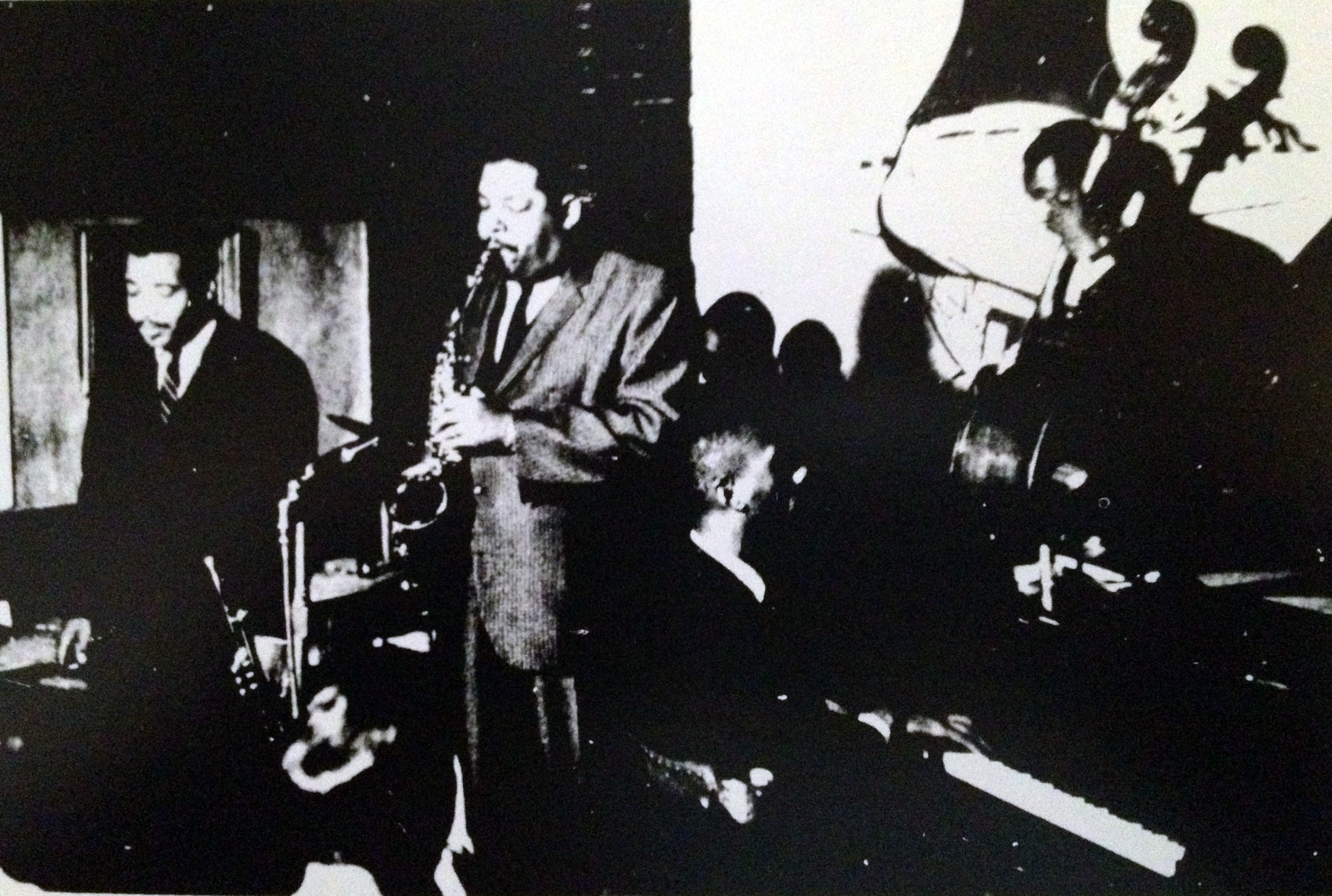 certainly the equal of any of the other recordings by Cannonball with his own group. If a choice is to be made, another unnamed reviewer stated, “I would personally favor the recordings with Victor Feldman on piano, rather than Joe Zawinul or Bobby Timmons, the pianist on this particular session.” I can’t say I would agree. The group is the group on those numbers. You change just one element and it becomes something entirely different. One change and this album may have never been recorded. Regardless, with the renewed interest in "acoustic" straight-ahead jazz, any of the recordings should be required listening for the ensemble sound alone. Rarely have I heard such a synergy between members of similar groups today. It just worked…
certainly the equal of any of the other recordings by Cannonball with his own group. If a choice is to be made, another unnamed reviewer stated, “I would personally favor the recordings with Victor Feldman on piano, rather than Joe Zawinul or Bobby Timmons, the pianist on this particular session.” I can’t say I would agree. The group is the group on those numbers. You change just one element and it becomes something entirely different. One change and this album may have never been recorded. Regardless, with the renewed interest in "acoustic" straight-ahead jazz, any of the recordings should be required listening for the ensemble sound alone. Rarely have I heard such a synergy between members of similar groups today. It just worked…
 Like I said before, the tone was set with "This Here" and rocked the house with "Spontaneous Combustion". The solos by each member of the Quintet were fantastic. It was an opportunity to see Bobby Timmons who did the arrangements for "This Here" or as Cannonball stated he "corrupted" it to be "Dis Hear." What I liked about the LP (and now the CD) is that each song was not edited, the songs were allowed to the full length as was performed live. The unity of this group absolutely did bring down the house as, now the LP is doing the same in my home. It was amazing how the group would play in three quarter time with such precision that it makes a person jump-up and dance. (Or stand there with drool on your chin and a set of sticks in your hand like me. (Dork)
Like I said before, the tone was set with "This Here" and rocked the house with "Spontaneous Combustion". The solos by each member of the Quintet were fantastic. It was an opportunity to see Bobby Timmons who did the arrangements for "This Here" or as Cannonball stated he "corrupted" it to be "Dis Hear." What I liked about the LP (and now the CD) is that each song was not edited, the songs were allowed to the full length as was performed live. The unity of this group absolutely did bring down the house as, now the LP is doing the same in my home. It was amazing how the group would play in three quarter time with such precision that it makes a person jump-up and dance. (Or stand there with drool on your chin and a set of sticks in your hand like me. (Dork)
 Bobby Timmons solo on "Spontaneous Combustion," had more than a bit of "church gospel and R&B" in it. Putting hands in the air and letting out the occasional “Praise the Lord” is entirely acceptable behavior for this tune. It reminds me of when I would ride my bike down to a small black church on 17th street in Galveston Texas. It had a small white picket fence where I could lean up my bike, hop over and sit under a side window unnoticed. I could sit there for hours and hours, just letting the Sunday pass with the sweetest sounds of gospel filling my ears. I miss that time dearly and this brings it all home for me. Julian "Cannonball" Adderley and brother "Nat" Adderley complemented each other while playing together or on solo. The Quintet was welded together in all six of the selections and is great for the ears. "Cannonball" had incredibly rhythmic solos, "Nat’s" jubilant playing accented by drummer Louis Hayes and bass player Sam Jones on most of the numbers, really moved those in attendance inside and those outside of the Jazz Workshop. Now, it moves me all the way out here on the rocks of Hawaii. Modern technology “ROCKS”!!!
Bobby Timmons solo on "Spontaneous Combustion," had more than a bit of "church gospel and R&B" in it. Putting hands in the air and letting out the occasional “Praise the Lord” is entirely acceptable behavior for this tune. It reminds me of when I would ride my bike down to a small black church on 17th street in Galveston Texas. It had a small white picket fence where I could lean up my bike, hop over and sit under a side window unnoticed. I could sit there for hours and hours, just letting the Sunday pass with the sweetest sounds of gospel filling my ears. I miss that time dearly and this brings it all home for me. Julian "Cannonball" Adderley and brother "Nat" Adderley complemented each other while playing together or on solo. The Quintet was welded together in all six of the selections and is great for the ears. "Cannonball" had incredibly rhythmic solos, "Nat’s" jubilant playing accented by drummer Louis Hayes and bass player Sam Jones on most of the numbers, really moved those in attendance inside and those outside of the Jazz Workshop. Now, it moves me all the way out here on the rocks of Hawaii. Modern technology “ROCKS”!!!
 I know I could live with this album for a lifetime. It is truly one of those rare pieces of history that changed everything. All jazz lovers will miss "Cannonball" and his brother "Nat." In the meantime we are given these beautiful recordings of the group’s appearance in San Francisco's Jazz Workshop. This album shows why Adderley's group was a pacesetter in funky soul-jazz and proving that they could outswing most of their competition. DO NOT pass this one up while flipping through the stacks at the record shop. It is an absolute MUST for any Jazz collection. Actually, for any collection period… This gem is essential!!!!
I know I could live with this album for a lifetime. It is truly one of those rare pieces of history that changed everything. All jazz lovers will miss "Cannonball" and his brother "Nat." In the meantime we are given these beautiful recordings of the group’s appearance in San Francisco's Jazz Workshop. This album shows why Adderley's group was a pacesetter in funky soul-jazz and proving that they could outswing most of their competition. DO NOT pass this one up while flipping through the stacks at the record shop. It is an absolute MUST for any Jazz collection. Actually, for any collection period… This gem is essential!!!!
Keep your records clean ya’ll!!!
JWM
PS. The recording itself, is stellar as well…
Associated equipment: Analog: JWM Designs LLC MAG-lv/VPI/Rega/SL-1200/Funkfirm/SME Turntable (Custom built) Shelter 201, Ortofon 2M Red and 2M Blue, Shure 97XE phono cartages Hitachi FT-2 Tuner (Custom modified JWM Designs LLC) Digital: Oppo HD 980H, HP dv7-4183cl Notebook (extensively modified JWM Designs LLC) Amplification: Musical Fidelity XA-1 (Custom modified JWM Designs LLC) McIntosh MC2105 and MC2125 amplifiers (Custom modified JWM Designs LLC) Sound Craftsman DC2215 Differential/Comparator Equalizer Speakers: Klipsch Cornwall II (Custom built)Front Klipsch Tangent T50 (Custom built) Rear JWM Designs LLC JMSW12 Servo driven subwoofers (X-2) Each with 1,340 watt custom built HYPEX digital amplifiers Cables: Audio Quest Columbia and Colorado interconnects Kimber Kable 12HT speaker cables Audio Quest NRG-4 IEC power cables Dedicated 200A power source from mains panel feeding PS Audio Power Port Classics 20A 1 bottle of Barefoot Moscato!
Why Analog?
 So, I have several friends asking me why I am still so adamant about analog recordings and playback. After about 3 seconds of vinyl from my system, they say “OH”! “That’s why”! Then, usually a few “ARE YOU KIDDING ME’s”, ”THAT’S A RECORD’s” come out. Something happens in the room. Nine times out of ten, after a few short moments, the conversations in the room diminish. The talk of politics, fine wine, religion and the blow-by-blow of the cruise your friend just got back from are silenced. You see, there is something magical about analog playback. It demands your attention. So rarely have I seen this same reaction when a CD, or file is being played. The conversations continue with music simply becoming a white noise back ground to the evening. Not so with records or LP’s. Something happens to the air in the room and the music takes front row to the evening. People listen… I have many jargon laden theories for this, but I‘ll try not to get too technical here. Instead, I’ll Just Try to keep it simple and possibly spark an argument about why analog is so beautiful.
So, I have several friends asking me why I am still so adamant about analog recordings and playback. After about 3 seconds of vinyl from my system, they say “OH”! “That’s why”! Then, usually a few “ARE YOU KIDDING ME’s”, ”THAT’S A RECORD’s” come out. Something happens in the room. Nine times out of ten, after a few short moments, the conversations in the room diminish. The talk of politics, fine wine, religion and the blow-by-blow of the cruise your friend just got back from are silenced. You see, there is something magical about analog playback. It demands your attention. So rarely have I seen this same reaction when a CD, or file is being played. The conversations continue with music simply becoming a white noise back ground to the evening. Not so with records or LP’s. Something happens to the air in the room and the music takes front row to the evening. People listen… I have many jargon laden theories for this, but I‘ll try not to get too technical here. Instead, I’ll Just Try to keep it simple and possibly spark an argument about why analog is so beautiful.
Why analog? We live in an age where so many amazing machines are capable of reproducing some of the most amazing sounds. We live in an age where bits are bits rite? Not so fast amigo. We live in an analog world don’t we? To this day, with all this technology and I’ve heard the best, we still have not been able to conquer absolute nature and physics as it pertains to vibrations in sound. After all, that is what sound is. Vibrations in the air. Air that is excited by the instrument being played. Not just one vibration though. Many vibrations working with and against each other either in harmony, or in conflict. The conflicting and resonant values that emerge ARE what make the difference between “Live” and “Memorex”. I call this “Harmonic Conflict” Some engineers call it “Dynamic Harmonics”, others “Dynamic Resonance” or “Emotional Dynamics”. Something the digital world has yet to see, or “HEAR”.
 If we cannot reproduce all the small nuances of each and every “Harmonic Conflict”, we lose the “Live” performance. These small details ARE what make the sound “LIVE”. For example, we hear a live band and get an emotional contact with the performers. This is not only due to the performance, but to the environment we are observing the performance within. The echoes from the back of the hall. The small reflection of sound coming from the rear of the bass stack that bounces off the front of the bass drum at just the right angle. The vibrations in the plastic seats. The cough, the clinking glass, the flutter and squeak of rosin that may not be heard on the digital kit, but cannot escape the magnetic tape. Well, you may hear the squeak, but not the way that squeak bounces about the room and the air that surrounds it. Even more difficult in the digital realm is that air around the squeak. The color and texture of it. Something that comes natural in the analog world.
If we cannot reproduce all the small nuances of each and every “Harmonic Conflict”, we lose the “Live” performance. These small details ARE what make the sound “LIVE”. For example, we hear a live band and get an emotional contact with the performers. This is not only due to the performance, but to the environment we are observing the performance within. The echoes from the back of the hall. The small reflection of sound coming from the rear of the bass stack that bounces off the front of the bass drum at just the right angle. The vibrations in the plastic seats. The cough, the clinking glass, the flutter and squeak of rosin that may not be heard on the digital kit, but cannot escape the magnetic tape. Well, you may hear the squeak, but not the way that squeak bounces about the room and the air that surrounds it. Even more difficult in the digital realm is that air around the squeak. The color and texture of it. Something that comes natural in the analog world.
 Yes, magnetic tape I say is absolutely just as analog as the vibrations in the air. You see, the tiny flecks of magnetic material are there to be laid out in a pattern which reflects exactly what the live performance is. An analog copy of the air that is being exited by the instruments on the stage. Vibrational butterflys caught in a magnetic net if you will. In a perfect world, which this can be, the wings of that butterfly can be observed over and over again without damaging there iridescence. Yes! That’s it! Iridescence of the sound is what the digital world has yet to conquer! (Ahhhh, that took some time.)
Yes, magnetic tape I say is absolutely just as analog as the vibrations in the air. You see, the tiny flecks of magnetic material are there to be laid out in a pattern which reflects exactly what the live performance is. An analog copy of the air that is being exited by the instruments on the stage. Vibrational butterflys caught in a magnetic net if you will. In a perfect world, which this can be, the wings of that butterfly can be observed over and over again without damaging there iridescence. Yes! That’s it! Iridescence of the sound is what the digital world has yet to conquer! (Ahhhh, that took some time.)
 Why, you ask? It’s not a simple answer, but I’ll try. You see, vibration is complicated. When we are talking about live music, we are dealing with many layers of vibration. Layer on layer on layer, perhaps till 1,000 layers or more, for the simple sound of rosin on a bow. To recreate the sound of something as simple a E string on the guitar, there may be as many as 10,000 layers! Now, Take these layers and lay them out on a graph. First at the bottom, 10,000 at the top. Left of the graph is 0 seconds; right of the graph is 5 seconds. (Big exaggeration for this purpose)When we first pluck the string, there is a wave that is created. That wave is made up of many vibrations. Each is dependent on the material of the string, the way it was plucked and the fingernail polish the musician put on this morning, amongst other factors. Part of that wave at 1.5 seconds may react as a harmonic or conflict with a vibration at 1.9 seconds. This meeting of vibrations is bound to create another vibration all together! Then another at 2.5 second, 3.4 seconds 4.7 seconds and so on. (Again, big exaggeration) Each of these will create the “E” we are so familiar with. Now add the acoustical environment itself into the mix. Each of these original vibrations must now react with the room. That room has its own set of resonant frequencies as well. We call these modes. In other words, That “E” aint just an “E” after all. This is the iridescent sound I spoke of earlier. Not just one wave of equal vibration, but an ever growing and evolving tone which slowly builds within the room, then decays into silence again. Try to picture this mixed with 300 more plucks of the strings in different scales. It becomes an absolutely absurd amount of information. To this day, no digital device has been created that will take that 1.2 second wave and harmonize it with the 3.7 second wave, account for the room modes and the color of polish on the musicians nails. Instead, all those processors see is a constant flow of ones and zeroes. No nuance, no emotion, just dots and dashes.
Why, you ask? It’s not a simple answer, but I’ll try. You see, vibration is complicated. When we are talking about live music, we are dealing with many layers of vibration. Layer on layer on layer, perhaps till 1,000 layers or more, for the simple sound of rosin on a bow. To recreate the sound of something as simple a E string on the guitar, there may be as many as 10,000 layers! Now, Take these layers and lay them out on a graph. First at the bottom, 10,000 at the top. Left of the graph is 0 seconds; right of the graph is 5 seconds. (Big exaggeration for this purpose)When we first pluck the string, there is a wave that is created. That wave is made up of many vibrations. Each is dependent on the material of the string, the way it was plucked and the fingernail polish the musician put on this morning, amongst other factors. Part of that wave at 1.5 seconds may react as a harmonic or conflict with a vibration at 1.9 seconds. This meeting of vibrations is bound to create another vibration all together! Then another at 2.5 second, 3.4 seconds 4.7 seconds and so on. (Again, big exaggeration) Each of these will create the “E” we are so familiar with. Now add the acoustical environment itself into the mix. Each of these original vibrations must now react with the room. That room has its own set of resonant frequencies as well. We call these modes. In other words, That “E” aint just an “E” after all. This is the iridescent sound I spoke of earlier. Not just one wave of equal vibration, but an ever growing and evolving tone which slowly builds within the room, then decays into silence again. Try to picture this mixed with 300 more plucks of the strings in different scales. It becomes an absolutely absurd amount of information. To this day, no digital device has been created that will take that 1.2 second wave and harmonize it with the 3.7 second wave, account for the room modes and the color of polish on the musicians nails. Instead, all those processors see is a constant flow of ones and zeroes. No nuance, no emotion, just dots and dashes.
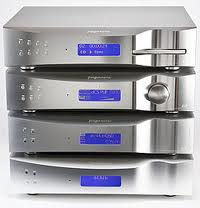 The digital realm is getting closer as processing speeds get faster, but any “Live” sound we hear from this format is usually an algorithm created by a programmer or engineer. In the case of DCS, a fantastic digital company on the cutting edge of digital reproduction, (and a few select others) it has become an art form all its own. Effectively so, at that! I have yet to hear better or closer to analog from any other machines other than DCS. In other words, I am not opposed to digital in any way! It is a fantastic tool that gets better every day. Unfortunately, there will always be a limit to this madness. In the analog world, there is no limit what so ever! All those layers on the graph are able to dance about as they wish, with no limit to the amount of bits and bytes they can be compressed into. “LIVE”! Nowhere in nature, did a super computer dictate just how loud and with how much attack and decay Krakatoa would erupt.
The digital realm is getting closer as processing speeds get faster, but any “Live” sound we hear from this format is usually an algorithm created by a programmer or engineer. In the case of DCS, a fantastic digital company on the cutting edge of digital reproduction, (and a few select others) it has become an art form all its own. Effectively so, at that! I have yet to hear better or closer to analog from any other machines other than DCS. In other words, I am not opposed to digital in any way! It is a fantastic tool that gets better every day. Unfortunately, there will always be a limit to this madness. In the analog world, there is no limit what so ever! All those layers on the graph are able to dance about as they wish, with no limit to the amount of bits and bytes they can be compressed into. “LIVE”! Nowhere in nature, did a super computer dictate just how loud and with how much attack and decay Krakatoa would erupt. Nowhere in nature was there a hard drive that stated, you can only record between 20 and 20,000 HTZ. And at 98 dB for that matter. Analog has no limitations on the nuance of a real performance. The only limit is to the dynamic capability of the medium. As technology has it, even in 1955, we could have recorded the sound of Krakatoa, quite believably and with little effort. With modern tape we could have scared the crap out of God. No joke. This is simply not possible in most modern digital studios though. I say most, for there are machines that could do it well, just not with the reality of the actual Dynamic Conflicts of such a sound. It’s just too big for anything but analog. HA!
Nowhere in nature was there a hard drive that stated, you can only record between 20 and 20,000 HTZ. And at 98 dB for that matter. Analog has no limitations on the nuance of a real performance. The only limit is to the dynamic capability of the medium. As technology has it, even in 1955, we could have recorded the sound of Krakatoa, quite believably and with little effort. With modern tape we could have scared the crap out of God. No joke. This is simply not possible in most modern digital studios though. I say most, for there are machines that could do it well, just not with the reality of the actual Dynamic Conflicts of such a sound. It’s just too big for anything but analog. HA!
 Now, the play-back part. Analog is all about real world sound. Not digitized fax printed in dots and dashes, or ones and zeros. Again, we live in an analog world don’t we? Is the sound of a slightly out of tune Oboe playing 5 rows in front of you a digital image? No. Is the dog barking just over the fence a digital recording played through a small speaker hanging on his colar? No. So is music vibration? Yes! Vibration that is, if properly recorded in the ANALOG realm. A well-tuned turntable and cartridge/preamp/amp/speaker kit will pick up those EXACT same vibrations. This is true recording/play-back as the rules of physics and nature dictate. Not some processor in a laptop. (Don’t get me wrong, I record most of my albums from my turntables to a hard drive. This is for convenience only. I like to hear vinyl at the beach as well!) LP play-back is a tiny needle picking up those same vibrations from a groove in a record. That vibration is transmitted up the cantilever to a magnetic coil, much like the tape I mentioned earlier. That signal is then sent to the rest of your kit, ultimately ending up in another magnetic device called a transducer. (Your speaker)That speaker vibrates the air just like the instrument vibrated the microphone on the other end of the chain! Simple!!! Analog!!!
Now, the play-back part. Analog is all about real world sound. Not digitized fax printed in dots and dashes, or ones and zeros. Again, we live in an analog world don’t we? Is the sound of a slightly out of tune Oboe playing 5 rows in front of you a digital image? No. Is the dog barking just over the fence a digital recording played through a small speaker hanging on his colar? No. So is music vibration? Yes! Vibration that is, if properly recorded in the ANALOG realm. A well-tuned turntable and cartridge/preamp/amp/speaker kit will pick up those EXACT same vibrations. This is true recording/play-back as the rules of physics and nature dictate. Not some processor in a laptop. (Don’t get me wrong, I record most of my albums from my turntables to a hard drive. This is for convenience only. I like to hear vinyl at the beach as well!) LP play-back is a tiny needle picking up those same vibrations from a groove in a record. That vibration is transmitted up the cantilever to a magnetic coil, much like the tape I mentioned earlier. That signal is then sent to the rest of your kit, ultimately ending up in another magnetic device called a transducer. (Your speaker)That speaker vibrates the air just like the instrument vibrated the microphone on the other end of the chain! Simple!!! Analog!!!
 Trouble with this business is, the majority of LPs sold to audiophiles are old titles. VERY old titles. A catalog in which one sees an overabundance of such christian names as Miles and Jimi and Ella and Pink: Great old stuff, but we already have it. Some great new stuff is available on vinyl, too: Bonnie Prince Billy, the Spoons, Joanna Newsome, Punch Brothers, Michael Tilson, Thomas and the San Francisco Symphony. Trouble is, all of them are digital recordings. And while I’m grateful when a record company prints a small percentage of their titles on vinyl, the miracle is scarcely different from when book publishers print a small percentage of their books in large print additions. The vast majority though, are released as crappy MP3 or some other compressed format. But even that is not such a big deal: I may be thin skinned, but as long as I can buy what I want, I don’t particularly care why it is being sold. The problem is, an analog pressing of a digital recording is still a digital recording. And the “Better” the mastering job, the more digital the results will be. If you leave a pointillist watercolor out in the rain, dots will run. But there still just dots.
Trouble with this business is, the majority of LPs sold to audiophiles are old titles. VERY old titles. A catalog in which one sees an overabundance of such christian names as Miles and Jimi and Ella and Pink: Great old stuff, but we already have it. Some great new stuff is available on vinyl, too: Bonnie Prince Billy, the Spoons, Joanna Newsome, Punch Brothers, Michael Tilson, Thomas and the San Francisco Symphony. Trouble is, all of them are digital recordings. And while I’m grateful when a record company prints a small percentage of their titles on vinyl, the miracle is scarcely different from when book publishers print a small percentage of their books in large print additions. The vast majority though, are released as crappy MP3 or some other compressed format. But even that is not such a big deal: I may be thin skinned, but as long as I can buy what I want, I don’t particularly care why it is being sold. The problem is, an analog pressing of a digital recording is still a digital recording. And the “Better” the mastering job, the more digital the results will be. If you leave a pointillist watercolor out in the rain, dots will run. But there still just dots.
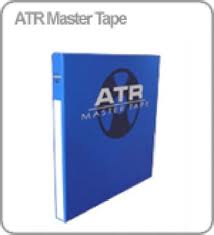 Between the years of 2005-2007 there was no magnetic tape being made. PERIOD. In 2008 an American company called ATR began making tape, primarily for the pro market. THIS WAS GREAT NEWS FOR THE ANALOG FANS!!!! Now in its fourth year-the company also services and remanufactures AMPEX ATR 102 studio decks, (standard of the industry) and has done so since 1991-the company has yet to turn a profit, but a number of grateful engineers and recording artists have praised there work. GOD helps them to carry on the good work…
Between the years of 2005-2007 there was no magnetic tape being made. PERIOD. In 2008 an American company called ATR began making tape, primarily for the pro market. THIS WAS GREAT NEWS FOR THE ANALOG FANS!!!! Now in its fourth year-the company also services and remanufactures AMPEX ATR 102 studio decks, (standard of the industry) and has done so since 1991-the company has yet to turn a profit, but a number of grateful engineers and recording artists have praised there work. GOD helps them to carry on the good work…
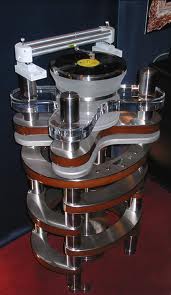 When looking for vinyl, used or new, I look to see if the recording was made in the analog realm originally. Not hard if you are a 1950s jazz nut like me. I also look for the company who pressed it and the producer who put down the final mixed goodies. All make a difference. One silly rule of mine: if I find two copies of the same record, one pressed in the US between 1965-1988, and the other pressed in Europe at any time, the one pressed overseas is the choice. Generally they are 180-200 gram vinyl and are of a much higher quality. These days, most of what you see in re-prints, whether from the US or not, is in 180-200 gram vinyl anyway! I have to give props to this latest generation of engineers for this trend. More and more are being pressed in a phenomenal quality here at home in the USA!!! The pressings I have experienced lately are fantastic! Better than ever as far as I am concerned. Bigger grooves, more released in 45Rpm versions! Quieter and blacker backgrounds yielding more room for the music and system to sing! This is really looking promising for us fans of the big black disk! There are many more things to look for when buying records, but I’ll leave that to a later blog.
When looking for vinyl, used or new, I look to see if the recording was made in the analog realm originally. Not hard if you are a 1950s jazz nut like me. I also look for the company who pressed it and the producer who put down the final mixed goodies. All make a difference. One silly rule of mine: if I find two copies of the same record, one pressed in the US between 1965-1988, and the other pressed in Europe at any time, the one pressed overseas is the choice. Generally they are 180-200 gram vinyl and are of a much higher quality. These days, most of what you see in re-prints, whether from the US or not, is in 180-200 gram vinyl anyway! I have to give props to this latest generation of engineers for this trend. More and more are being pressed in a phenomenal quality here at home in the USA!!! The pressings I have experienced lately are fantastic! Better than ever as far as I am concerned. Bigger grooves, more released in 45Rpm versions! Quieter and blacker backgrounds yielding more room for the music and system to sing! This is really looking promising for us fans of the big black disk! There are many more things to look for when buying records, but I’ll leave that to a later blog.
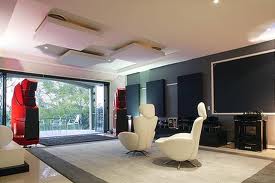 Look, I guess the simple answer to whether analog, or digital is the way for you to go is, does it move you? Does it bring back a memory? Can it suck you in and evoke an emotional response? Does it make you smile, or frown and sniffle in other words. Does the music demand your attention? Do the guests in the room go quiet and just listen? That is what music is really supposed to do. It can be either medium as far as I’m concerned, just as long as it gives me that sense of “LIVE” I crave. I just happen to get that feeling from the big black disk. More now, than ever before. So, "Is it real, or is it Memorex"? End of story? Perhaps not…
Look, I guess the simple answer to whether analog, or digital is the way for you to go is, does it move you? Does it bring back a memory? Can it suck you in and evoke an emotional response? Does it make you smile, or frown and sniffle in other words. Does the music demand your attention? Do the guests in the room go quiet and just listen? That is what music is really supposed to do. It can be either medium as far as I’m concerned, just as long as it gives me that sense of “LIVE” I crave. I just happen to get that feeling from the big black disk. More now, than ever before. So, "Is it real, or is it Memorex"? End of story? Perhaps not…
Keep your records clean ya’ll!
JWM
Equipment Review 1: Rolls VP29 Phono Preamp
"Cheap, fast and dirty phono stage? You bet!" 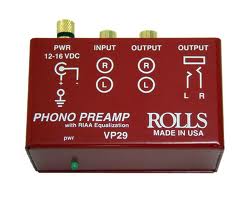 After a recent flood in my home and studio, I was left without my beloved phono stages. (And everything else for that matter) Nothing will tug at the heart of an audiophile more than seeing his lovingly cared for and extensively tweaked gear soaked. I literally cried when I saw water pouring from every hole and button on each and every prized heirlooms. I guess you could say I cried a river and then some. So that brings us to what to do about getting some music back into the air around these parts! Time to break out the soldering iron, a new test rig and get to work I guess!
After a recent flood in my home and studio, I was left without my beloved phono stages. (And everything else for that matter) Nothing will tug at the heart of an audiophile more than seeing his lovingly cared for and extensively tweaked gear soaked. I literally cried when I saw water pouring from every hole and button on each and every prized heirlooms. I guess you could say I cried a river and then some. So that brings us to what to do about getting some music back into the air around these parts! Time to break out the soldering iron, a new test rig and get to work I guess!
So, I managed to bring a few components back to life. At least enough to start reviewing gear and music! You see, we often forget how special one component was when it is replaced by some newfangled gadget with more lights and dinging bells than its predecessor. When you are hit with a disaster, it often forces you to take another look at the gear that brought you so much pleasure in the past. (At least until the insurance company and lawyers pull it together and replace your stuff!!!) I have certainly gained a new appreciation for the old greats again. I’ll most definitely post reviews on some of the other equipment I pulled out of moth balls recently. All relevant to where HI-END audio has been and where it is now.
For now though, let’s get started with this seemingly silly unit called the Rolls VP29 Phono Preamp. Lacking a phono stage and the patience to build a new one at the moment, I decided to make a run down to a local pro audio shop about a block from here. I always see this little red box hanging on a peg and was looking for the excuse to try it out some day. That someday came! The shop that sold me the unit mostly supplies them to DJs in order to add a third or fourth turntable to their setups. Naturally, I figured it was of little quality and geared toward that “LO-FI” DJ sound. We shall see then. Upon first opening the box I noticed it was a terrible packing job. The kind you would relate more to a tool in a hardware store, then to a piece of audio equipment. You know that plastic crap that is impossible to open without a fat set of sheers? The kind of packaging that sends you to the hospital with lacerations if you accidentally slip while extracting the product. Not cool. Furthermore, the unit was snuggled in a bed of open cell foam that does little to protect it from the rigors of shipping and being dropped by stockers. I think they should take a closer look at this in the future. I have seen cheap dime store CD players packed better than this.
What IS nice is how coolio/retro the designer made this unit appear. You could sense how the designer’s utilitarian leaning ideas were implemented into making this a very unique unit. I especially liked the straight forward and no frills circuit layout of the output device. The vp29 is a solid state phono preamp for use with moving-magnet and high output moving-coil cartridges. The vp29 is designed to amplify an RIAA equalized phono signal to a hi-level signal. It’s cheap cheerful and manufactured in the US. Inside and out, that about sums it up. What makes it unique is just that. There’s nothing to it!
After careful setup it was time to see how this unit sings. One of my favorite recordings is the tried and true Miles Davis Kind Of Blue. I have several pressings of this album and know exactly what each one should sound like. The first one I used was the recent re-release by Sony Records on 180 gram vinyl. There's something special about the way this music's air was picked up so well all the way back in 1959. On a great system, you can hear into the room so well you could swear you are SEEING the flickering light on the ceiling. Although the microphones were primitive, they just worked. The placement of the instruments in the room is superb, even for modern standards. A properly set up and tuned system can image this recording to a spooky degree. This aspect of the recording and how it was recorded is what makes some systems sound great, or go home crying for mommy. Especially the way the John Coltrane’s tenor sax reaches. Only one example of what really sets this recording apart.
Upon careful audition it was easy to tell how the VP29 really imaged and could keep a good pace. Even a close friend, was astonished how well a $75.00 unit could do this! It was only when my friend and I turned the volume up did we notice that the soundstages became too overly emphasized. It was as though some kind of cheap bra made the stage bits too; well let’s just say “lumpy” for our taste. If my friend and I agree on anything, it’s that we both prefer the more “natural” and “structurally sound” variety. It was time to see if this unit could really jam. Reaching into my vinyl stash I grabbed the most awesome recording of Tool-Lateralus. Now this is music to grind to! In the middle of the recording I began to feel a bit dirty, which made me want to shower with a steel file. This may be due to the poor quality capacitors used in the power supply. It’s a small wall wart with an attached power cord the size of dental floss. For what it is though, man, can this thing rock! MAN-O-MAN, even my cat “Bob” started to cough up fur balls as the music was playing. It was at this time I realized the music was way too heavy to get a real read on this little phono “Tool”. Man I love this album!!!
After a good bit of music it was time to really get things cookin'. So I took out my favorite live recordings of everything I could pull from the racks and sunk into my listening chair with a hot tea. Gotta tell ya, live recordings surely can't be beat. Over the next few days, everything from Rush to Tony Bennet was in constant rotation. From Roy Orbison to Dead Can Dance, each vinyl sounded better than the last! Listening to all of them, it was as if the live recordings of these great sessions began to come alive. Some even real and not recorded at all. In fact they were so real that I listened to it again and again. Perhaps that crappy power supply was getting burned in, or the circuit itself was settling somehow.Getting a good handle on how this unit reproduced music was really easy. At the same time it was frustrating the hell out of me. Since I have regularly attended live concerts and shows like Prince, BB King, Boogie, JP Smoke Train, Rush, Etc. and soon the Honolulu Orchestra, (finally back from the dead) my ears have been tuned to the real thing. Sometimes it gets depressing after hearing a great concert by Dave Mathews, then going home and listening to my music reproduction system. Actually, I’m kidding, I have a ridiculously tuned system and often prefer it to the drunken sound guy behind the boards at the show. Though with this little red yummy in my system the music really is believable!
So, after spending a long time with this piece I can confidently say it's among one of those few units that makes me feel happy and content. Don’t get me wrong though. Let me be clear. This is NOT what I would call the HI-END. This unit will never compete with the other units my ears have become accustomed to. It was simply not designed to plumb the depths like a Parasound Halo JC3. Nor will it resolve the delicacy of the upper limits of the Fosgate Signature Phono Preamp I loved so dearly. What it will do is something we so easily forget. Play music with no sonic artifacts of its own to speak of. It simply passes signal from turntable to preamp. It is only as good as what it is fed from your cartridge. Put a crap deck in front of it and crap is what you will get out the back. In this case, I noticed that although you will never be able to make out what the voices in the background on Jazz at the Pawn Shop, what I did get was a lively and robust “LIVE” sound from the unit. A happy sound if you will. Like the sound of your first HI-FI. The one you mowed 40 lawns all summer back in high school for. That’s a good thing in my book.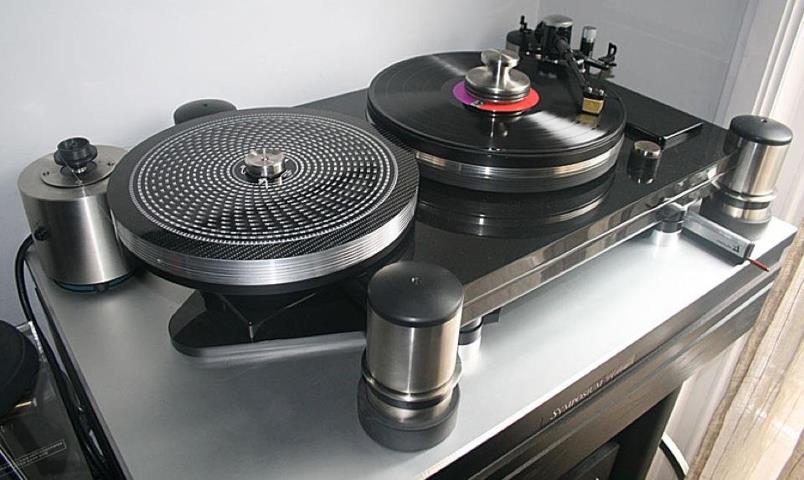 Highly recommend as a back-up piece, or just for some nostalgic sounds. I rate it in my Recommended Components list in class “C”. I'm keeping the review sample! For the price of dinner at Roy’s, who wouldn’t?
Highly recommend as a back-up piece, or just for some nostalgic sounds. I rate it in my Recommended Components list in class “C”. I'm keeping the review sample! For the price of dinner at Roy’s, who wouldn’t?
“Keep your records clean Ya’ll”! JWM
Specifications: Rolls VP29 Phono preamp I/O Connectors: RCA, ¼” TRS Stereo Input Sensitivity: 35 dB gain Input Capacitance: 5pf + cable capacitance Input Impedance: 50k Ohms Output Impedance: 1 Ohms Max Output Level: >10dB @ 1kHz at .1% dist. Equalization: RIAA +/- 1.5 dB, 20Hz to 20kHz THD .02% @ 1KHz S/N Ratio: >80 dB unweighted PWR: 12 - 18 VDC Size: W3.25 x H1.5 x D2 in. Weight: 1 lb. Indicator: 1 Power LED
Associated equipment: Analog: JWM Designs LLC MAG-lv/VPI/Rega/SL-1200/Funkfirm/SME Turntable (Custom built) Shelter 201, Ortofon 2M Red and 2M Blue, Shure 97XE phono cartages Hitachi FT-2 Tuner (Custom modified JWM Designs LLC) Digital: Oppo HD 980H, HP dv7-4183cl Notebook (extensively modified JWM Designs LLC) Amplification: Musical Fidelity XA-1 (Custom modified JWM Designs LLC) Mcintosh MC2105 and MC2125 amplifiers (Custom modified JWM Designs LLC) Sound Craftsman DC2215 Differential/Comparator Equalizer Speakers: Klipsch Cornwall II (Custom built)Front Klipsch Tangent T50 (Custom built) Rear JWM Designs LLC JMSW12 Servo driven subwoofers (X-2) Each with 1,340 watt custom built HYPEX digital amplifiers Cables: Audio Quest Columbia and Colorado interconnects Kimber Kable 12HT speaker cables Audio Quest NRG-4 IEC power cables Dedicated 200A power source from mains panel feeding PS Audio Power Port Classics 20A 1 box of TAZO Earl Grey Tea!
Summer art!!!!
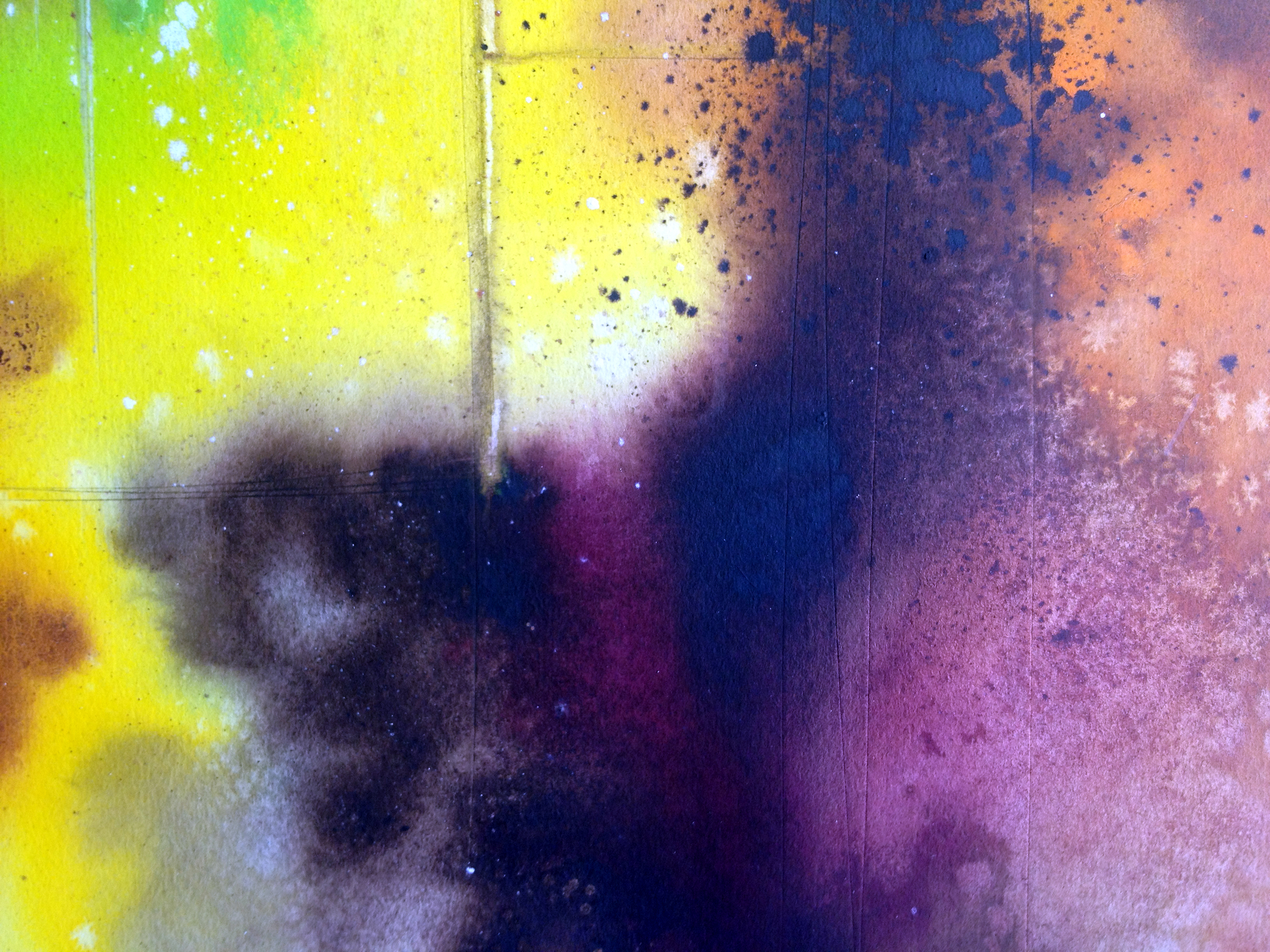 Well, it’s that time again. Summer is upon us. Time to put away the hammer and saw, dust off the paints and stretch some canvas!
Well, it’s that time again. Summer is upon us. Time to put away the hammer and saw, dust off the paints and stretch some canvas!
 Those who know me well, see that summer is my time to create. When I thrive! The best works I’ve ever done were created in this time. For me, summers is the time for sloughing off the energy robbing vampires of the rainy season and seek out those truly intellectually and creatively stimulating individuals. A time to greet the sun with early morning walks at the tide pools. Taking the colors we saw in the rain forests of winter and mix them with the morning sun of the season. When the flowers and mountain apples are a plenty and the warm feeling of a perfect wave spawn the next painting. Sunday morning brunch with egg’s benny and a mimosa. White shirts and a north shore polo match. The smell of fresh Sex Wax on a hot long board. Summer is for love of the world around us and the ones open enough in there heart to feel it. BRING IT ON!!!!
Those who know me well, see that summer is my time to create. When I thrive! The best works I’ve ever done were created in this time. For me, summers is the time for sloughing off the energy robbing vampires of the rainy season and seek out those truly intellectually and creatively stimulating individuals. A time to greet the sun with early morning walks at the tide pools. Taking the colors we saw in the rain forests of winter and mix them with the morning sun of the season. When the flowers and mountain apples are a plenty and the warm feeling of a perfect wave spawn the next painting. Sunday morning brunch with egg’s benny and a mimosa. White shirts and a north shore polo match. The smell of fresh Sex Wax on a hot long board. Summer is for love of the world around us and the ones open enough in there heart to feel it. BRING IT ON!!!!
 Where to begin? Rite here! I just finished a huge project that took many months of time and energy. The results are fabulous. Also plenty of fresh studio space ready to be filled with colorful memories. After all, that’s what our creations really are! Memories captured in time. We take all those colors, shapes and faces and words and everything and solidify them into the work, as a marker in eternity. Some are happy, some are angry. Some are sunny, some are dark. All legitimate though. All are relevant! All will speak volumes…
Where to begin? Rite here! I just finished a huge project that took many months of time and energy. The results are fabulous. Also plenty of fresh studio space ready to be filled with colorful memories. After all, that’s what our creations really are! Memories captured in time. We take all those colors, shapes and faces and words and everything and solidify them into the work, as a marker in eternity. Some are happy, some are angry. Some are sunny, some are dark. All legitimate though. All are relevant! All will speak volumes…
 So, what is on the palette this summer? MIXED MEDIA!!! A revival of something old and a touch of something new. First will be a series I began years ago that I never was able to bring to fruition. A combination of photography, printmaking, oil, ceramic glazes, acrylic, melted rubber and dyed textile art. Yes boys and girls, textile exotic fabric. I messed around with this on the side all threw school, as well as at the South West School of Arts and Crafts. While teaching in the sculpture department I used to sneak over to the fabrics girl for some inspiration. After the prep was done, that same fabric was taken over to the photo department to be silver dyed. This enabled me to expose images directly into the fabric itself. That was only the beginning though. Some were stretched and the real fun began. Well, without revealing too much of the proses to you, let’s just say, I’m excited as hell!!! Time to put on the lab coat and get back to creating something amazing!!! (I’m glowing!) YES!!!
So, what is on the palette this summer? MIXED MEDIA!!! A revival of something old and a touch of something new. First will be a series I began years ago that I never was able to bring to fruition. A combination of photography, printmaking, oil, ceramic glazes, acrylic, melted rubber and dyed textile art. Yes boys and girls, textile exotic fabric. I messed around with this on the side all threw school, as well as at the South West School of Arts and Crafts. While teaching in the sculpture department I used to sneak over to the fabrics girl for some inspiration. After the prep was done, that same fabric was taken over to the photo department to be silver dyed. This enabled me to expose images directly into the fabric itself. That was only the beginning though. Some were stretched and the real fun began. Well, without revealing too much of the proses to you, let’s just say, I’m excited as hell!!! Time to put on the lab coat and get back to creating something amazing!!! (I’m glowing!) YES!!!
 The second series of the summer of 0-12, will have to be a surprise. I don’t want to get closure on the work before I even begin. I find too much talk before the process gets rolling, tends to lower the inspiration level a bit too low for me. So keep your shorts on! Patience grasshoppers. Patience…
The second series of the summer of 0-12, will have to be a surprise. I don’t want to get closure on the work before I even begin. I find too much talk before the process gets rolling, tends to lower the inspiration level a bit too low for me. So keep your shorts on! Patience grasshoppers. Patience…
 OK then, that’s all I wanted to say for now. I’m just excited and had to tell someone. I hope all of you have the same glow about summer as I do. I also hope you all get out there and experience the world. Suck up some inspiration! It’s all around you. It’s rite in front of you. Can you see it? It sees you. Now reach out to it and let it play inside your heart.
OK then, that’s all I wanted to say for now. I’m just excited and had to tell someone. I hope all of you have the same glow about summer as I do. I also hope you all get out there and experience the world. Suck up some inspiration! It’s all around you. It’s rite in front of you. Can you see it? It sees you. Now reach out to it and let it play inside your heart.

You won’t regret it...
Happy creating!
Do you remember that song?!?!?
 It never ceases to amaze me how drawn to music we humans are. What is it about this structured combination of sounds that can have such a powerful influence over not only individuals, but entire cultures? The human brain, as well as most living creatures, evolved to detect sounds as a survival tool. Now, that same tool is used for detecting and comprehending scale and structure of all types of music! From a simple ring tone to a large scale symphony, then find the meaning and beauty that lies within the piece. Why?
It never ceases to amaze me how drawn to music we humans are. What is it about this structured combination of sounds that can have such a powerful influence over not only individuals, but entire cultures? The human brain, as well as most living creatures, evolved to detect sounds as a survival tool. Now, that same tool is used for detecting and comprehending scale and structure of all types of music! From a simple ring tone to a large scale symphony, then find the meaning and beauty that lies within the piece. Why?

6 months ago, I came across an LP I had not even thought about in 20 years. No, make that 25. After taking a quick look at the liner notes and cover, I sat back for a listen. Before the first note hit my ears, I could remember the style and instrumentation, yet not the melodies and solos. After listening to the entire LP, something extraordinary happened. Later that day, and every day since listening to the album, I could “hear” the entire record in my mind, virtually note for note! When I say note for note, I really mean it. Complete and total recall of every aspect of the music, including drum fills, bass licks, phrasing in the solos, as though the last 25 years were suddenly erased. Simply hearing this record again unlocked a memory that had been filed away in my brain nearly an adult lifetime ago. Why?
If you know anything about data and music you can understand just how much “data” 45 minutes of music represents. How much other important information about your life can you recall from 25 years ago? Why in God’s name would the human mind allocate the significant resources necessary to store this music for so long and in such intricate detail? Even more astonishing than the fact that the human mind could hold on to such detail in these combinations of sounds for 25 years is that it would. Why?
Let’s get scientific for a moment. From this perspective, every physical or intellectual function exacts a price in “overhead” for maintaining that function in terms of calorie intake and a myriad of other biological needs. So, any capability that does not directly contribute to the organism’s survival quickly disappears from the gene pool. Moreover, that saved brain capacity could be used for other functions that could more directly aid in survival. A simple example is we’re highly attuned to discriminating faces, understanding expressions on those faces, and remembering faces. The survival benefit in this is obvious. Being that said, what is it about music that is so important that our brain has developed a capacity to understand and remember it? Why?
At its heart, I believe music is communication, and communication is vital to any species that relies on social organization. We have examples of instruments that date back 43,000 years. Despite the rigors of Neanderthal life, our ancestors found time to create music. There are artifacts that show, not only did our ancestors create and play instruments, but they had then worked out the diatonic scales to a precise hole-spacing in a hollowed out bone. This hole-spacing corresponds perfectly to a contemporary diatonic flute. Moreover, that diatonic scale has been with us since the dawn of music suggests the basis for responding to certain musical intervals has been common to humans for eons. Ahhhh…
There are many authors and studies into the neurological effects of music. It is uncanny how the evolutionary biologists also come to many of the same conclusions why music matters so much. We are still a long way from completely understanding why we are such a musical species though. You should try a little experiment of your own. Grab a random LP out of the rack and take a close look. Try to hear what is on the piece before playing it. Next, play it in its entirety and just see if you get the same recall as I did. I found that the more I practice this, the better my mind taps into those dusty files and plays the memories more clearly. Much like a built in tape machine. Who needs a stinking IPod anyway? Save your money and buy a new needle for your deck. I guess until the smart guys in lab coats figure it all out, we will just have to look at our musical minds in wonder. Better yet, REMEMBER THAT MUSIC!!!!
PS. It was Styx-The Grand Illusion on the turntable. Love that record!
The best speaker you ever heard…
 About a year ago, I was asked by a fledgling Audiophile: “Josh! What is the best speaker out there today!?!” What? That’s like asking what your favorite cheese cake is! What is the “BEST” Ben and Jerries’? What is the “BEST” Ferrari? Better yet, who is the “BEST” Jazz band? I asked him, “If you had to choose between listening to Miles Davis Kind of Blue on a bed side Sony Dream Machine (circa 1982) on an AM station, who’s transmitter was 300 miles away, or A Flock of Seagulls on a dCS Debussy front end, followed by all Ayre’ gear, powering through a set of burned in YG Acoustics Anat III Pro towers, What would you choose?” You could cut through the silence on the other end of the line. “The answer Grass Hopper is the ones you are enjoying right now.”
About a year ago, I was asked by a fledgling Audiophile: “Josh! What is the best speaker out there today!?!” What? That’s like asking what your favorite cheese cake is! What is the “BEST” Ben and Jerries’? What is the “BEST” Ferrari? Better yet, who is the “BEST” Jazz band? I asked him, “If you had to choose between listening to Miles Davis Kind of Blue on a bed side Sony Dream Machine (circa 1982) on an AM station, who’s transmitter was 300 miles away, or A Flock of Seagulls on a dCS Debussy front end, followed by all Ayre’ gear, powering through a set of burned in YG Acoustics Anat III Pro towers, What would you choose?” You could cut through the silence on the other end of the line. “The answer Grass Hopper is the ones you are enjoying right now.”
The point is this: There are so many machines out there. They come in all shapes and sizes. These days, they also come in every color of the rainbow and more. Do you want the cutting edge of a tweeter that has such a high frequency reach that you could open your garage door with it? Perhaps you are looking for the subtle glow of the silk dome. Mid bass punch? Perhaps a more delicate kiss with the tweeter is more you style. Sub terrainian reach from a set of fat subs? For me, I prefer the “NON-SUB” approach from my subs. If I can hear them, they be too loud and simply are not natural. Horns? Planers? Domes? Paper or carbon fiber? MDF or aluminum? Let’s not forget Beryllium! (Anyone out there had a chance to hear those diamond inverted domes in the Avalon Isis?) You get the idea. All are the “BEST”, for what they were designed to do. All were designed by someone. All have what that someone thought was closer to the actual performance in a given listening environment.
Yes, we crazy audiophiles are always looking for Nirvana. We spend hours upon hours searching out the gear that gets us closer to, well, “THERE”! We want to experience that performance in our own home. Yes! That’s it! “THE PERFORMANCE”! This is all about the performance. If you don’t love music, what is the point? We love music with such a passion; we try to hear more of it. We strive for that “LIVE” sound we heard at the concert last night. We want to hear the woman in the 13th row with the sniffles. It brings the performance texture and a sense of realism. We want to hear the soft pop and tickle of dust on the record. It makes it sound like there is a woman in the 13th row with the sniffles! Sounds strange to most, but this is what it is about. Live music. MUSIC!!!
So, back to my friend. We had a long discussion of this approach to audio. MUSIC! Being that this kid is half my age, he always thought good sound came from little silver discs, or more recently, bits streamed to an IPhone. Well, it was only recently that he discovered those bits BYTE! I can’t tell you the joy in my heart when he said all his recordings sounded compressed and dull after getting a taste of the 180 gram pressing of Tool-Lateralus. (Which should be in every audiophile’s, err, tool kit) ”Hallelujah!” Not only that, he heard it on a $350.00 second hand Techniques SL-1200 fitted with a Shelter MM cartridge, (roughly $175.00) Bellari tube phono pre-amp, ($250.00) Musical Fidelity X-A1 ($400.00) and a pair of Silverline Minuet Supreme speakers ($600.00) I think the cables were Audio Quest. His excitement was through the roof, so I couldn’t make out what he was saying to well. This was a guy who actually thought you needed to spend 100K on a system to run an IPod packed full of compressed crap to move the soul. (For-mentioned system would set you back a cool 380K) Nope!
I made these suggestions to him, for I knew he was on a budget. Also, I have heard, and own some of the same gear. I just knew through experience, they would sound good together. When you submit to this thing called “Audiophilia”, you will understand, all gear has a sonic signature. The trick of approaching “Nirvana” is to create a synergy between all the components own characteristics and build that “LIVE” experience. As for my friend’s system, sure nuff! I also know what he likes to listen to in his tiny little room he rents in Makiki. When you are sleeping, eating, studying, dating, and whatever else in the same 12x12 space, there is no need for a huge set of Wilson Alexandria XLF, or even a sub for that matter. The system fits the space and the “MUSIC” the owner loves most. Simple…
A few months later, I asked my friend, “What is the best set of speakers you have ever heard”? After a long pause,,,,,,,, “mine!” he said.
Enjoy them my friend…
Associated Equipment:
Good Morning Ya'll!
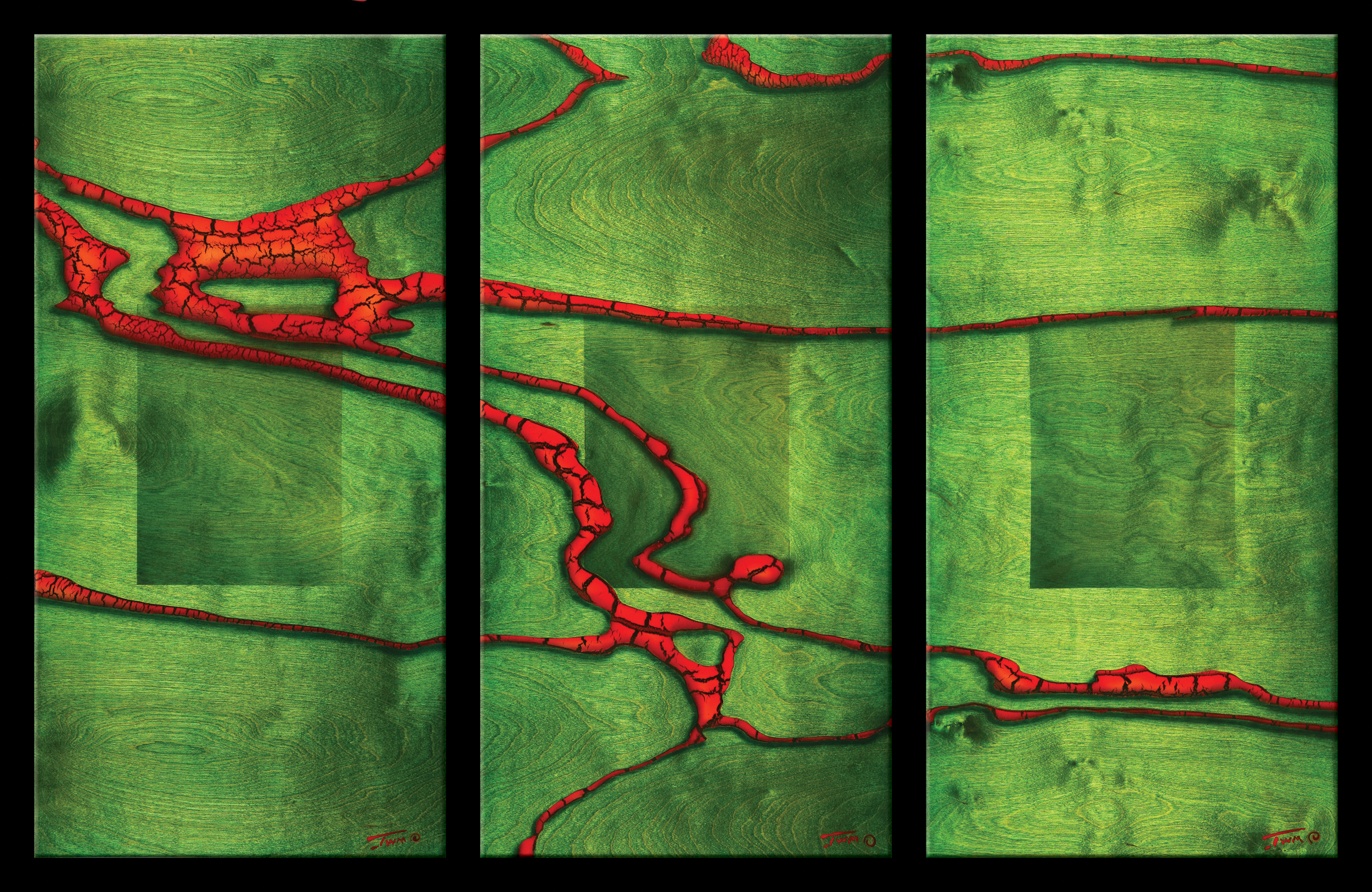 OK! Here we go!
Lets start this blog by saying WELCOME! The idea here is to share ideas. Ideas that have to do with all things ART!!! This can include paintings, music, the equipment you play it on and whatever else you can think of that gets you moving! Feel free to add photos of the systems that you have and why they are perfect for your lifestyle. It can be the boom box in the bathroom, or a full-blown HI-END sound reproduction system. It really doesn't matter. As long as it does what it is really supposed to do. That is play the music we love.
OK! Here we go!
Lets start this blog by saying WELCOME! The idea here is to share ideas. Ideas that have to do with all things ART!!! This can include paintings, music, the equipment you play it on and whatever else you can think of that gets you moving! Feel free to add photos of the systems that you have and why they are perfect for your lifestyle. It can be the boom box in the bathroom, or a full-blown HI-END sound reproduction system. It really doesn't matter. As long as it does what it is really supposed to do. That is play the music we love.
OH! that's another thing. Please post that music you are listening to and why! What is the painting you just saw in Waikiki that blew your mind? Where was that concert? Could you shoot us a picture? What about a link to that song? HEY!?! Do you have a favorite place to hear live music, or view beautiful creations in general?
If yes to any of these, well then! Lets get going!
PS. Anyone have a good ceviche recipe?
JWM
